Samsung Electronics Co SCX4200 Multi Function Printer User Manual 4200 EN
Samsung Electronics Co Ltd Multi Function Printer 4200 EN
Contents
- 1. Users Manual 1
- 2. Users Manual 2
Users Manual 1
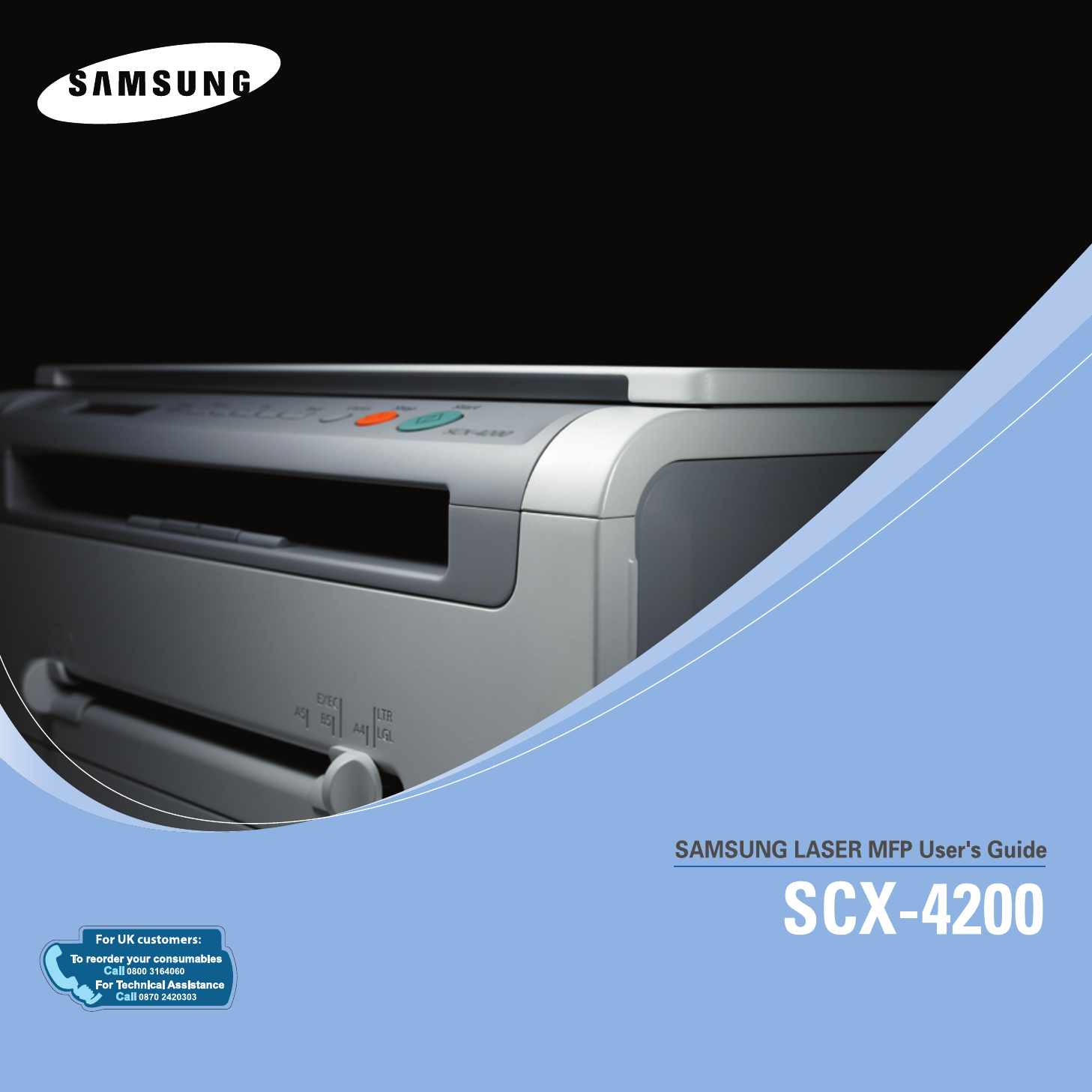
1
© 2005 Samsung Electronics Co., Ltd. All rights reserved.
This manual is provided for information purposes only. All information included herein is subject to change without notice. Samsung Electronics is not
responsible for any direct or indirect damages, arising from or related to use of this manual.
• SCX-4200 is model names of Samsung Electronics Co., Ltd.
• Samsung and Samsung logo are trademarks of Samsung Electronics Co., Ltd.
• IBM and IBM PC are trademarks of International Business Machines Corporation.
• PCL and PCL 6 are trademarks of Hewlett-Packard company.
• Microsoft, Windows, Windows 98, Windows Me, Windows 2000, and Windows XP are registered trademarks of Microsoft Corporation.
• TrueType, LaserWriter and Macintosh are trademarks of Apple Computer, Inc.
• All other brand or product names are trademarks of their respective companies or organizations.
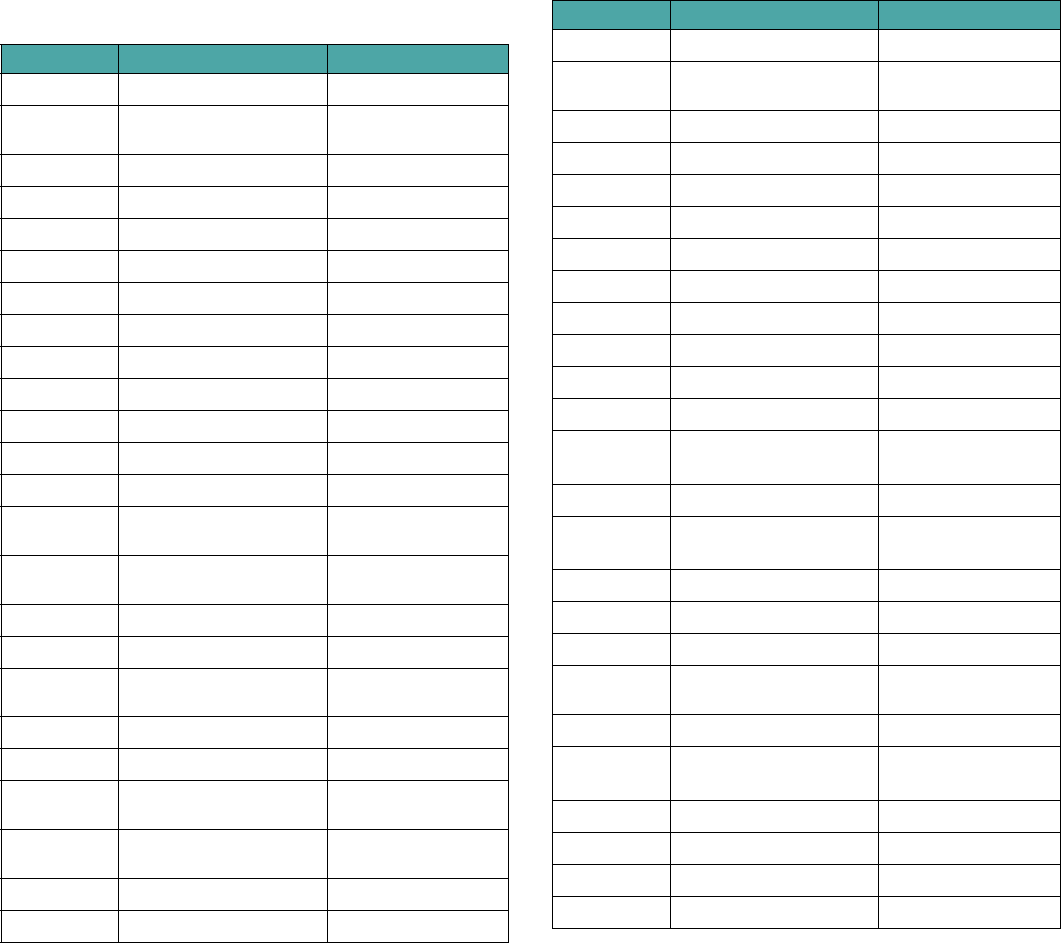
2
Contact SAMSUNG WORLD WIDE
If you have any comments or questions regarding Samsung products,
contact the SAMSUNG customer care center.
Country Customer Care Center Web Site
CANADA 1-800-SAMSUNG (7267864) www.samsung.com/ca
MEXICO 01-800-SAMSUNG
(7267864)
www.samsung.com/mx
U.S.A 1-800-SAMSUNG (7267864) www.samsung.com
ARGENTINE 0800-333-3733 www.samsung.com/ar
BRAZIL 0800-124-421 www.samsung.com/br
CHILE 800-726-7864 (SAMSUNG) www.samsung.com/cl
COSTA RICA 0-800-507-7267 www.samsung.com/latin
ECUADOR 1-800-10-7267 www.samsung.com/latin
EL SALVADOR 800-6225 www.samsung.com/latin
GUATEMALA 1-800-299-0013 www.samsung.com/latin
JAMAICA 1-800-234-7267 www.samsung.com/latin
PANAMA 800-7267 www.samsung.com/latin
PUERTO RICO 1-800-682-3180 www.samsung.com/latin
REP.
DOMINICA
1-800-751-2676 www.samsung.com/latin
TRINIDAD &
TOBAGO
1-800-7267-864 www.samsung.com/latin
VENEZUELA 1-800-100-5303 www.samsung.com/latin
BELGIUM 02 201 2418 www.samsung.com/be
CZECH
REPUBLIC
844 000 844 www.samsung.com/cz
DENMARK 38 322 887 www.samsung.com/dk
FINLAND 09 693 79 554 www.samsung.com/fi
FRANCE 08 25 08 65 65
(€ 0,15/min)
www.samsung.com/fr
GERMANY 01805 - 121213
(€ 0,12/min)
www.samsung.de
HUNGARY 06 40 985 985 www.samsung.com/hu
ITALIA 199 153 153 www.samsung.com/it
LUXEMBURG 02 261 03 710 www.samsung.lu
NETHERLANDS
0900 20 200 88
(€ 0.10/min)
www.samsung.com/nl
NORWAY 231 627 22 www.samsung.com/no
POLAND 0 801 801 881 www.samsung.com/pl
PORTUGAL 80 8 200 128 www.samsung.com/pt
SLOVAKIA 0850 123 989 www.samsung.com/sk
SPAIN 902 10 11 30 www.samsung.com/es
SWEDEN 08 585 367 87 www.samsung.com/se
U.K 0870 242 0303 www.samsung.com/uk
RUSSIA 8-800-200-0400 www.samsung.ru
UKRAINE 8-800-502-0000 www.samsung.com/ur
AUSTRALIA 1300 362 603 www.samsung.com/au
CHINA 800-810-5858
010- 6475 1880
www.samsung.com.cn
HONG KONG 2862 6001 www.samsung.com/hk
INDIA 3030 8282
1600 1100 11
www.samsung.com/in
INDONESIA 0800-112-8888 www.samsung.com/id
JAPAN 0120-327-527 www.samsung.com/jp
MALAYSIA 1800-88-9999 www.samsung.com/my
PHILIPPINES 1800-10-SAMSUNG
(7267864)
www.samsung.com/ph
SINGAPORE 1800-SAMSUNG (7267864) www.samsung.com/sg
THAILAND 1800-29-3232
02-689-3232
www.samsung.com/th
TAIWAN 0800-329-999 www.samsung.com/tw
VIETNAM 1 800 588 889 www.samsung.com/vn
SOUTH AFRICA 0860 7267864 (SAMSUNG) www.samsung.com/za
U.A.E 800SAMSUNG (7267864) www.samsung.com/mea
Country Customer Care Center Web Site
3
CONTENTS
1. Introduction
Special features ..................................................................................................................... 1.1
Understanding component locations .......................................................................................... 1.2
2. Getting started
Setting up your machine
Finding more information ........................................................................................................ 2.1
Selecting a location ................................................................................................................ 2.2
Installing the toner cartridge ................................................................................................... 2.2
Loading paper ....................................................................................................................... 2.3
Making connections ................................................................................................................ 2.5
Turning the machine on .......................................................................................................... 2.5
Setting up the machine system
Overview of control panel menus ............................................................................................. 2.6
Changing the display language ................................................................................................. 2.6
Using the save modes ............................................................................................................. 2.6
Printer software overview
Supplied printer software ........................................................................................................ 2.7
Printer driver features ............................................................................................................. 2.7
System requirements ............................................................................................................. 2.8
3. Loading original documents and paper
Loading document .................................................................................................................. 3.1
Selecting print materials ......................................................................................................... 3.2
Loading paper ....................................................................................................................... 3.5
Setting the paper size and type ................................................................................................ 3.6
Selecting an output location .................................................................................................... 3.6
4. Copying
Copying ................................................................................................................................ 4.1
Changing the settings for each copy ......................................................................................... 4.1
Changing the default settings .................................................................................................. 4.2
Using special copy features ..................................................................................................... 4.2
Setting the time out option ...................................................................................................... 4.3
5. Basic printing
Printing a document ............................................................................................................... 5.1
Canceling a print job .............................................................................................................. 5.1
6. Scanning
Scanning basics ..................................................................................................................... 6.1
7. Ordering toner cartridge
Toner cartridges .................................................................................................................... 7.1
How to purchase .................................................................................................................... 7.1
4
8. Maintenance
Printing reports ...................................................................................................................... 8.1
Clearing memory ................................................................................................................... 8.1
Cleaning your machine ........................................................................................................... 8.1
Maintaining the toner cartridge ................................................................................................ 8.3
Consumable and replacement parts .......................................................................................... 8.5
9. Troubleshooting
Clearing paper jams ............................................................................................................... 9.1
Understanding the Status LED ................................................................................................. 9.3
Understanding display messages .............................................................................................. 9.4
Solving other problems ........................................................................................................... 9.4
10. Specifications
General specifications ........................................................................................................... 10.1
Scanner and copier specifications ........................................................................................... 10.1
Printer specifications ............................................................................................................ 10.2
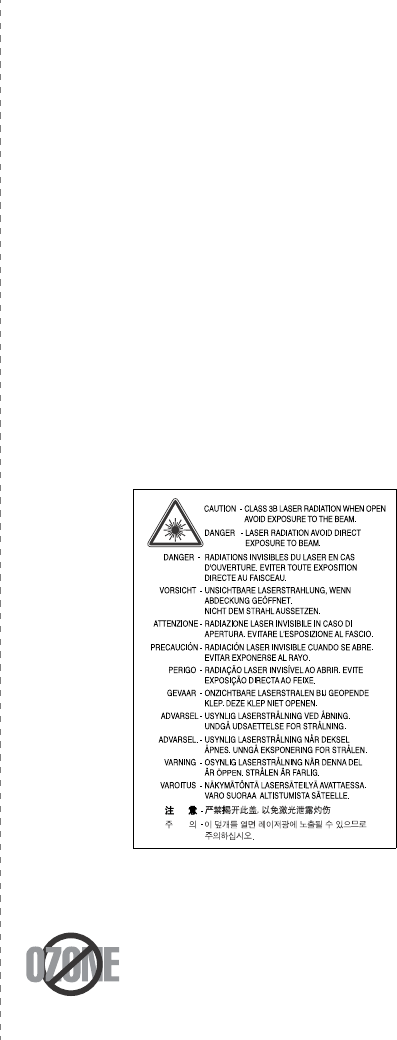
5
Important Precautions and Safety Information
When using this machine, these basic safety precautions should always be
followed to reduce risk of fire, electric shock and injury to people:
1. Read and understand all instructions.
2. Use common sense whenever operating electrical appliances.
3. Follow all warnings and instructions marked on the machine and in the
literature accompanying the machine.
4. If an operating instruction appears to conflict with safety information,
heed the safety information. You may have misunderstood the operating
instruction. If you cannot resolve the conflict, contact your sales or
service representative for assistance.
5. Unplug the machine from the AC wall socket and/or telephone jack
before cleaning. Do not use liquid or aerosol cleaners. Use only a damp
cloth for cleaning.
6. Do not place the machine on an unstable cart, stand or table. It may fall,
causing serious damage.
7. Your machine should never be placed on, near or over a radiator, heater,
air conditioner or ventilation duct.
8. Do not allow anything to rest on the power. Do not locate your machine
where the cords will be abused by persons walking on them.
9. Do not overload wall outlets and extension cords. This can diminish
performance, and may result in the risk of fire or electric shock.
10. Do not allow pets to chew on the AC power, telephone or PC interface
cords.
11. Never push objects of any kind into the machine through case or cabinet
openings. They may touch dangerous voltage points, creating a risk of
fire or shock. Never spill liquid of any kind onto or into the machine.
12. Your machine may have a heavy cover for optimal pressure on the
document for the best scanning and/or faxing (usually the flatbed-type
machine). In this case, replace the cover after placing document on the
scan glass, by holding and moving it down slowly until it seats on its
location.
13. To reduce the risk of electric shock, do not disassemble the machine.
Take it to a qualified service technician when repair work is required.
Opening or removing covers may expose you to dangerous voltages or
other risks. Incorrect reassembly could cause electric shock when the
unit is subsequently used.
14. Unplug the machine from the telephone jack, PC and AC wall outlet and
refer servicing to qualified service personnel under the following
conditions:
•When any part of the power cord, plug or connecting cable is damaged
or frayed.
•If liquid has been spilled into the machine.
•If the machine has been exposed to rain or water.
•If the machine does not operate properly after instructions have been
followed.
•If the machine has been dropped, or the cabinet appears damaged.
•If the machine exhibits a sudden and distinct change in performance.
15. Adjust only those controls covered by the operating instructions.
Improper adjustment of other controls may result in damage, and may
require extensive work by a qualified service technician to restore the
machine to normal operation.
16. Avoid using this machine during a lightning storm. There may be a
remote risk of electric shock from lightning. If possible, unplug the AC
power and telephone cord for the duration of the lightning storm.
17. SAVE THESE INSTRUCTIONS.
18. Use only No.26 AWG or larger telephone line cord.
Laser Safety Statement
The printer is certified in the U.S. to conform to the requirements of DHHS
21 CFR, chapter 1 Subchapter J for Class I(1) laser products, and elsewhere
is certified as a Class I laser product conforming to the requirements of IEC
825.
Class I laser products are not considered to be hazardous. The laser system
and printer are designed so there is never any human access to laser
radiation above a Class I level during normal operation, user maintenance or
prescribed service condition.
WARNING
Never operate or service the printer with the protective cover removed from
Laser/Scanner assembly. The reflected beam, although invisible, can
damage your eyes.
Ozone Safety
During normal operation, this machine produces ozone.
The ozone produced does not present a hazard to the
operator. However, it is advisable that the machine be
operated in a well ventilated area.
If you need additional information about ozone, please
request your nearest Samsung dealer.
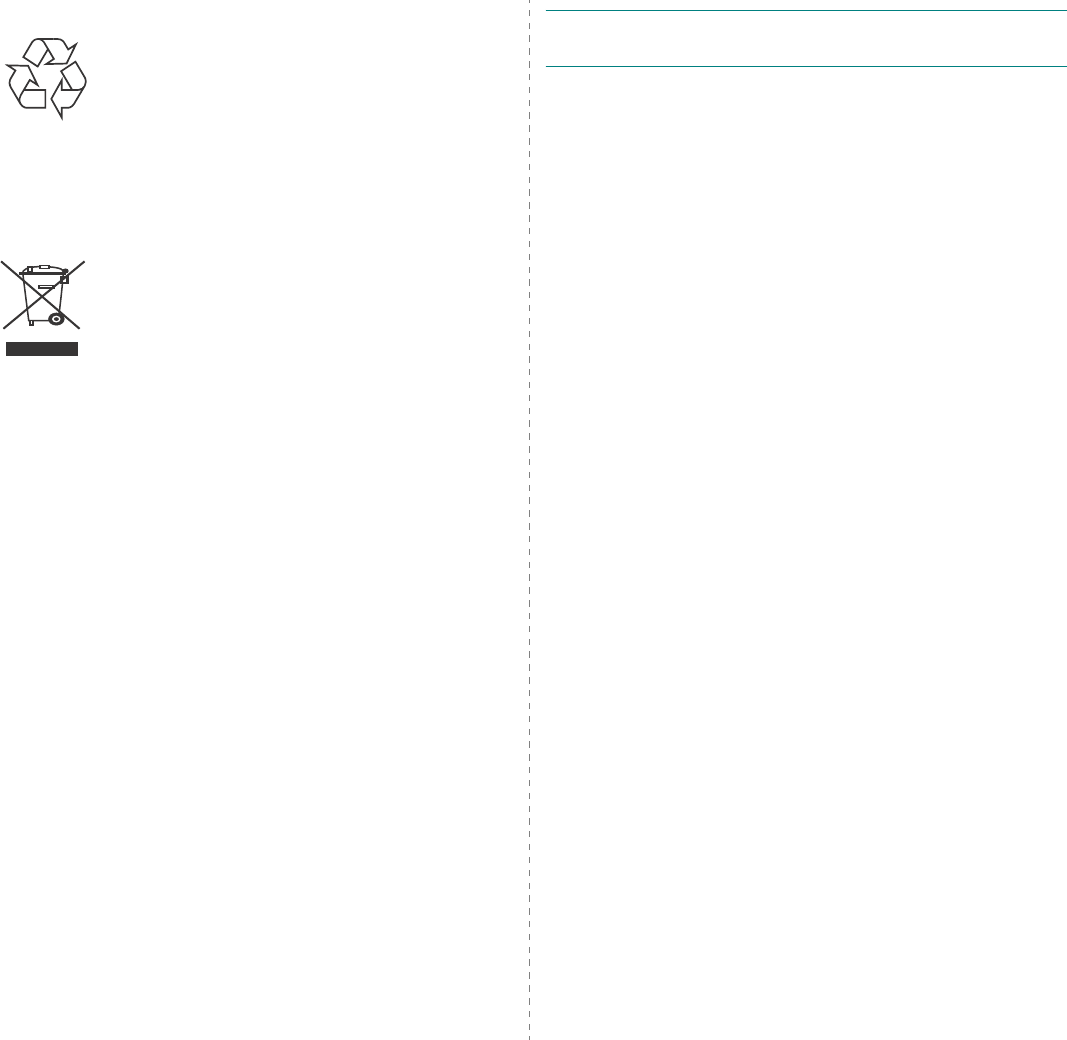
6
Recycling
Please recycle or dispose of the packaging material for this
product in an environmentally responsible manner.
Correct Disposal of This Product (Waste
Electrical & Electronic Equipment)
(Applicable in the European Union and other European
countries with separate collection systems)
This marking shown on the product or its literature, indicates
that it should not be disposed with other household wastes
at the end of its working life. To prevent possible harm to
the environment or human health from uncontrolled waste
disposal, please separate this from other types of wastes and
recycle it responsibly to promote the sustainable reuse of
material resources.
Household users should contact either the retailer where they purchased this
product, or their local government office, for details of where and how they
can take this item for environmentally safe recycling.
Business users should contact their supplier and check the terms and
conditions of the purchase contract. This product should not be mixed with
other commercial wastes for disposal.
Radio Frequency Emissions
FCC Information to the User
This device complies with Part 15 of the FCC Rules. Operation is subject to
the following two conditions:
•This device may not cause harmful interference, and
•This device must accept any interference received, including
interference that may cause undesired operation.
This equipment has been tested and found to comply with the limits for a
Class B digital device, pursuant to Part 15 of the FCC Rules. These limits are
designed to provide reasonable protection against harmful interference in a
residential installation. This equipment generates, uses and can radiate radio
frequency energy and, if not installed and used in accordance with the
instructions, may cause harmful interference to radio communications.
However, there is no guarantee that interference will not occur in a particular
installation. If this equipment does cause harmful interference to radio or
television reception, which can be determined by turning the equipment off
and on, the user is encouraged to try to correct the interference by one or
more of the following measures:
•Reorient or relocate the receiving antenna.
•Increase the separation between the equipment and receiver.
•Connect the equipment into an outlet on a circuit different from that to
which the receiver is connected.
•Consult the dealer or experienced radio TV technician for help.
C
AUTION
:
Change or modifications not expressly approved by the
manufacturer responsible for compliance could void the user's authority to
operate the equipment.
Canadian Radio Interference Regulations
This digital apparatus does not exceed the Class B limits for radio noise
emissions from digital apparatus as set out in the interference-causing
equipment standard entitled “Digital Apparatus”, ICES-003 of the Industry
and Science Canada.
Cet appareil numérique respecte les limites de bruits radioélectriques
applicables aux appareils numériques de Classe B prescrites dans la norme
sur le matériel brouilleur: “Appareils Numériques”, ICES-003 édictée par
l’Industrie et Sciences Canada.
Fax Branding
The Telephone Consumer Protection Act of 1991 makes it unlawful for any
person to use a computer or other electronic device to send any message via
a telephone facsimile machine unless such message clearly contains in a
margin at the top or bottom of each transmitted page or on the first page of
the transmission the following information:
(1) the date and time of transmission
(2) identification of either business, business entity or individual sending the
message; and
(3) telephone number of either the sending machine, business, business
entity or individual.
The Telephone Company may make changes in its communications facilities,
equipment operations or procedures where such action is reasonably
required in the operation of its business and is not inconsistent with the rules
and regulations in FCC Part 68. If such changes can be reasonably expected
to render any customer terminal equipment incompatible with telephone
company communications facilities, or require modification or alteration of
such terminal equipment, or otherwise materially affect its use or
performance, the customer shall be given adequate notice in writing, to allow
the customer an opportunity to maintain uninterrupted service.
Ringer Equivalence Number
The Ringer Equivalence Number and FCC Registration Number for this
machine may be found on the label located on the bottom or rear of the
machine. In some instances you may need to provide these numbers to the
telephone company.
The Ringer Equivalence Number (REN) is a measure of the electrical load
placed on the telephone line, and is useful for determining whether you have
“overloaded” the line. Installing several types of equipment on the same
telephone line may result in problems making and receiving telephone calls,
especially ringing when your line is called. The sum of all Ringer Equivalence
Numbers of the equipment on your telephone line should be less than five in
order to assure proper service from the telephone company. In some cases,
a sum of five may not be usable on your line. If any of your telephone
equipment is not operating properly, you should immediately remove it from
your telephone line, as it may cause harm to the telephone network.
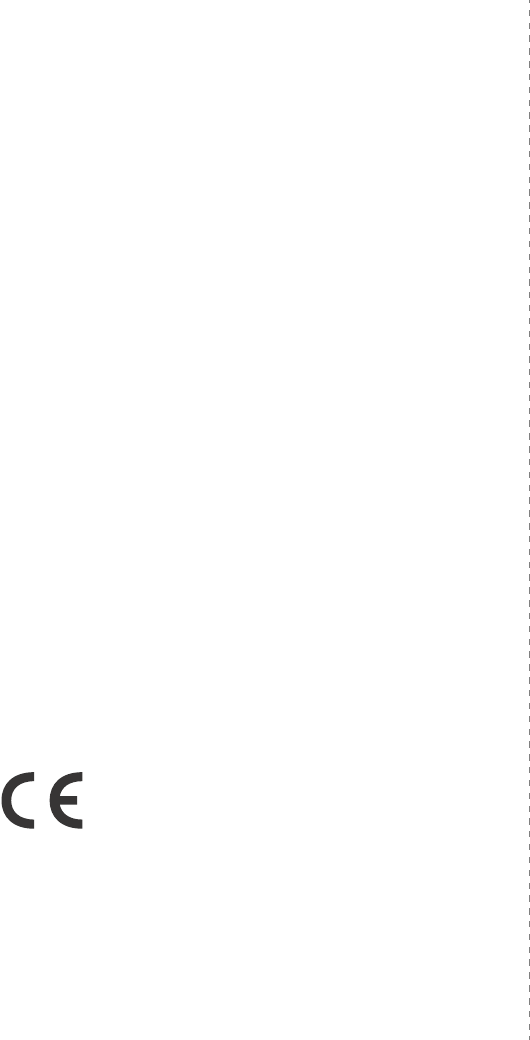
7
WARNING:
FCC Regulations state that changes or modifications to this equipment not
expressly approved by the manufacturer could void the user’s authority to
operate this equipment. In the event that terminal equipment causes harm
to the telephone network, the telephone company should notify the customer
that service may be stopped. However, where prior notice is impractical, the
company may temporarily cease service, providing that they:
a) promptly notify the customer.
b) give the customer an opportunity to correct the equipment problem.
c) inform the customer of the right to bring a complaint to the Federal
Communication Commission pursuant to procedures set out in FCC Rules and
Regulations Subpart E of Part 68.
You should also know that:
• Your machine is not designed to be connected to a digital PBX system.
• If you intend to use a computer modem or fax modem on the same phone
line as your machine, you may experience transmission and reception
problems with all the equipment. It is recommended that no other
equipment, except for a regular telephone, share the line with your
machine.
• If your area experiences a high incidence of lightning or power surges, we
recommend that you install surge protectors for both the power and the
telephone lines. Surge protectors can be purchased from your dealer or
telephone and electronic specialty stores.
• When programming emergency numbers and/or making test calls to
emergency numbers, use a non-emergency number to advise the
emergency service dispatcher of your intentions. The dispatcher will give
you further instructions on how to actually test the emergency number.
• This machine may not be used on coin service or party lines.
• This machine provides magnetic coupling to hearing aids.
• You may safely connect this equipment to the telephone network by
means of a standard modular jack, USOC RJ-11C.
Declaration of Conformity (European
Countries)
Approvals and Certifications
The CE marking applied to this product symbolizes Samsung
Electronics Co., Ltd. Declaration of Conformity with the
following applicable 93/68/EEC Directives of the European
Union as of the dates indicated:
January 1, 1995
: Council Directive 73/23/EEC Approximation of the laws
of the member states related to low voltage equipment.
January 1, 1996
: Council Directive 89/336/EEC (92/31/EEC),
approximation of the laws of the Member States related to electromagnetic
compatibility.
March 9, 1999
: Council Directive 1999/5/EC on radio equipment and
telecommunications terminal equipment and the mutual recognition of their
conformity.
A full declaration, defining the relevant Directives and referenced standards
can be obtained from your Samsung Electronics Co., Ltd. representative.
EC Certification
Certification to 1999/5/EC Radio Equipment &
Telecommunications Terminal Equipment Directive (FAX)
This Samsung product has been self-certified by Samsung for pan-European
single terminal connection to the analogue public switched telephone
network (PSTN) in accordance with Directive 1999/5/EC. The product has
been designed to work with the national PSTNs and compatible PBXs of the
European countries:
In the event of problems, you should contact the Euro QA Lab of Samsung
Electronics Co., Ltd. in the first instance.
The product has been tested against TBR21. To assist in the use and
application of terminal equipment which complies with this standard, the
European Telecommunication Standards Institute (ETSI) has issued an
advisory document (EG 201 121) which contains notes and additional
requirements to ensure network compatibility of TBR21 terminals. The
product has been designed against, and is fully compliant with, all of the
relevant advisory notes contained in this document.
Replacing the Fitted Plug (for UK Only)
I
MPORTANT
The mains lead for this machine is fitted with a standard (BS 1363) 13 amp
plug and has a 13 amp fuse. When you change or examine the fuse, you
must re-fit the correct 13 amp fuse. You then need to replace the fuse cover.
If you have lost the fuse cover, do not use the plug until you have another
fuse cover.
Please contact the people from you purchased the machine.
The 13 amp plug is the most widely used type in the UK and should be
suitable. However, some buildings (mainly old ones) do not have normal 13
amp plug sockets. You need to buy a suitable plug adaptor. Do not remove
the moulded plug.
W
ARNING
If you cut off the moulded plug, get rid of it straight away.
You cannot rewire the plug and you may receive an electric
shock if you plug it into a socket.
I
MPORTANT
WARNING
: You must earth this machine.
The wires in the mains lead have the following color code:
• Green and Yellow: Earth
•Blue: Neutral
•Brown: Live
If the wires in the mains lead do not match the colors marked in your plug,
do the following:
You must connect the green and yellow wire to the pin marked by the letter
“E” or by the safety ‘Earth symbol’ or colored green and yellow or green.
You must connect the blue wire to the pin which is marked with the letter “N”
or colored black.
You must connect the brown wire to the pin which is marked with the letter
“L” or colored red.
You must have a 13 amp fuse in the plug, adaptor, or at the distribution
board.
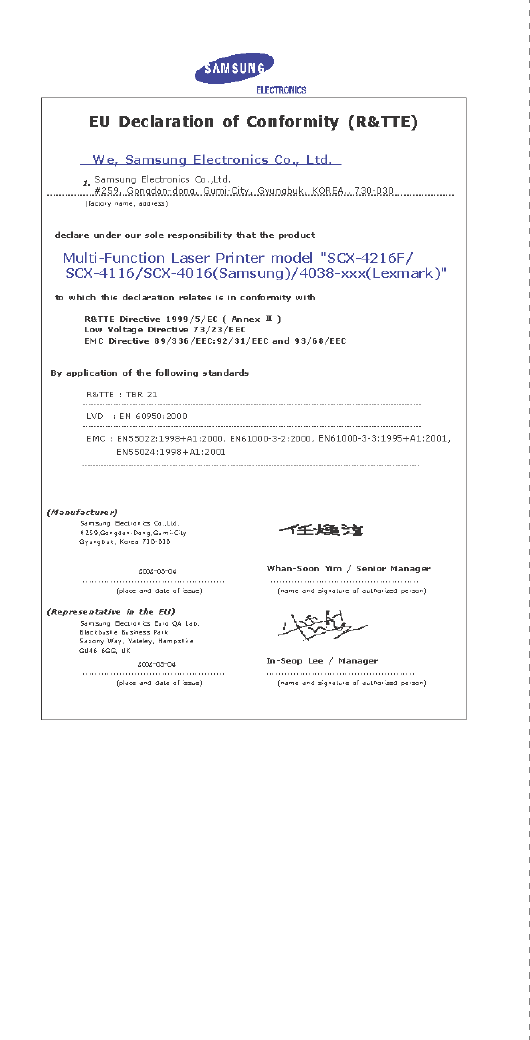
8
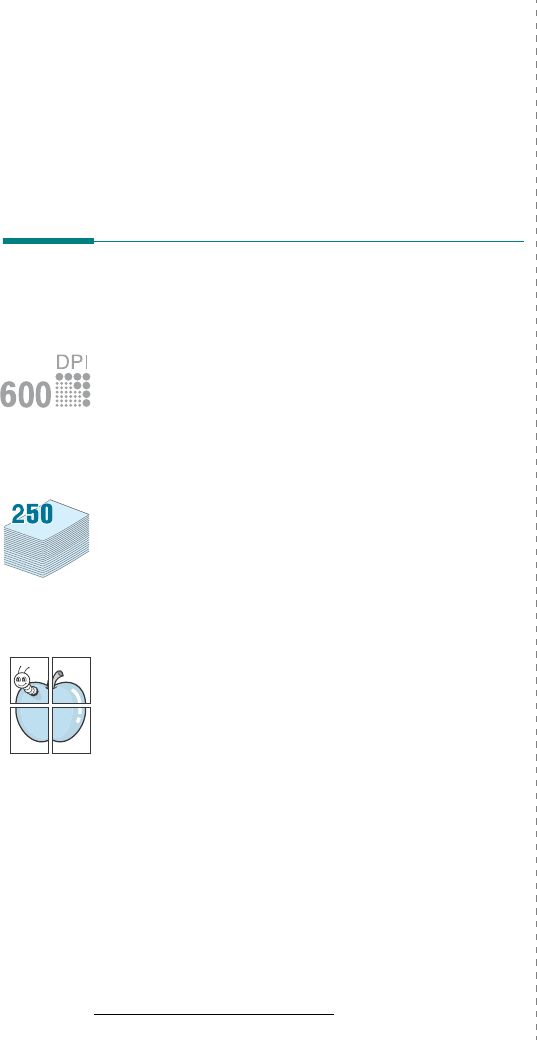
Introduction
1.
1
1Introduction
Thank you for purchasing this Samsung multifunctional
product. Your machine provides printing, copying, and scanning
functions!
This chapter includes:
• Special features
• Understanding component locations
Special features
Your new machine is equipped with special features that
improve the print quality. You can:
Print with excellent quality and speed
• You can print up to
600 dpi X 600 dpi
. See the
Software
Section
.
• Your machine prints A4-sized paper at up to 18 ppm
a
and
letter-sized paper at up to 19 ppm.
Handle paper flexibly
•The
manual feeder
supports plain paper, letterhead,
envelope, label, transparency, custom-sized material,
postcard, and heavy paper.
•The
paper input tray
supports 250 sheets of A4/letter-
sized paper.
Create professional documents
•Print
Watermarks
. You can customize your documents with
words, such as “Confidential.” See the
Software Section
.
•Print
Posters
. The text and pictures of each page of your
document are magnified and printed across the sheet of
paper and taped together to form a poster. See the
Software Section
.
a. page per minute
Save time and money
• You can print multiple pages on one single sheet of paper to
save paper.
• You can use preprinted forms and letterhead on plain paper.
See the
Software Section
• This machine automatically
conserves electricity
by
substantially reducing power consumption when not
printing.
Print in various environments
•You can print in
Windows 98/Me/2000/XP
.
• Your machine is compatible with various
Linux
.
• Your machine is compatible with various
Macintosh
.
• Your machine comes with the
USB
interface.
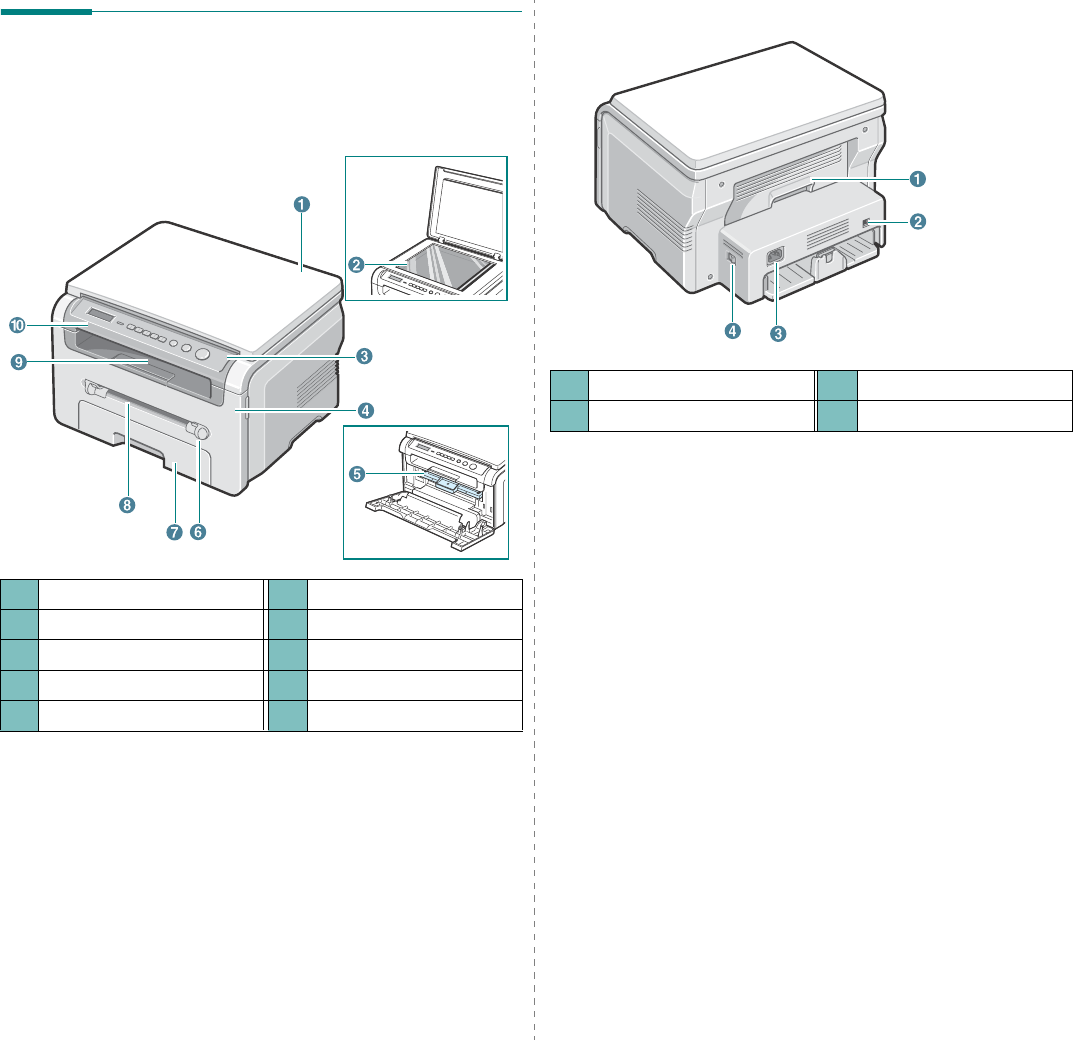
Introduction
1.
2
Understanding component
locations
These are the main components of your machine:
Front view
1
document cover
6
manual feeder guides
2
document glass
7
paper input tray
3
control panel
8
manual feeder
4
front cover
9
output tray
5
toner cartridge
10
scan unit
Rear view
1
rear cover
3
power respectable
2
USB port
4
power switch
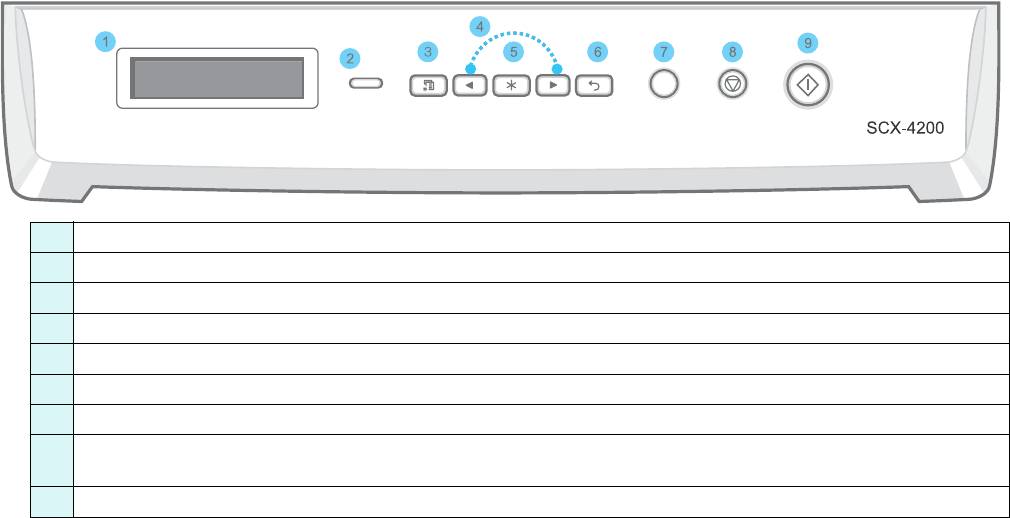
Introduction
1.
3
Control panel functions
SCX-4200
1
Displays the current status and prompts during an operation.
2
Status
- Shows the status of your machine. See page 9.3.
3
Menu
- Enters Menu mode and scrolls through the available menus.
4
Scroll through the options available in the selected menu.
5
OK
- Confirms the selection on the display.
6
Back
- Sends you back to the upper menu level.
7
Copies
- Allows you to enter the number of copies.
8
Stop/Clear
- Stops an operation at any time.
In Standby mode, clears/cancels the copy options, such as the resolution, the document type setting, the copy size, and the number of copies.
9
Start
- Starts a job.
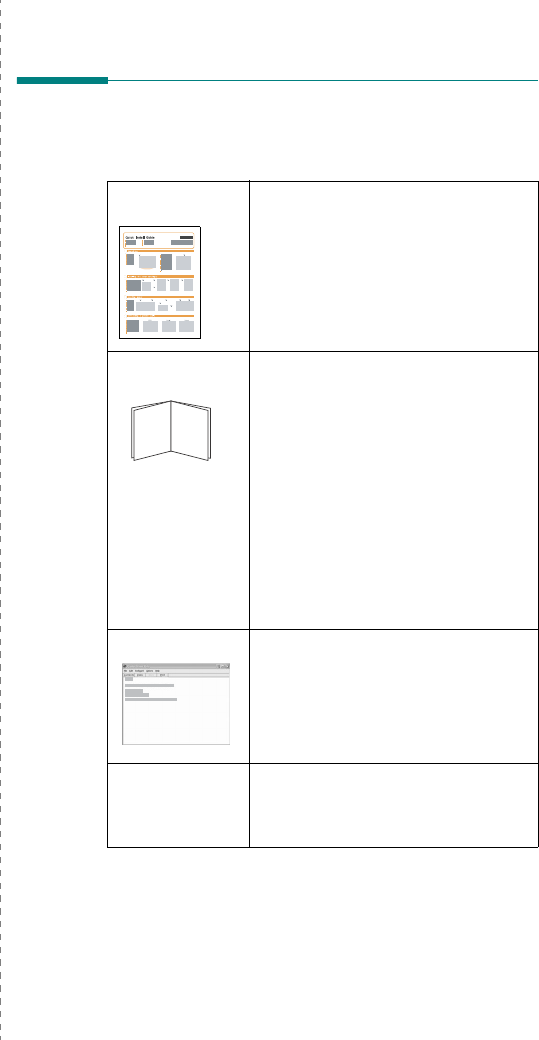
Getting started
2.
1
2Getting started
This chapter gives you step-by-step instructions for setting up
your machine.
This chapter includes:
Setting up your machine
• Selecting a location
• Installing the toner cartridge
• Loading paper
•Making connections
• Turning the machine on
Setting up the machine system
• Overview of control panel menus
• Changing the display language
•Using the save modes
Printer software overview
• Supplied printer software
• Printer driver features
• System requirements
Setting up your machine
Finding more information
You can find information for setting up and using your machine
from the following resources, either printed or onscreen.
Quick Install
Guide
Provides information on setting up your
machine and, therefore, be sure to follow
the instructions in the guide to get the
machine ready.
Online User’s
Guide
Provides you with step-by-step
instructions for using your machine’s full
features, and contains information for
maintaining your machine,
troubleshooting, and installing
accessories.
This user’s guide also contains the
Software Section
providing you with
information on how to print documents
with your machine on various operating
systems, and how to use the supplied
software utilities.
NOTE:
You can access the user’s guides
in other languages from the
Manual
folder on the printer driver CD.
Printer Driver Help Provides you with help information on
printer driver properties and instructions
for setting up the properties for printing.
To access a printer driver help screen,
click
Help
from the printer properties
dialog box.
Samsung website If you have Internet access, you can get
help, support, printer drivers, manuals,
and order information from the Samsung
website, www.samsungprinter.com.
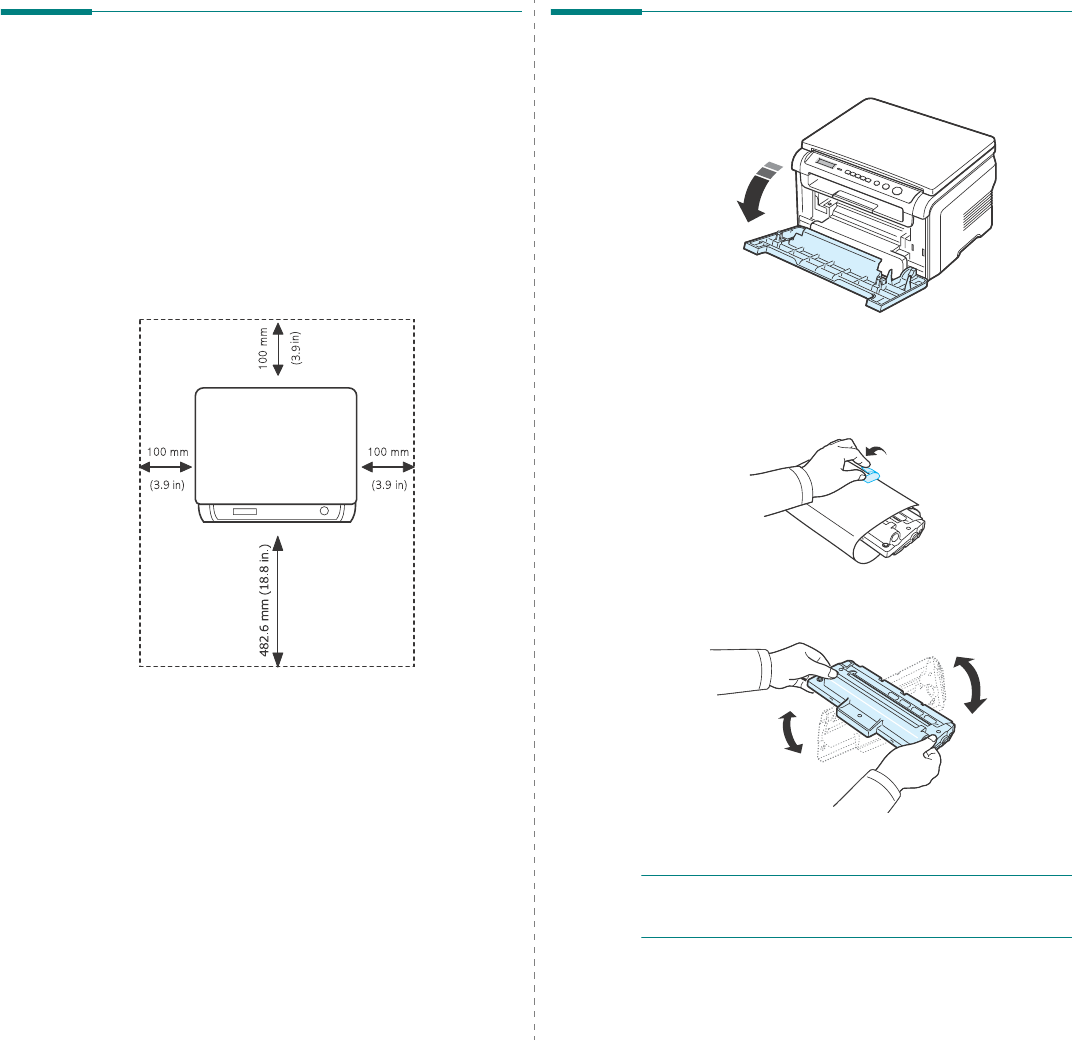
Getting started
2.
2
Selecting a location
Select a level, stable place with adequate space for air
circulation. Allow extra space for opening covers and trays.
The area should be well-ventilated and away from direct
sunlight or sources of heat, cold, and humidity. Do not set the
machine close to the edge of your desk or table.
Clearance space
•
Front
: 482.6 mm (enough space so that the paper tray can
be removed)
•
Back
: 100 mm (enough space for ventilation)
•
Right
: 100 mm (enough space for ventilation)
•
Left
: 100 mm (enough space for ventilation)
Installing the toner cartridge
1
Open the front cover.
2
Remove the toner cartridge from its bag. Do not use a
knife or other sharp object as it might scratch the drum of
the toner cartridge.
3
Remove the paper protecting the toner cartridge.
4
Roll the toner cartridge 5 or 6 times to distribute the toner
evenly inside the toner cartridge.
Thoroughly rolling the toner cartridge will assure
maximum copies per toner cartridge.
NOTE
: If toner gets on your clothing, wipe it off with a dry
cloth and wash clothing in cold water. Hot water sets toner into
fabric.
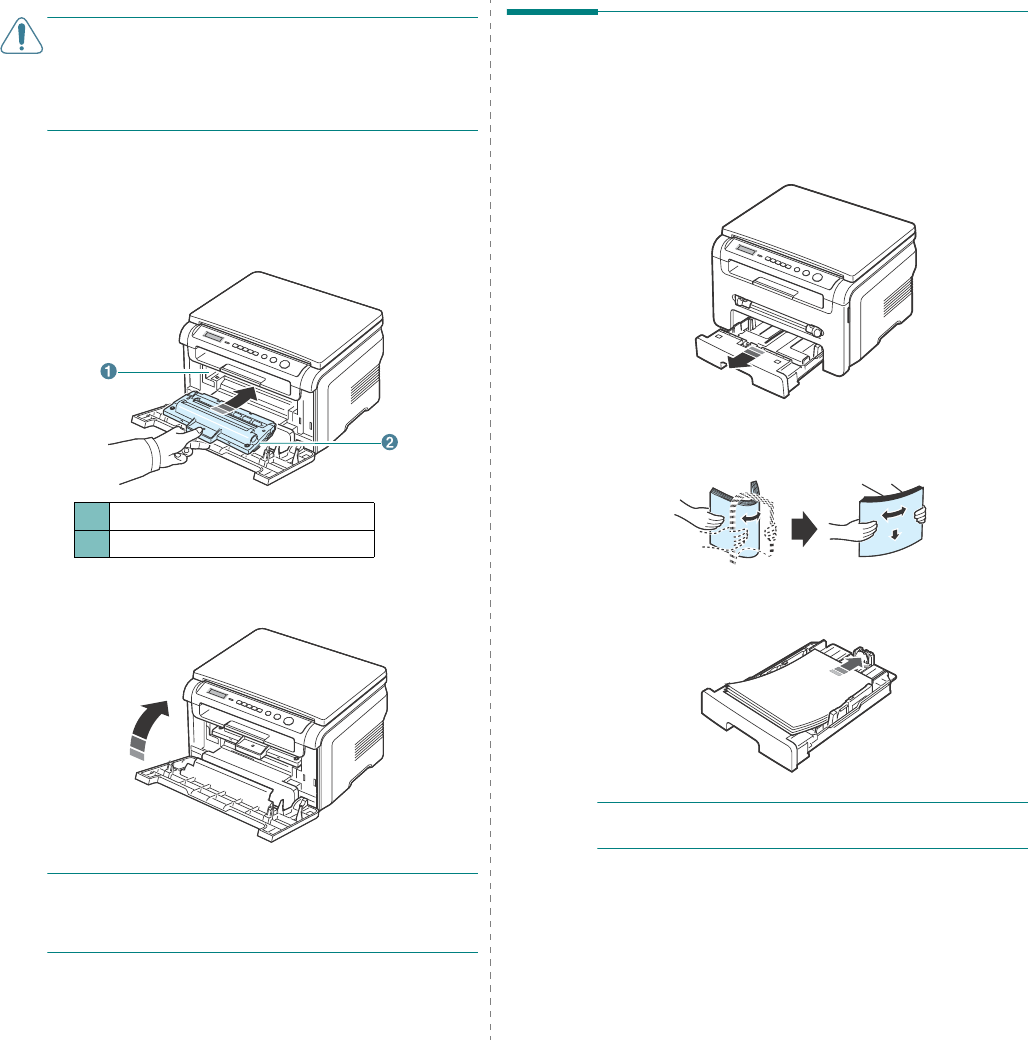
Getting started
2.
3
CAUTION
:
• To prevent damage, do not expose the toner cartridge to
light for more than a few minutes. Cover it with a piece of
paper, if left exposed for more than a few minutes.
• Do not touch the green underside of the toner cartridge. Use
the handle on the toner cartridge to avoid touching this area.
5
Hold the toner cartridge by the handle. Slowly insert the
toner cartridge into the opening in the machine.
6
Tabs on the sides of the toner cartridge and corresponding
grooves within the machine will guide the toner cartridge
into the correct position until it locks into place completely.
7
Close the front cover. Make sure that the front cover is
securely closed.
NOTE
: When printing text at 5% coverage, you can expect a
toner cartridge life of approximately 3,000 pages. (1,000
pages for the toner cartridge that is shipped with the
machine.)
1
Groove
2
Tab
Loading paper
The paper input tray can hold a maximum of 250 sheets of 20
lb (
75 g/m
2
) plain paper.
To load a stack of Letter-sized paper:
1
Pull open the paper input tray and remove it from the
machine.
2
Fan the edges of the paper stack to separate the pages.
Then tap the stack on a flat surface to even it up.
3
Insert the paper stack into the paper input tray
with the
side to be printed on facing down
.
NOTE
: If you want to load a different sized paper, you need to
adjust the paper guides. For details, see page 2.4.
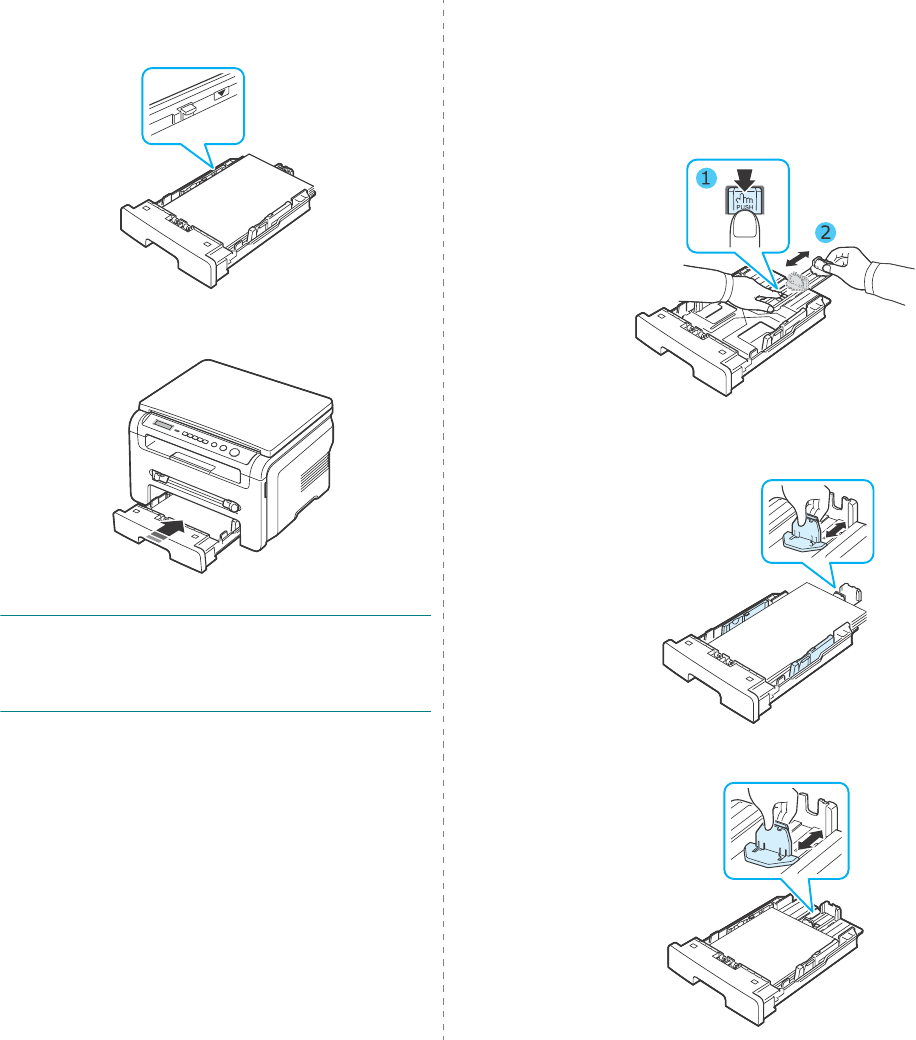
Getting started
2.
4
4
Pay attention to the paper limit mark on both inside walls
of the paper input tray. Paper overloading may cause
paper jams.
5
Insert and slide the paper input tray back into the
machine.
NOTE
: After you load paper, you need to set up your machine
for the paper type and size you loaded. See page 3.6 for
copying, or the
Software Section
for PC-printing. The
settings made from the printer driver override the settings on
the control panel.
Changing the size of the paper in the paper
input tray
To load longer sizes of paper, such as Legal-sized paper, you
need to adjust the paper guides to extend the paper input tray.
1
After pressing and unlatching the guide lock, slide the
paper length guide out completely to extend the paper
input tray to its full length.
2
After inserting paper into the paper input tray, squeeze the
front paper length guide and slide it until it lightly touches
the end of the paper stack.
For paper smaller than Letter size, adjust the front paper
length guide so that it lightly touches the paper stack.
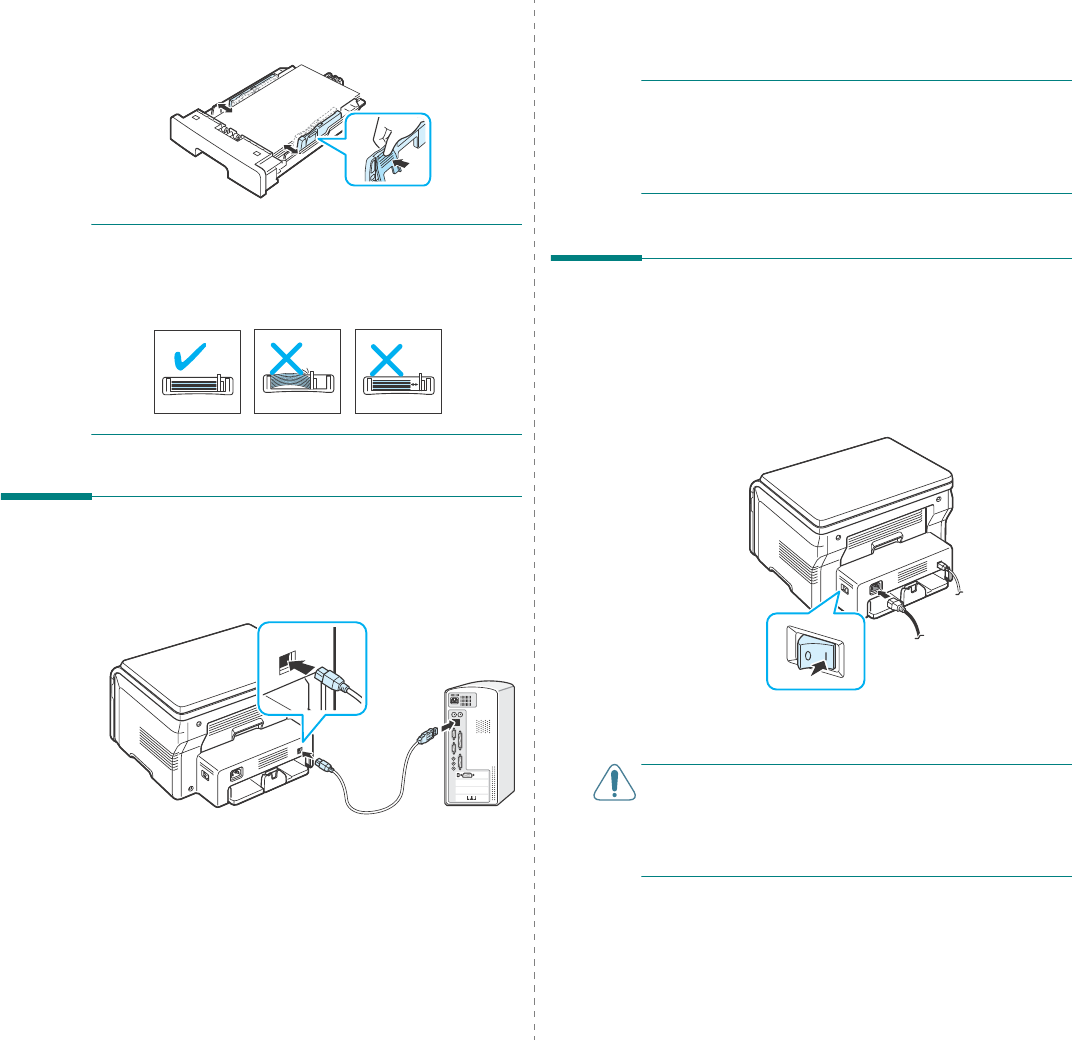
Getting started
2.
5
3
Squeeze the paper width guide, as shown and slide it to
the stack of paper until it lightly touches the side of the
stack.
NOTES
:
• Do not push the paper width guide far enough to cause the
materials to warp.
• If you do not adjust the paper width guide, it may cause
paper jams.
Making connections
1
Connect a USB cable to the USB connector on your
machine. You need to buy a USB 2.0 compliant cable that
is not longer than 3 m.
To the USB port on your computer
2
Connect the other end of the cable to the USB port on your
computer.
See your computer User’s Guide if you need help.
NOTE
: When using the USB connection, your machine
provides two USB modes; Fast and Slow. Fast is the default
mode. Some PC users may experience poor USB function in
the default mode. If this occurs, select Slow mode to achieve
successful results. For details about changing the USB mode,
see page 9.6.
Turning the machine on
1
Plug one end of the supplied power cord into the power
respectable on the machine and the other end into a
properly grounded AC outlet.
2
Press the power switch to turn the machine on.
warming
up please wait
appears on the display indicating that the
machine is now on.
To view your display text in another language, see
page 2.6.
CAUTION
:
• The fuser area inside of the rear cover of your machine
becomes very hot when in use. Take care not to burn your
fingers when you access this area.
• Do not disassemble the machine with power on. If you do,
you may receive an electric shock.
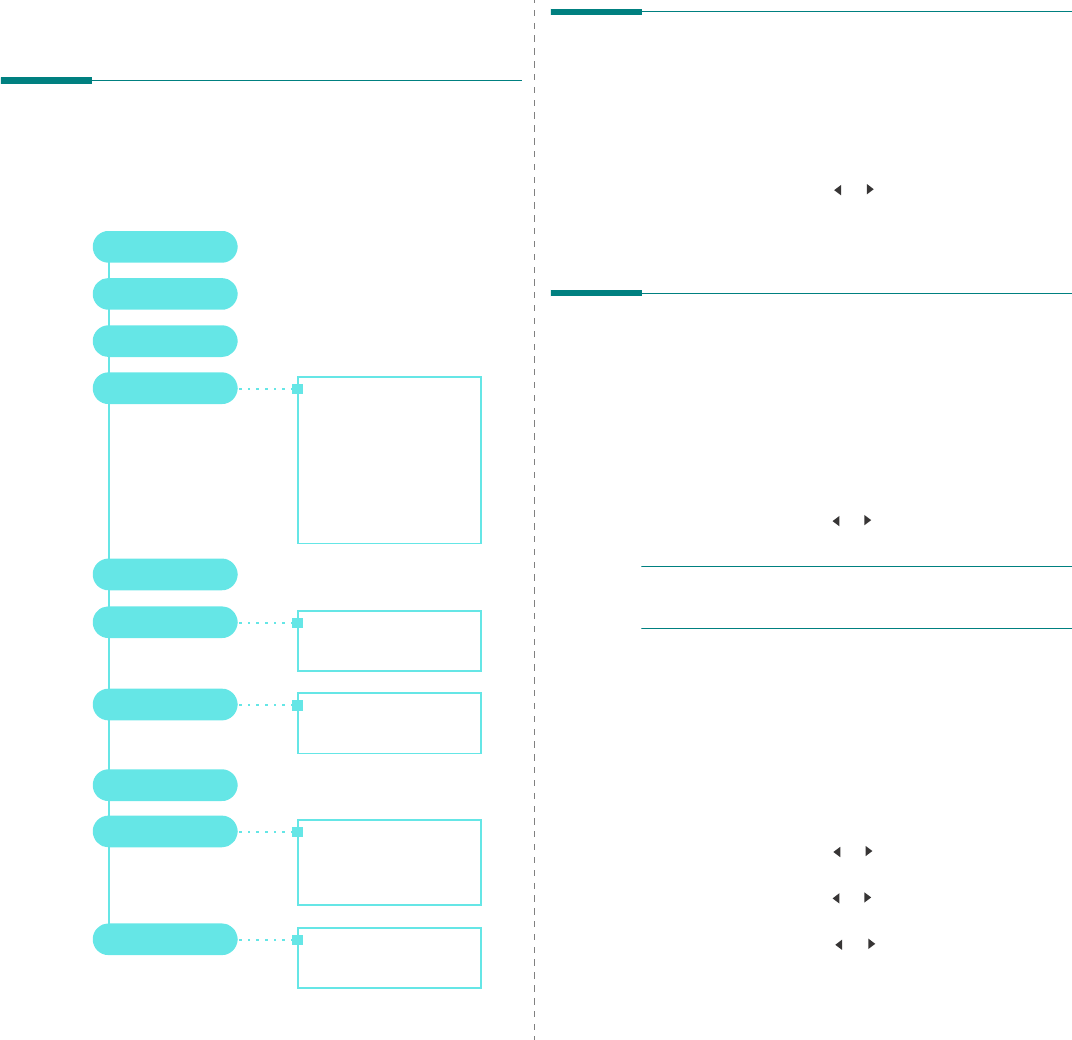
Getting started
2.
6
Setting up the machine system
Overview of control panel menus
The control panel provides access to various menus to set up
the machine or use the machine’s functions. They can be
accessed by pressing
Menu
.
Refer to the following diagram.
Reduce/Enlarge
Darkness
Original Type
Special Copy Off
Clone
Auto Fit
ID Card Copy
2 UP
Poster
Toner Save
Paper Setting Paper Size
Paper Type
Copy Setup Default-Change
Timeout
Report
Machine Setup Language
Power Save
USB mode
Maintenance Clean Drum
Clear Settings
Changing the display language
To change the language that appears on the control panel,
follow these steps:
1
Press
Menu
until
Machine Setup
appears on the top line
of the display.
2
Press
OK
when
Language
appears.
3
Press
the scroll button ( or )
to select the language you
want and press
OK
.
4
Press
Stop/Clear
to return to Standby mode.
Using the save modes
Toner save mode
Toner save mode allows your machine to use less toner on each
page. Activating this mode extends the life of the toner
cartridge beyond what one would experience in the normal
mode, but it reduces print quality.
1
Press
Menu
until
Toner Save
appears on the top line of
the display.
2
Press the scroll button ( or ) until
On
appears and press
OK
.
NOTE
: When PC-printing, you can also turn on or off Toner
Save mode in the printer properties. See the
Software
Section
.
Power save mode
Power save mode allows your machine to reduce power
consumption when it is not in actual use. You can turn this
mode on and select a length of time for which the machine
waits after a job is printed before it switches to a reduced power
state.
1
Press
Menu
until
Machine Setup
appears on the top line
of the display.
2
Press the scroll button ( or ) until
Power Save
appears
and press
OK
.
3
Press the scroll button ( or ) until
On
appears and press
OK
.
4
Press the scroll button ( or ) to select the time setting
you want and press
OK
.
5
Press
Stop/Clear
to return to Standby mode.
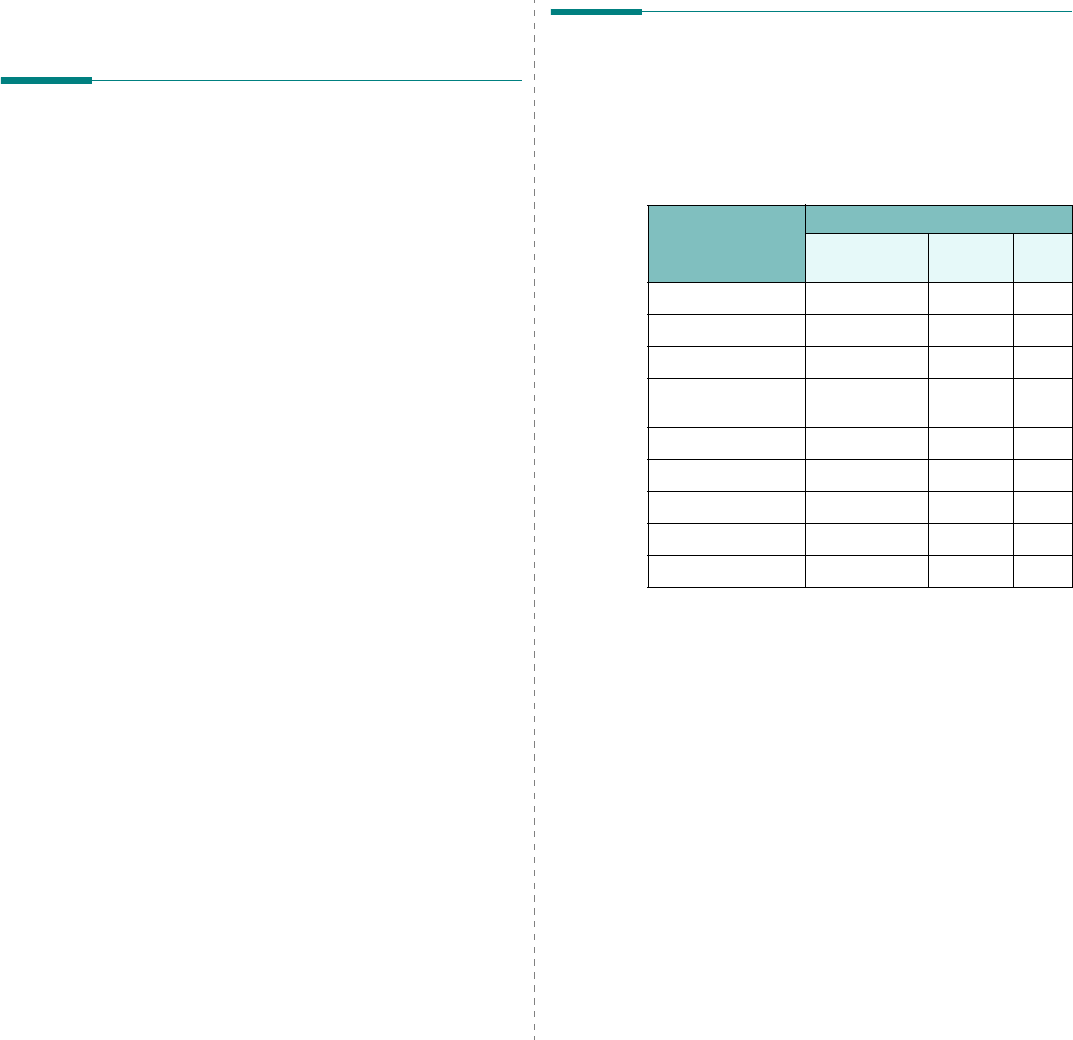
Getting started
2.
7
Printer software overview
Supplied printer software
You must install the printer software using the supplied printer
driver CD after you have set up your machine and connected it
to your computer. For details, see the
Software Section
.
The printer driver CD provides you with the following software:
Programs for windows
To use your machine as a printer and scanner in Windows, you
must install the MFP driver. You can install selectively or all the
following components:
•
Printer driver
- Use this driver to take full advantage of
your printer’s features.
•
Scanner driver
- TWAIN and Windows Image Acquisition
(WIA) driver are available for scanning documents on your
machine.
•
Smart Panel
- This program allows you to monitor the
machine’s status and alerts you when an error occurs during
printing.
•
SmarThru
- This is the accompanying Windows-based
software for your multifunctional machine. Allows you to edit
a scanned image in many ways using a powerful image
editor and to send the image by email. You can also open
another image editor program installed in your Windows,
like Adobe PhotoShop, from SmarThru.
For details, please refer to the onscreen help supplied on the
SmarThru program.
Linux driver
You can print and scan in Linux using your machine. For
information about installing the MFP driver in Linux, see the
Software Section
.
Macintosh printer driver
You can print and scan in Macintosh using your machine. For
information about installing the printer driver in Macintosh, see
the
Software Section
.
Printer driver features
Your printer drivers support the following standard features:
• Paper source selection
• Paper size, orientation and media type
•Number of copies
The following table lists a general overview of features
supported by your printer drivers.
Feature
Printer Driver
Win 98/Me/
2000/XP
Macintosh Linux
Toner save Y N Y
Print quality option Y Y Y
Poster printing Y N N
Multiple pages
per sheet (N-up)
Y Y Y(2,4)
Fit to page printing Y N Y
Scale printing Y Y Y
Watermark Y N N
Overlay Y N N
TrueType fonts op tion Y N N
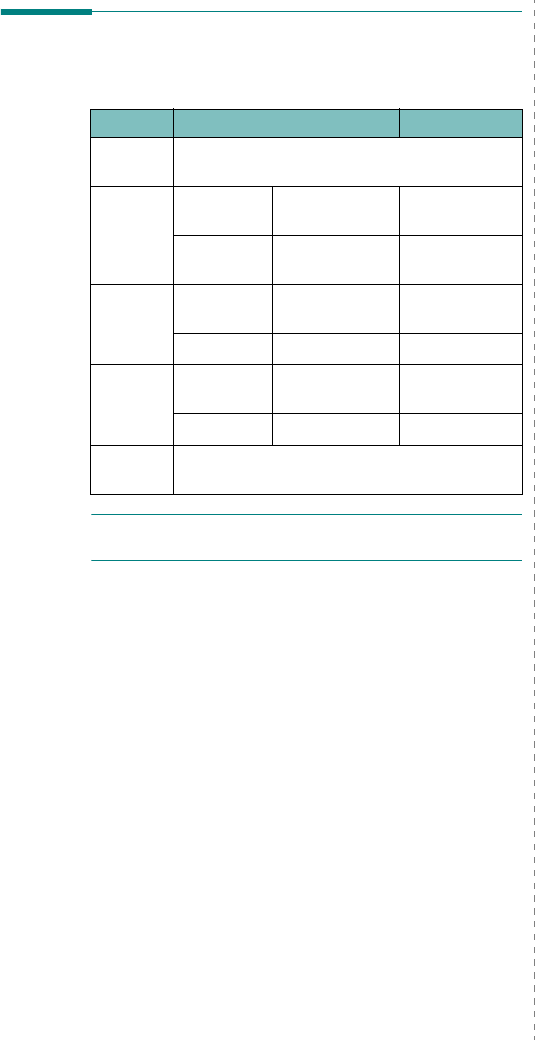
Getting started
2.
8
System requirements
Before you begin, ensure that your system meets the minimum
requirements.
NOTE
: For Windows 2000/XP, users who have an
administrator right can install the software.
Item Requirements Recommended
Operating
system
Windows 98/Me/2000/XP
CPU Windows
98/Me/2000
Pentium II 400
MHz or higher
Pentium III 933
MHz
Windows XP Pentium III 933
MHz or higher
Pentium IV 1
GHz
RAM Windows
98/Me/2000
64 MB or more 128 MB
Windows XP 128 MB or more 256 MB
Free disk
space
Windows
98/Me/2000
300 MB or more 1 GB
Windows XP 1 GB or more 5 GB
Internet
Explorer
5.0 or higher
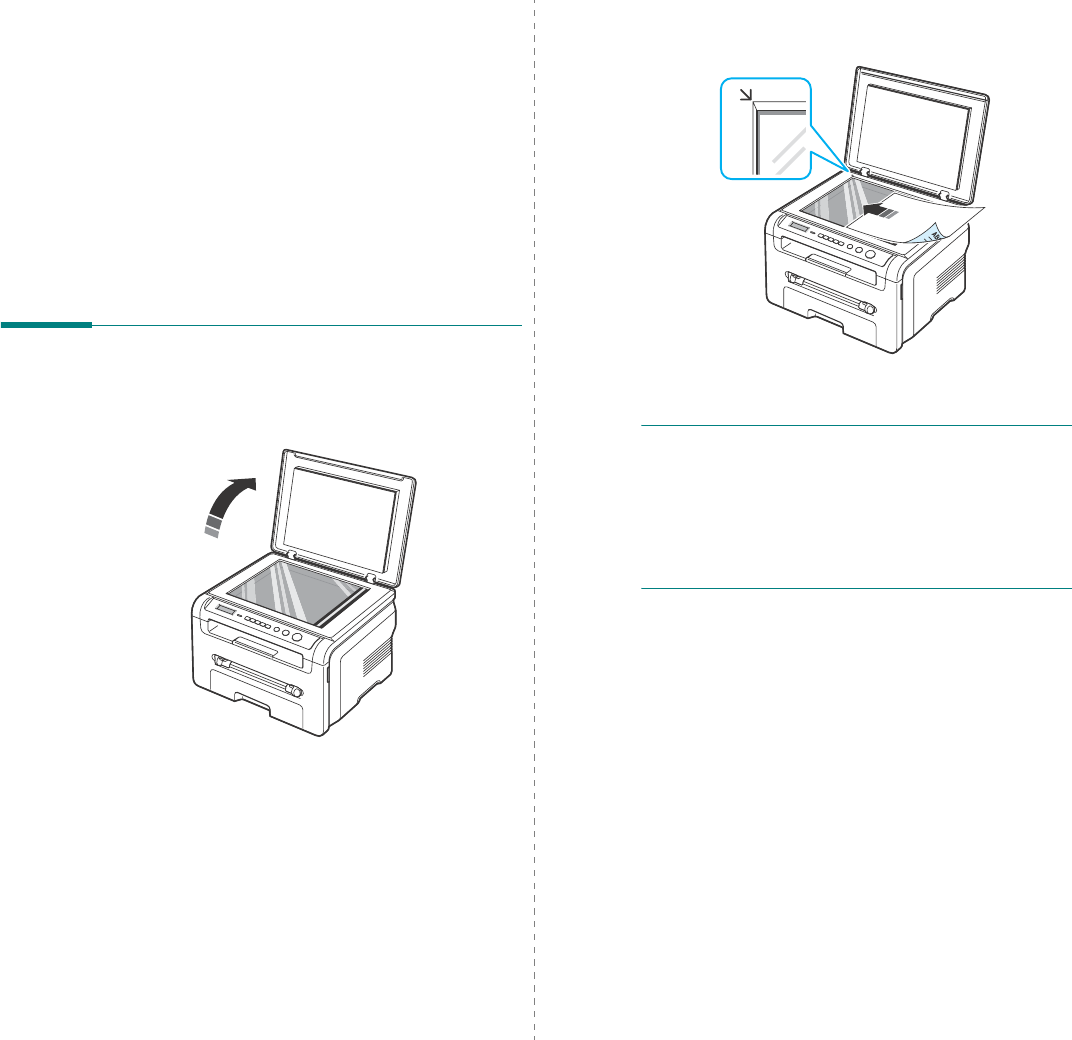
Loading original documents and paper
3.
1
3Loading original
documents and paper
This chapter introduces you to how to load documents and print
materials into your machine.
This chapter includes:
• Loading document
• Selecting print materials
• Loading paper
• Setting the paper size and type
• Selecting an output location
Loading document
You can use the document glass to load an original document
for copying and scanning.
1
Lift and open the document cover.
2
Place the document
face down
on the
document glass
and align it with the registration guide at the top left
corner of the glass.
3
Close the document cover. Be careful not to move the
document.
NOTES
:
• Leaving the document cover open while copying may affect
copy quality and toner consumption.
• Dust on the document glass may cause black spots on the
printout. Always keep it clean.
• If you are copying a page from a book or magazine, lift the
document cover until its hinges are caught by the stopper
and then close the cover. If the book or magazine is thicker
than 30 mm, start copying with the cover open.
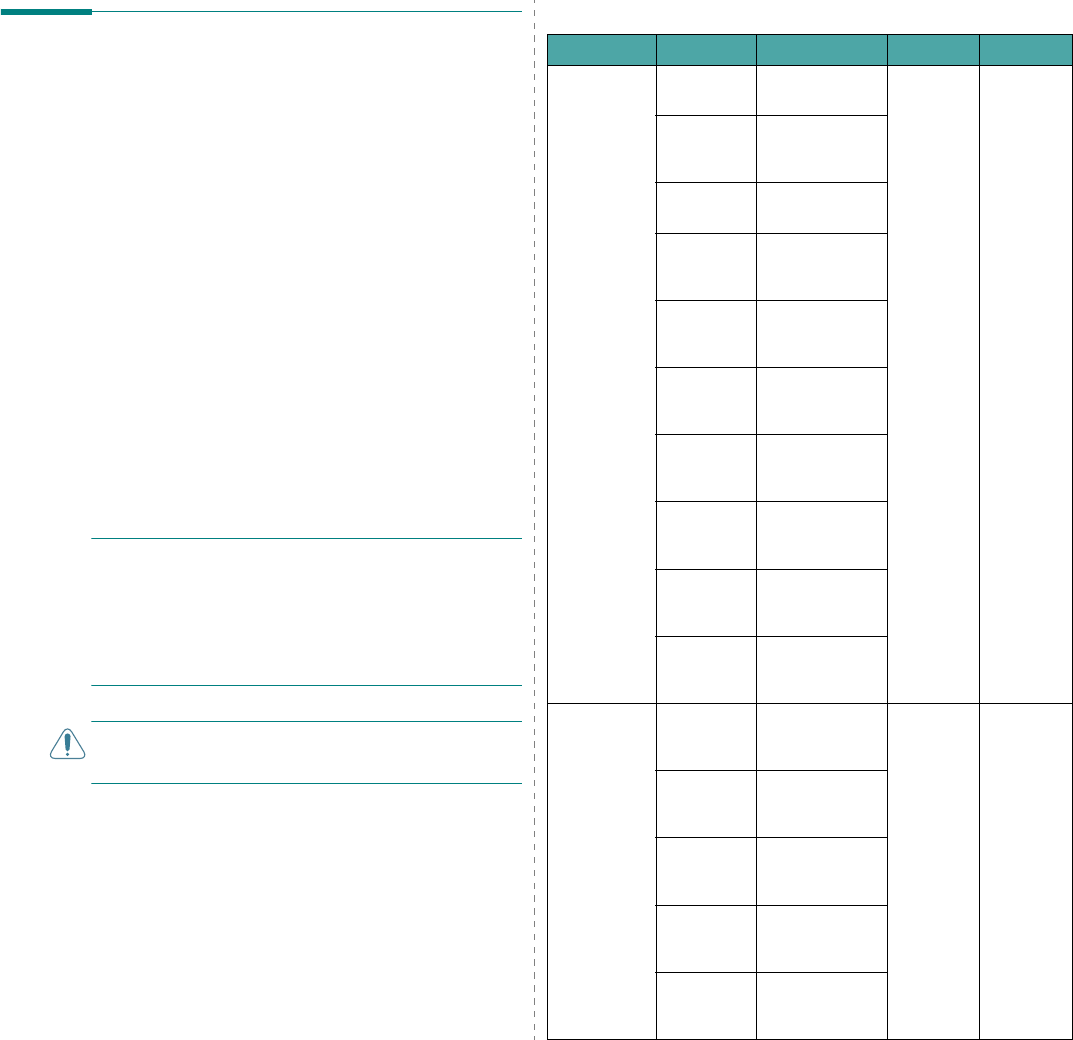
Loading original documents and paper
3.
2
Selecting print materials
You can print on a variety of print materials, such as plain
paper, envelopes, labels, and transparencies. Always use print
materials that meet the guidelines for use with your machine.
Paper that does not meet the guidelines outlined in this user’s
guide may cause the following problems:
• Poor print quality
• Increased paper jams
• Premature wear on the machine.
Properties, such as weight, composition, grain, and moisture
content, are important factors that affect the machine’s
performance and the output quality. When you choose print
materials, consider the following:
• Desired outcome: The paper you choose should be
appropriate for your project.
• Size: You can use any size paper that fits easily within the
paper adjusters of the paper input tray.
• Weight: Your machine supports paper weights as follows:
- 16 to 24 lb (60 to 90 g/m
2
) bond for the paper input tray
- 16 to 43 lb (60 to 165 g/m
2
) bond for the manual feeder.
• Brightness: Some papers are whiter than others and
produce sharper, more vibrant images.
• Surface smoothness: The smoothness of the paper affects
how crisp the printing looks on the paper.
NOTES
:
• Some paper may meet all of the guidelines in this section
and still not produce satisfactory results. This may be the
result of improper handling, unacceptable temperature and
humidity levels, or other variables over which Samsung has
no control.
• Before purchasing large quantities of paper, ensure that the
paper meets the requirements specified in this user’s guide.
CAUTION
: Using paper that does not meet these specifications
may cause problems, requiring repairs. Such repairs are not
covered by the Samsung warranty or service agreements.
Supported paper types and sizes
Type Size Dimensions Weight
a
Capacity
b
Plain paper Letter 215.9 x 279 mm
(8.5 x 11 inches)
• 60 to 90
g/m
2
(16
to 24 lb
bond) for
the paper
input tray
• 60 to 165
g/m
2
(16
to 43 lb
bond) for
the
manual
feeder
• 250
sheets of
75 g/m
2
(20 lb
bond)
paper for
the paper
input tray
• 1 sheet of
paper for
the
manual
feeder
Legal 215.9 x 355.6
mm (8.5 x 14
inches)
Folio 216 x 330.2 mm
(8.5 x 13 inches)
A4 210 x 297 mm
(8.27 x 11.69
inches)
Oficio 216
/
x 343 mm
(8.5 x 13.5
inches)
JIS B5 182 x 257 mm
(7.18 x 10.12
inches)
ISO B5 176 x 250 mm
(6.93 x 9.84
inches)
Executive 184.2 x 266.7
mm (7.25 x 10.5
inches)
A5 148.5 x 210 mm
(5.85 x 8.27
inches)
A6 105 x 148.5 mm
(4.13 x 5.85
inches)
Envelope Envelope B5 176 x 250 mm
(6.92 x 9.48
inches)
60 to 90
g/m
2
(16 to
24 lb)
1 sheet of
paper for
the manual
feeder
Envelope
Monarch
98.4 x 190.5 mm
(3.88 x 7.5
inches)
Envelope
COM-10
105 x 241 mm
(4.12 x 9.5
inches)
Envelope DL 110 x 220 mm
(4.33 x 8.66
inches)
Envelope C5 162 x 229 mm
(6.38 x 9.02
inches)
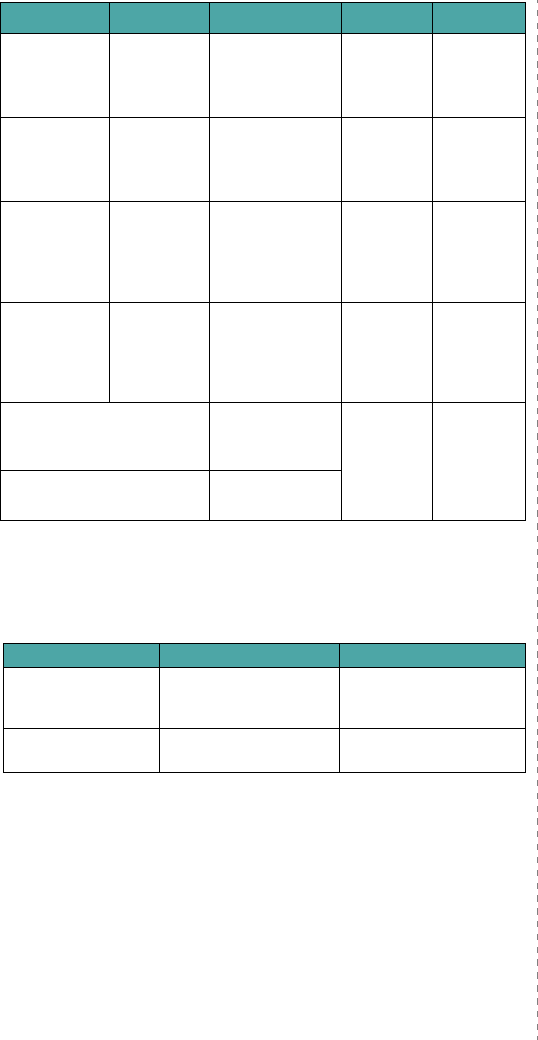
Loading original documents and paper
3.
3
Paper size supported in each mode
Envelope
(continued)
Envelope C6 114 x 162 mm
(4.48 x 6.37
inches)
60 to 90
g/m
2
(16 to
24 lb)
1 sheet of
paper for
the manual
feeder
Transparency Letter, A4 Refer to the Plain
paper section
138 to 148
g/m
2
1 sheet of
paper for
the manual
feeder
Labels Letter, Legal,
Folio, A4, JIS
B5, ISO B5,
Executive,
A5, A6
Refer to the Plain
paper section
120 to 150
g/m
2
(32 to
40 lb)
1 sheet of
paper for
the manual
feeder
Card stock Letter, Legal,
Folio, A4, JIS
B5, ISO B5,
Executive,
A5, A6
Refer to the Plain
paper section
60 to 165
g/m
2
(16 to
43 lb)
1 sheet of
paper for
the manual
feeder
Minimum size (custom) 98 x 148 mm
(3.86 x 5.83
inches)
60 to 165
g/m
2
(16 to
43 lb bond)
1 sheet of
paper for
the manual
feeder
Maximum size (custom) 215.9 x 356 mm
(8.5 x 14 inches)
a If paper weight is over 90 g/m
2
, load one sheet of paper in the manual feeder.
b Maximum capacity may differ depending on media weight, thickness, and
environmental conditions.
Type Size Dimensions Weight
a
Capacity
b
Mode Size Source
Copy mode Letter, A4, Legal, Folio,
Executive, ISO B5, JIS
B5, A5, A6
• paper input tray
• manual feeder
Single side printing All sizes supported by the
machine
• paper input tray
• manual feeder
Guidelines for selecting and storing
print materials
When selecting or loading paper, envelopes, or other print
materials, keep these guidelines in mind:
• Always use paper and other materials that conform with the
specifications listed on page 3.2.
• Attempting to print on damp, curled, wrinkled, or torn paper
can cause paper jams and poor print quality.
• For the best print quality, use only high quality copier grade
paper specifically recommended for use in laser printers.
• Avoid using the following paper types:
- Paper with embossed lettering, perforations, or a texture
that is too smooth or too rough
- Erasable bond paper
- Multi-paged paper
- Synthetic paper and thermally reactive paper
-
Carbonless
paper and
Tracing
paper.
• Use of these types of paper could result in paper jams,
chemical smells, and damage to your machine.
• Store paper in its ream wrapper until you are ready to use it.
Place cartons on pallets or shelves, not on the floor. Do not
place heavy objects on top of the paper, whether it is
packaged or unpackaged. Keep it away from moisture or
other conditions that can cause it to wrinkle or curl.
• Store unused materials at temperatures between 15
o
C and
30
o
C (59
o
F to 86
o
F). The relative humidity should be
between 10% and 70%.
• Store unused paper in a moisture-proof wrap, such as a
plastic container or bag, to prevent dust and moisture from
contaminating your paper.
• Load special paper types one sheet at a time through the
manual feeder to avoid paper jams.
• To prevent materials such as transparencies and label sheets
from sticking together, remove them as they print out.
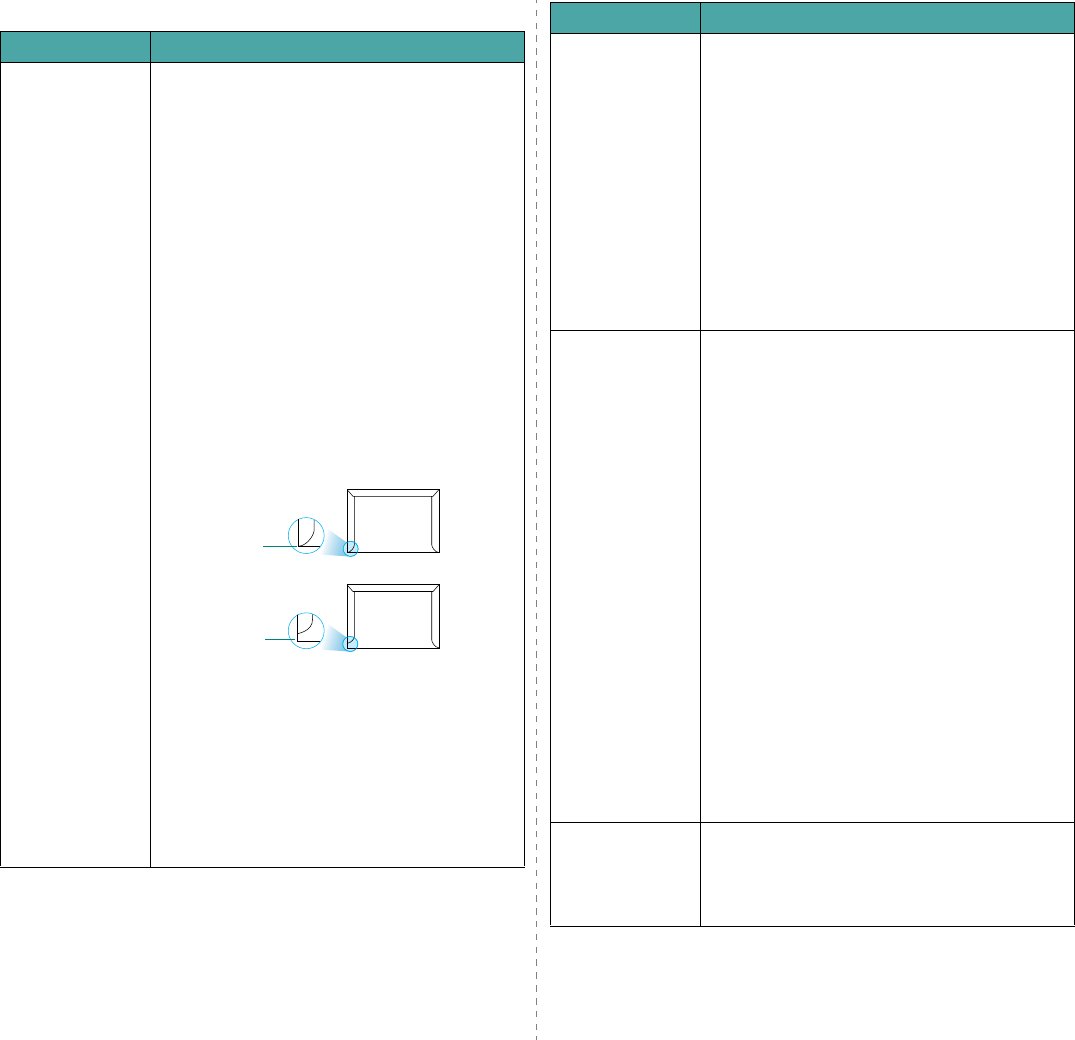
Loading original documents and paper
3.
4
Guidelines for special materials
Paper Type Guidelines
Envelopes • Successful printing on envelopes depends upon the
quality of the envelopes. When selecting envelopes,
consider the following factors:
- Weight: The weight of the envelope paper should
not exceed 90 g/m
2
(24 lb) or jamming may
occur.
- Construction: Prior to printing, envelopes should
lie flat with less than 6 mm (0.25 inches) curl, and
should not contain air.
- Condition: Envelopes should not be wrinkled,
nicked, or otherwise damaged.
- Temperature: You should use envelopes that are
compatible with the heat and pressure of the
machine during operation.
• Use only well-constructed envelopes with sharp and
well creased folds.
• Do not use stamped envelopes.
• Do not use envelopes with clasps, snaps, windows,
coated lining, self-adhesive seals, or other synthetic
materials.
• Do not use damaged or poorly made envelopes.
• Be sure the seam at both ends of the envelope
extends all the way to the corner of the envelope.
• Envelopes with a peel-off adhesive strip or with
more than one flap that folds over to seal must use
adhesives compatible with the machine’s fusing
temperature of 208° C (406.4° F) for 0.1 second.
The extra flaps and strips might cause wrinkling,
creasing, or jams, and may even damage the fuser.
• For the best print quality, position margins no closer
than 15 mm (0.6 inches) from the edges of the
envelope.
• Avoid printing over the area where the envelope’s
seams meet.
Acceptable
Unacceptable
Transparencies • To avoid damaging the machine, use only
transparencies designed for use in laser printers.
• Transparencies used in the machine must be able to
withstand 208° C (406.4° F), the machine’s fusing
temperature.
• Place them on a flat surface after removing them
from the machine.
• Do not leave them in the paper tray for long periods
of time. Dust and dirt may accumulate on them,
resulting in spotty printing.
• To avoid smudging caused by fingerprints, handle
them carefully.
• To avoid fading, do not expose printed
transparencies to prolonged sunlight.
• Ensure that transparencies are not wrinkled, curled,
or have any torn edges.
Labels • To avoid damaging the machine, use only labels
designed for use in laser printers.
• When selecting labels, consider the following
factors:
- Adhesives: The adhesive material should be stable
at 208° C (406.4° F), the machine’s fusing
temperature.
- Arrangement: Only use labels with no exposed
backing between them. Labels can peel off sheets
that have spaces between the labels, causing
serious jams.
- Curl: Prior to printing, labels must lie flat with no
more than 13 mm (5 inches) of curl in any
direction.
- Condition: Do not use labels with wrinkles,
bubbles, or other indications of separation.
• Make sure that there is no exposed adhesive
material between labels. Exposed areas can cause
labels to peel off during printing, which can cause
paper jams. Exposed adhesive can also cause
damage to machine components.
• Do not run a sheet of labels through the machine
more than once. The adhesive backing is designed
for only a single pass through the machine.
• Do not use labels that are separating from the
backing sheet or are wrinkled, bubbled, or
otherwise damaged.
Card stock or
custom-sized
materials
• Do not print on media smaller than 76 mm (3
inches) wide or 127 mm (5 inches) long.
• In the software application, set margins at least 6.4
mm (0.25 inches) away from the edges of the
material.
Paper Type Guidelines
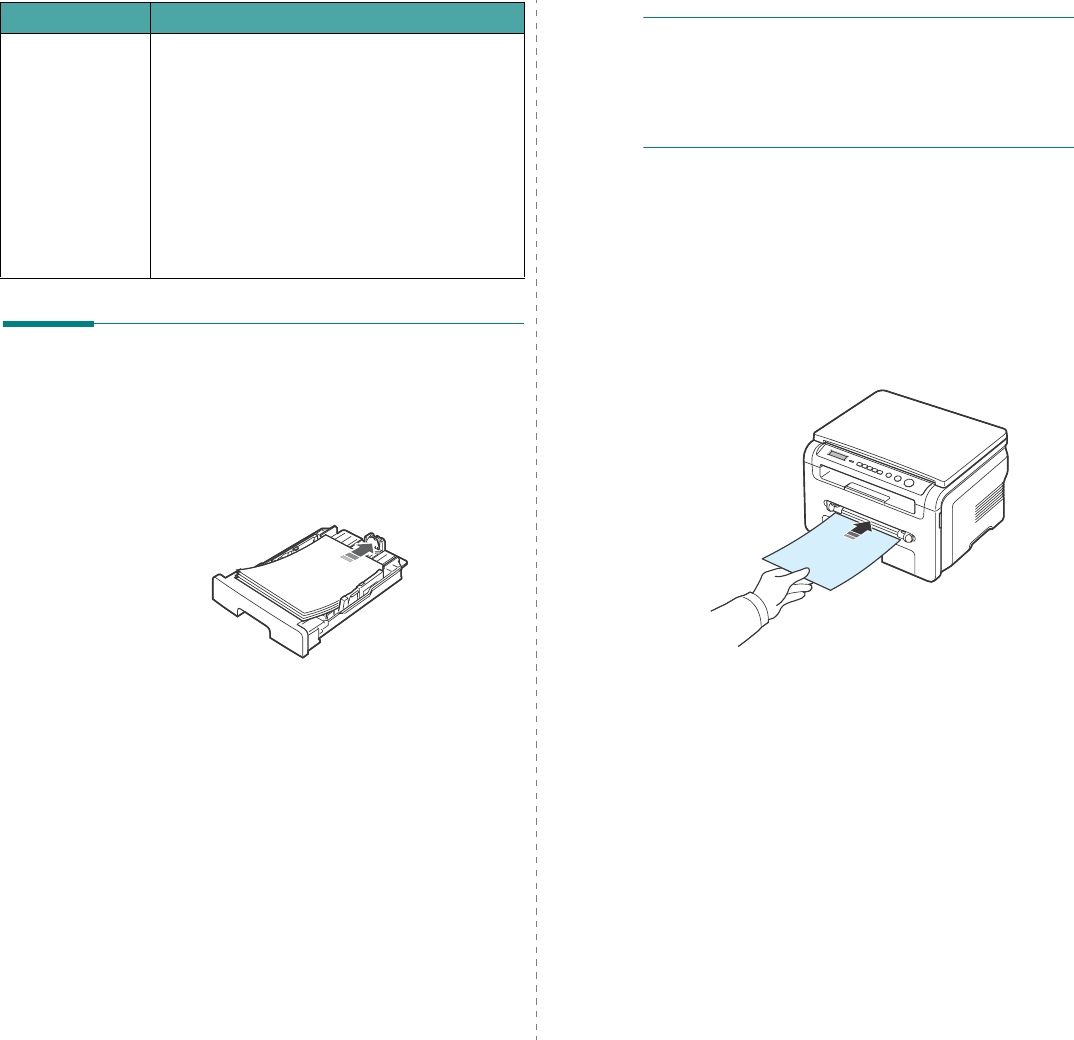
Loading original documents and paper
3.
5
Loading paper
In the paper input tray
Load the print material you use for the majority of your print
jobs in the paper input tray. The paper input tray can hold a
maximum of 250 sheets of 20 lb (
75 g/m
2
) plain paper.
To load paper, pull open the paper input tray and load paper
with the side to be printed on face down.
You can load letterhead paper with the design side face down.
The top edge of the sheet with the logo should be placed at the
front of the paper input tray.
For details about loading paper in the tray, see page 2.3.
Preprinted paper • Letterhead must be printed with heat-resistant ink
that will not melt, vaporize, or release hazardous
emissions when subjected to the machine’s fusing
temperature of 208° C (406.4° F) for 0.1 second.
• Letterhead ink must be non-flammable and should
not adversely affect printer rollers.
• Forms and letterhead should be sealed in a
moisture-proof wrapping to prevent changes during
storage.
• Before you load preprinted paper, such as forms and
letterhead, verify that the ink on the paper is dry.
During the fusing process, wet ink can come off
preprinted paper, reducing print quality.
Paper Type Guidelines
NOTES
:
• If you experience problems with paper feed, place one sheet
at a time in the manual feeder.
• You can load previously printed paper. The printed side
should be facing up with an uncurled edge at the front. If
you experience problems with paper feed, turn the paper
around. Note that the print quality is not guaranteed.
In the manual feeder
Use the manual feeder to print transparencies, labels,
envelopes or postcards in addition to making quick runs of
paper types or sizes that are not currently loaded in the paper
input tray.
To load print material in the manual feeder:
1
Load a sheet of the print material
with the side to be
printed on facing up
into the center of the manual
feeder.
Depending on the paper type you are using, keep the
following loading method:
• Envelopes: load a sheet with the flap side down and with
the stamp area on the top left side.
• Transparencies: load a sheet with the print side up and
the top with the adhesive strip entering the machine
first.
• Labels: load a sheet with the print size up and top short
edge entering the machine first.
• Preprinted paper: load a sheet with the design face up,
top edge toward the machine.
• Card: load a sheet with the print side up and the short
edge entering the machine first.
• Pre printed paper: load a sheet with the printed side
down and an uncurled edge toward the machine.
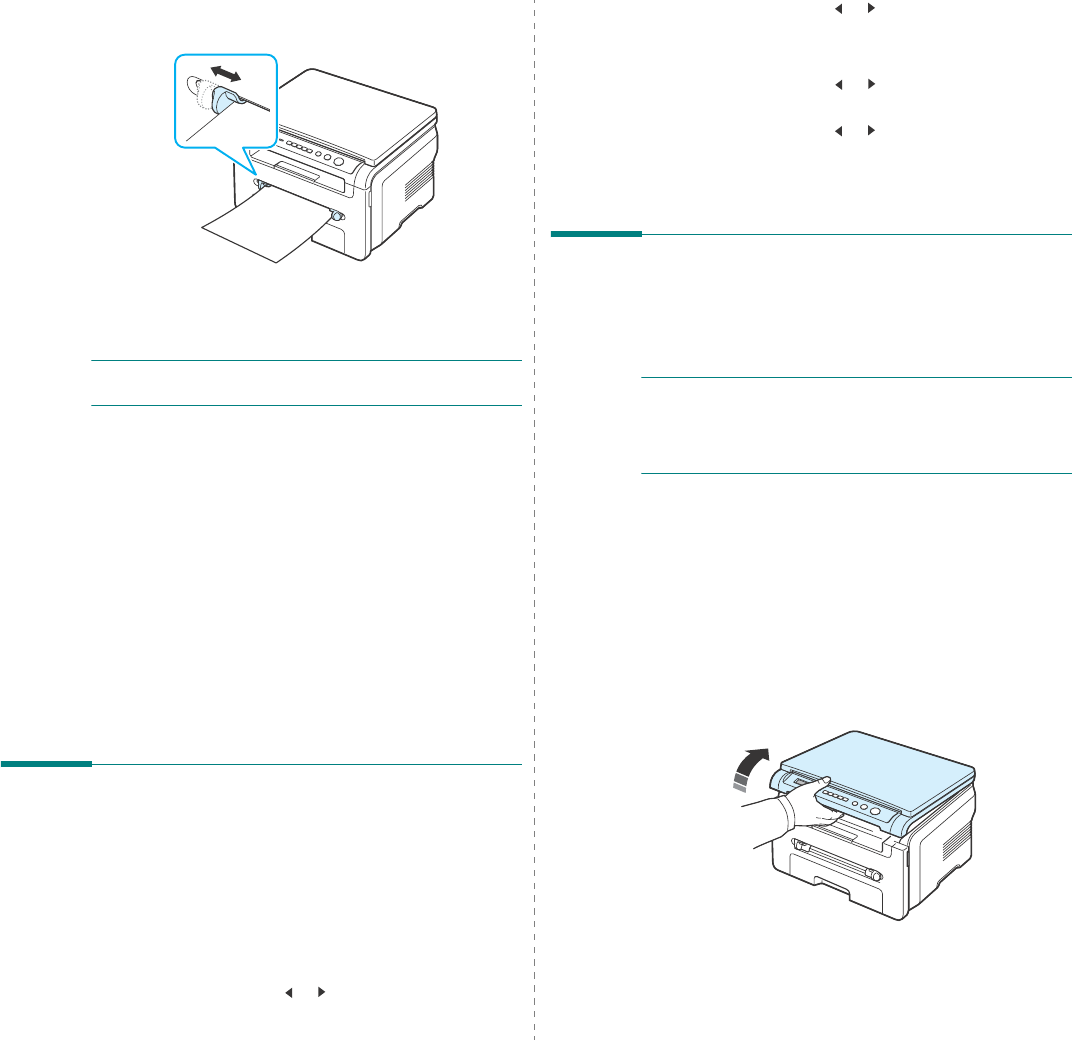
Loading original documents and paper
3.
6
2
Adjust the manual feeder guides to the width of the print
material without bending it.
3
After loading paper, you need to set the paper type and
size for the manual feeder. See page 3.6 for copying or the
Software Section
for PC-printing.
NOTE
: The settings made from the printer driver override the
settings on the control panel.
4
If you want to use the rear cover, open the rear cover.
Tips on using the manual feeder
• Print materials should be loaded face up with the top edge
going into the manual feeder first and be placed in the
center of the tray.
• Always load only the print materials specified in the
Specifications on page 3.2 to avoid paper jams and print
quality problems.
• When you print on 76 x 127 mm (3 x 5 inches) sized media
on the manual feeder, open the rear cover to use the rear
cover.
• Make sure to open the rear cover when you print on
transparencies. If not, they may tear while exiting the
machine.
Setting the paper size and type
After loading paper in the paper tray, you need to set the paper
size and type using the control panel buttons. These settings
will apply to Copy mode. For PC-pr int ing , you need to select the
paper size and type in the application program you use on your
PC.
1
Press
Menu
until
Paper Setting
appears on the top line
of the display.
2
Press
OK
when
Paper Size
appears.
3
Press the scroll button ( or ) to select the paper tray
you want to use and press
OK
.
4
Press
the scroll button ( or )
to find the paper size you
are using and press
OK
.
5
Press
Back
to return to the upper level.
6
Press the scroll button ( or ) to select
Paper Type
and
press
OK
.
7
Press
the scroll button ( or )
to find the paper type you
are using and press
OK
.
8
Press
Stop/Clear
to return to Standby mode.
Selecting an output location
The machine has two output locations: the rear cover (face up)
and the output tray (face down).
To use the output tray, make sure that the rear cover is closed.
To use the rear cover, open the rear cover.
NOTES
:
• If paper coming out of the output tray has problems, such as
excessive curl, try printing to the rear cover.
• To avoid paper jams, do not open or close the rear cover
while the machine is printing.
Printing to the output tray (Face down)
The output tray collects printed paper face down, in the order
in which the sheets were printed. The tray should be used for
most print jobs.
If you use paper which is not long enough to reach the output
tray, use the scan unit.
To use the scan unit:
1
Lift the scan unit. A tab automatically springs up to
support the cover.
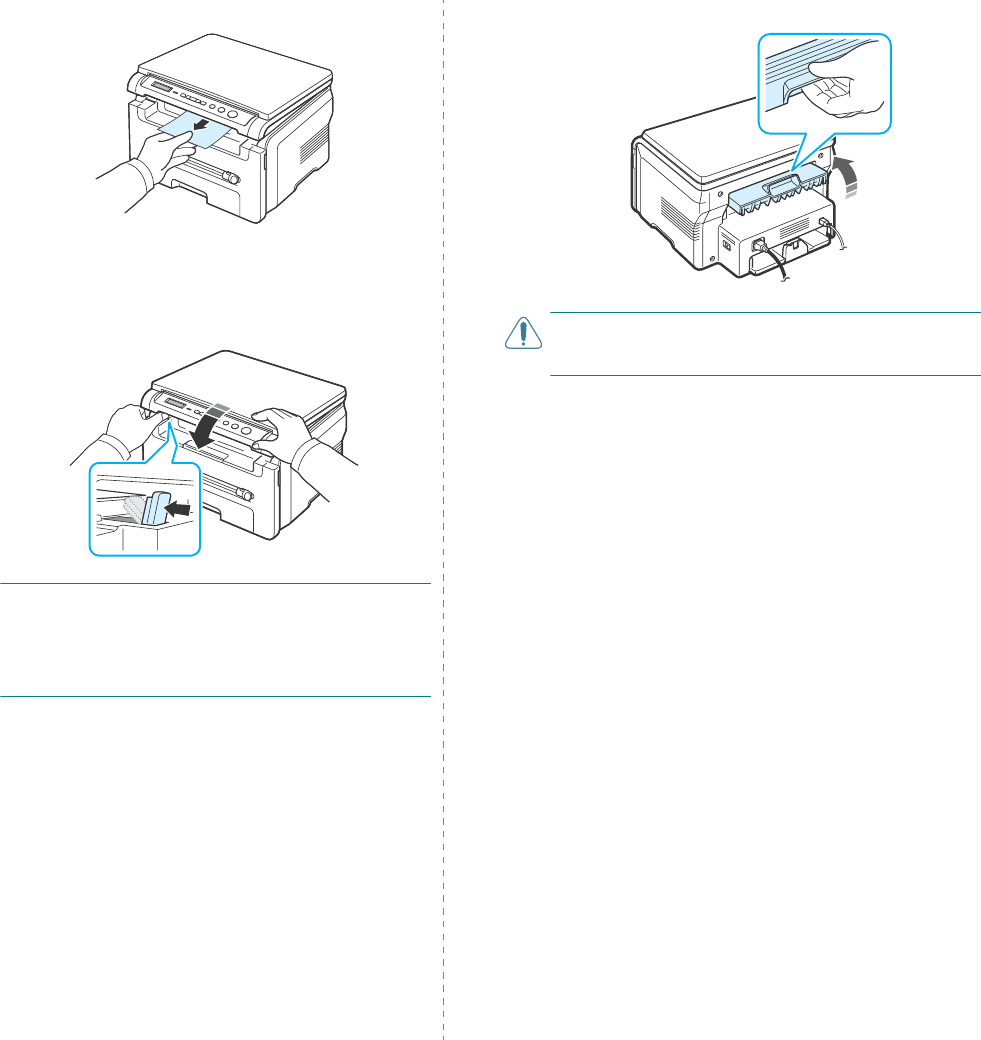
Loading original documents and paper
3.
7
2
Take the paper out manually.
3
Close the scan unit. In order to close the cover, push the
tab to the left and hold it down. Then lower the cover
carefully until the cover is holding down the tab. Then you
can move your hand and finish lowering the cover.
Be careful not to pinch your fingers!
NOTES
:
• If you continuously print many pages, the surface of the
output tray may become hot. Be careful not to touch the
surface, and especially keep children away from the surface.
• The output tray can hold up to 50 sheets of paper. Remove
the pages so that tray is not overloaded.
Printing to the rear cover (Face up)
Using the rear cover, paper comes out of the machine face up.
Printing from the manual feeder to the rear cover provides a
straight paper path
. Using the rear cover might improve the
output quality with special materials.
To use the rear cover, open the rear cover by pulling it up.
CAUTION
:
The fuser area inside the rear cover of your
machine becomes very hot when in use. Take care when you
access this area.
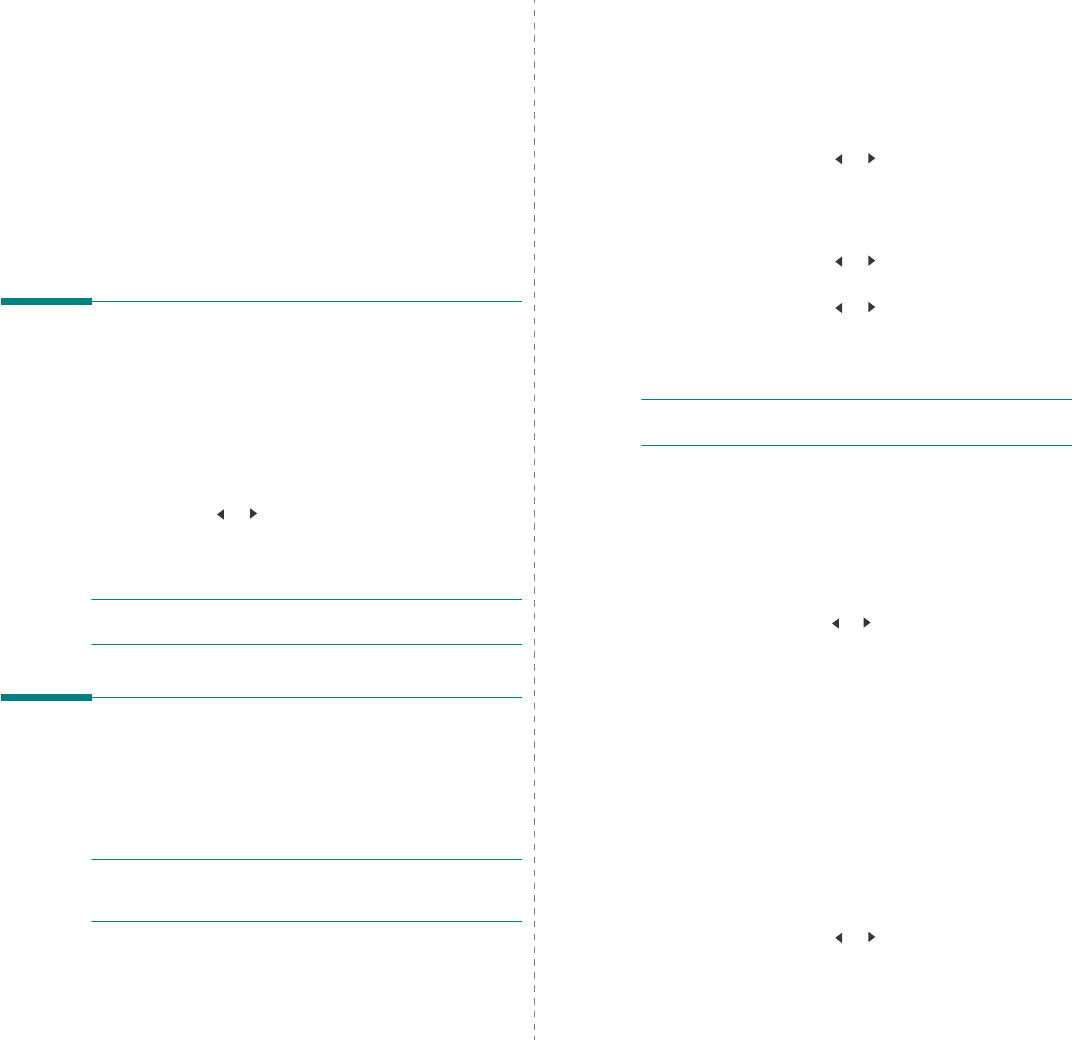
Copying
4.
1
4Copying
This chapter gives you step-by-step instructions for copying
documents.
This chapter includes:
•Copying
• Changing the settings for each copy
• Using special copy features
• Changing the default settings
• Setting the time out option
Copying
1
Place a document on the document glass.
2
Customize the copy settings including copy size, darkness,
and original type, by using the control panel buttons. See
page 4.1.
If necessary, you can use special copy features, such as
Poster copying or 2 Up copying. See page 4.3.
3
Press
Copies
and enter the number of copies using the
scroll button ( or ), if necessary.
4
Press
Start
to begin copying.
The display shows the copy processing.
NOTE
: You can cancel the copy job during an operation. Press
Stop/Clear
, and the copying will stop.
Changing the settings for each
copy
The buttons on the control panel let you select all basic copy
options: darkness, document type and copy size. Set the
following options for the current copy job before pressing
Start
to make copies.
NOTE
: If you press
Stop/Clear
while setting the copy
options, all of the options you have set for the current copy job
will be canceled and returned to their default status.
Reduced/Enlarged copy
You can reduce or enlarge the size of a copied image from 50%
to 200% when you copy original documents from the document
glass.
To select from the predefined copy sizes:
1
Press
Menu
then
Reduce/Enlarge
appears.
2
Press the scroll button ( or ) to select the size setting
you want and press
OK
.
To fine-tune the size of copies:
1
Press
Menu
then
Reduce/Enlarge
appears.
2
Press the scroll button ( or ) until
Custom:50-200%
appears and press
OK
.
3
Press the scroll button ( or ) to enter the copy size you
want. Pressing and holding the button allows you to
quickly scroll to the number you want.
4
Press
OK
to save the selection.
NOTE
: When you make a reduced copy, black lines may
appear at the bottom of your copy.
Darkness
If you have an original document containing faint markings and
dark images, you can adjust the brightness to make a copy that
is easier to read.
1
Press
Menu
until
Darkness
appears on the top line of the
display.
2
Press the scroll button ( or ) to select the contrast mode
you want.
•
Light
: works well with dark print.
•
Normal
: works well with standard typed or printed
documents.
•
Dark
: works well with light print or faint pencil
markings.
3
Press
OK
to save the selection.
Original type
The original type setting is used to improve the copy quality by
selecting the document type for the current copy job.
1
Press
Menu
until
Original Type
appears on the top line of
the display.
2
Press the scroll button ( or ) to select the image mode
you want.
•
Text
: Use for documents containing mostly text.
•
Text/Photo
: Use for documents with mixed text and
photographs.
•
Photo
: Use when the originals are photographs.
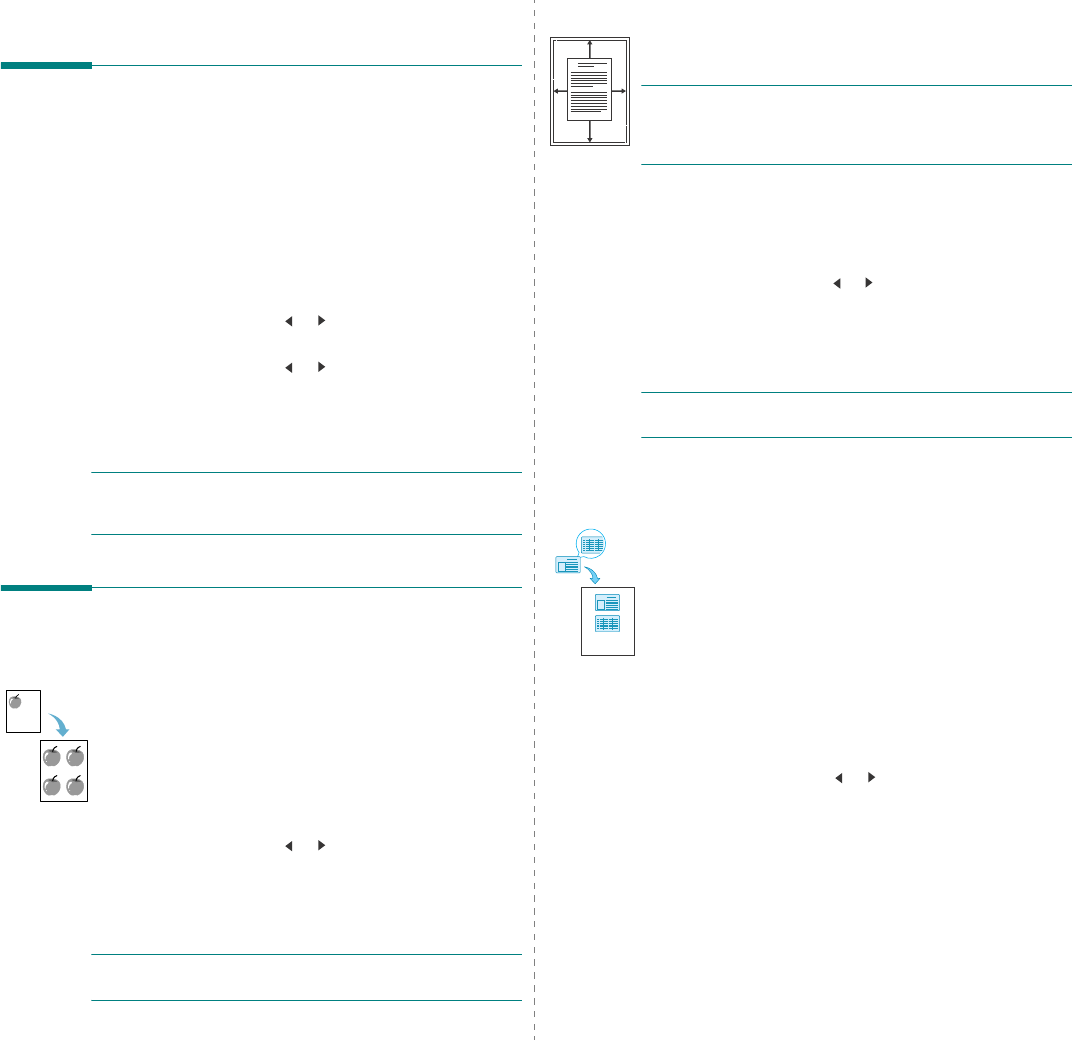
Copying
4.
2
3
Press
OK
to save the selection.
Changing the default settings
The copy options, including darkness, original type, copy size
and number of copies, can be set to the most frequently used
modes. When you copy a document, the default settings are
used unless they are changed by using the menus on the
control panel.
To create your own default settings:
1
Press
Menu
until
Copy Setup
appears on the top line of
the display.
2
Press
OK
when
Default-Change
appears.
3
Press the scroll button ( or ) to select a setup option
and press
OK
.
4
Press the scroll button ( or ) to change the setting or
enter the value and press
OK
.
5
Repeat steps 3 through 4, as needed.
6
Press
Stop/Clear
to return to Standby mode.
NOTE
: While you are setting copy options, pressing
Stop/
Clear
cancels the changed settings and restores their default
status.
Using special copy features
Clone copying
This feature prints multiple image copies from the original
document on a single page. The number of images is
automatically determined by the original image and paper size.
1
Place the document to be copied on the document glass,
and close the cover.
2
Press
Menu
until
Special Copy
appears on the top line of
the display.
3
Press the scroll button ( or ) until
Clone
appears and
press
OK
.
4
Customize the copy settings including copy size, darkness,
and original type, by using the control panel buttons. See
page 4.1.
NOTE
: You cannot adjust the copy size using the
Reduce/
Enlarge
menu while making a clone copy.
5
Press
Start
to begin copying.
Auto Fit copying
This feature automatically reduces or enlarges the original
image to fit on the paper currently loaded in the machine.
NOTE
: When the size of the document you want to copy is not
same as the size of the paper loaded, this function
automatically adjusts the size of the document to fit the paper.
You can not adjust the copy size manually.
1
Load the document to be copied on the document glass,
and close the cover.
2
Press
Menu
until
Special Copy
appears on the top line of
the display.
3
Press the scroll button ( or ) until
Auto Fit
appears and
press
OK
.
4
Customize the copy settings including copy size, darkness,
and original type, by using the control panel buttons. See
page 4.1.
NOTE
: You cannot adjust the copy size using the
Reduce/
Enlarge
menu while Auto Fit copying is enabled.
5
Press
Start
to begin copying.
ID Card copying
You can copy both sides of the ID Card like a drivers licence to
a single side of paper.
When you copy using this feature, the machine prints one side
of the card on the upper half of the paper and the other side on
the lower half without reducing the size of the original.
If the loaded card is larger than the printable area, some
portions may not be printed.
1
Place the ID Card to be copied on the document glass and
close the cover.
2
Press
Menu
until
Special Copy
appears on the top line of
the display.
3
Press the scroll button ( or ) until
ID Card copy
appears and press
OK
.
4
Customize the copy settings including copy size, darkness,
and original type, by using the control panel buttons. See
page 4.1.
5
Press
Start
to begin copying.
Your machine begins scanning the front side and display
Set Backside
.
6
Open the document cover and flip the document over.
Close the cover.
A
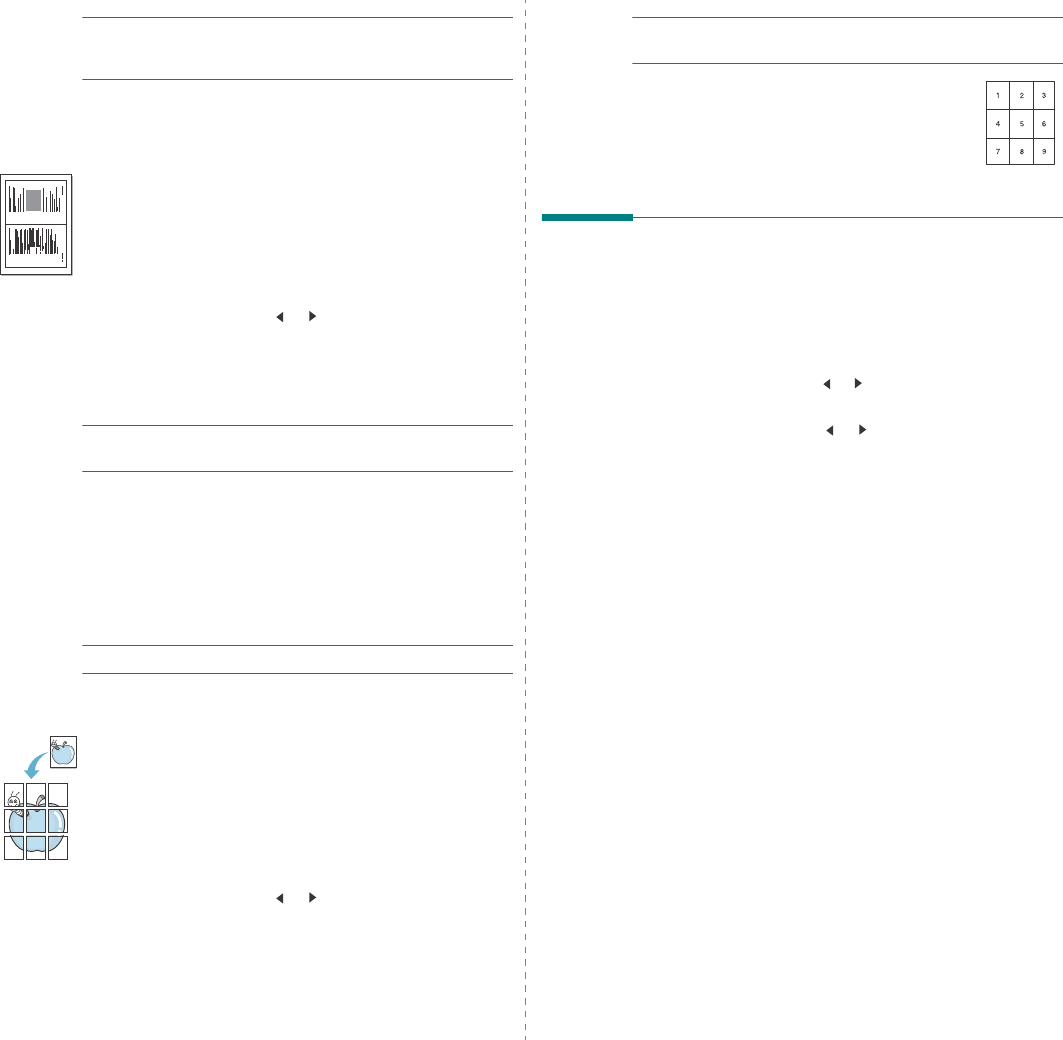
Copying
4.
3
NOTE
: If you press
Stop/Clear
or no buttons are pressed for
approximately 30 seconds, the machine cancels the copy job
and returns to Standby mode.
7
Press
Start
to begin copying.
2-UP copying
This feature prints 2 original images reduced to fit onto one
sheet of paper.
1
Place the document to be copied on the document glass
and close the cover.
2
Press
Menu
until
Special Copy
appears on the top line of
the display.
3
Press the scroll button ( or ) until
2-UP
appears and
press
OK
.
4
Customize the copy settings including copy size, darkness,
and original type, by using the control panel buttons. See
page 4.1.
NOTE
: You cannot adjust the copying size using the
Reduce/
Enlarge
menu while making a 2-UP copying.
5
Press
Start
to begin copying.
Your machine begins scanning the front side and display
Set Next Page Press Start
.
6
Place the second document to be copied on the document
glass.
7
Press
Start
to begin copying.
NOTE
: 2-UP copying reduces your original document by 50%.
Poster copying
This feature prints an image onto 9 sheets of paper (3x3). You
can paste the printed pages together to make one poster-sized
document.
1
Place the document to be copied on the document glass
and close the cover.
2
Press
Menu
until
Special Copy
appears on the top line of
the display.
3
Press the scroll button ( or ) until
Poster
appears and
press
OK
.
4
Customize the copy settings including copy size, darkness,
and original type, by using the control panel buttons. See
page 4.1.
5
Press
Start
to begin copying.
1 2
NOTE
: You cannot adjust the copy size using the
Reduce/
Enlarge
menu while making a poster.
Your original document is divided into 9
portions. Each portion is scanned and printed
one by one in the following order:
Setting the time out option
You can set the time the machine waits before it restores the
default copy settings, if you do not start copying after changing
them on the control panel.
1
Press
Menu
until
Copy Setup
appears on the top line of
the display.
2
Press the scroll button ( or ) until
Timeout
appears and
press
OK
.
3
Press the scroll button ( or ) to select the time setting
you want.
Selecting
Off
means that the machine does not restore the
default settings until you press
Start
to begin copying, or
Stop/Clear
to cancel.
4
Press
OK
to save your selection.
5
press
Stop/Clear
to return to Standby mode.
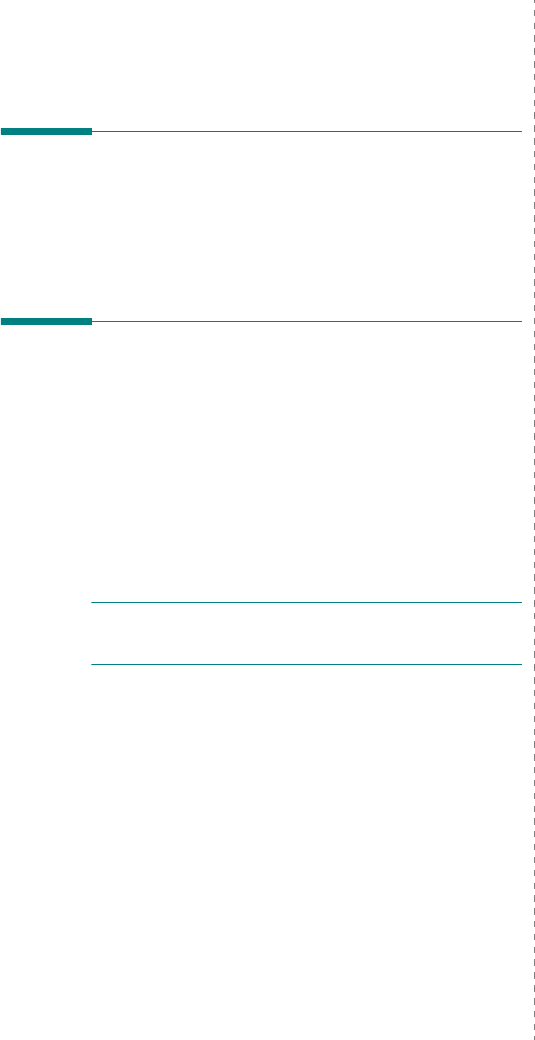
Basic printing
5.
1
5Basic printing
This chapter explains common printing tasks.
Printing a document
This printer allows you to print from various Windows
applications, a Macintosh computer, or a Linux system. The
exact steps for printing a document may vary depending on the
application you use.
For details about printing, see the
Software Section
.
Canceling a print job
If the print job is waiting in a print queue or print spooler, such
as the printer group in Windows, delete the job as follows:
1
Click the Windows
Start
button.
2
For Windows 98/2000/Me, select
Settings
and then
Printers
.
For Windows XP, select
Printers and Faxes
.
3
Double-click the
Samsung SCX-4200 Series
icon.
4
From the
Document
menu, select
Cancel Printing
(Windows 98/Me) or
Cancel
(Windows 2000/XP).
NOTE
: You can also access this window by simply double-
clicking the printer icon at the bottom right corner of the
Windows desktop.
You can also cancel the current job by pressing
Stop/Clear
on
the
control panel
of your machine.

Scanning
6.
1
6Scanning
Scanning with your machine lets you turn pictures and text into
digital files on your computer. Then you can upload them on
your web site or use them to create projects that you can print
using Samsung SmarThru program or the WIA driver.
Scanning basics
Your machine offers the following ways to scan an image:
• From TWAIN-compliant software: You can use other
software including Adobe Photoshop Deluxe and Adobe
Photoshop.
• From the Windows Images Acquisition (WIA) driver: Your
machine supports the WIA driver for scanning images.
• From the Samsung SmarThru software: Launch Samsung
SmarThru and open Scan To to begin scanning.
NOTE
: To scan with your machine, you must install the
software. For details about installing the software, see the
Software Section
.
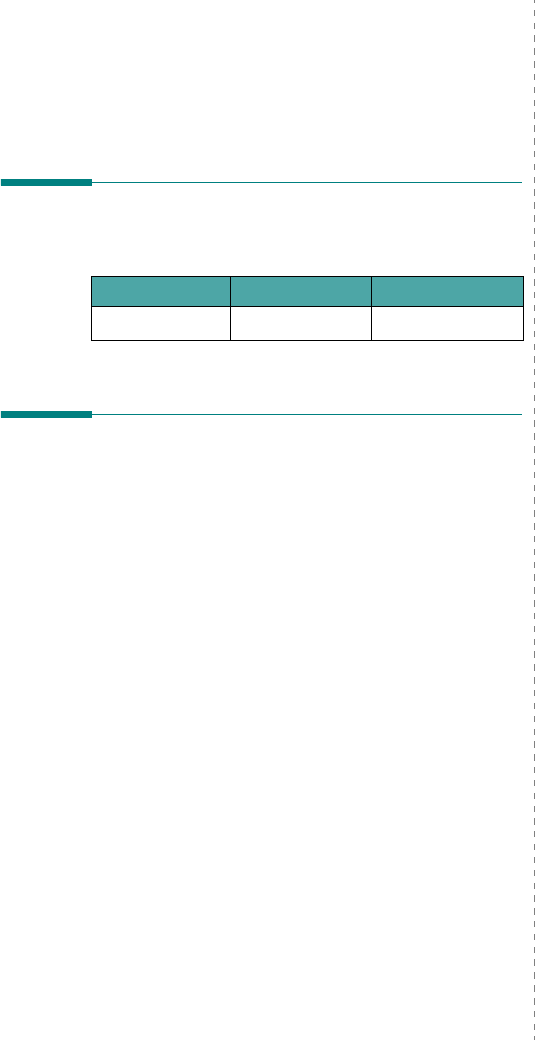
Ordering toner cartridge
7.
1
7Ordering toner
cartridge
This chapter provides information on purchasing toner
cartridges available for your machine.
Toner cartridges
When the toner runs out, you can order the following type of
toner cartridges for your machine:
How to purchase
To order Samsung-authorized toner cartridges, contact your
local Samsung dealer or the retailer where you purchased your
machine, or visit www.samsungprinter.com and select your
country/region for information on calling for technical support.
Type Yield
a
a. ISO 19752 5% coverage
Part number
Standard 3,000 pages SCX-D4200A
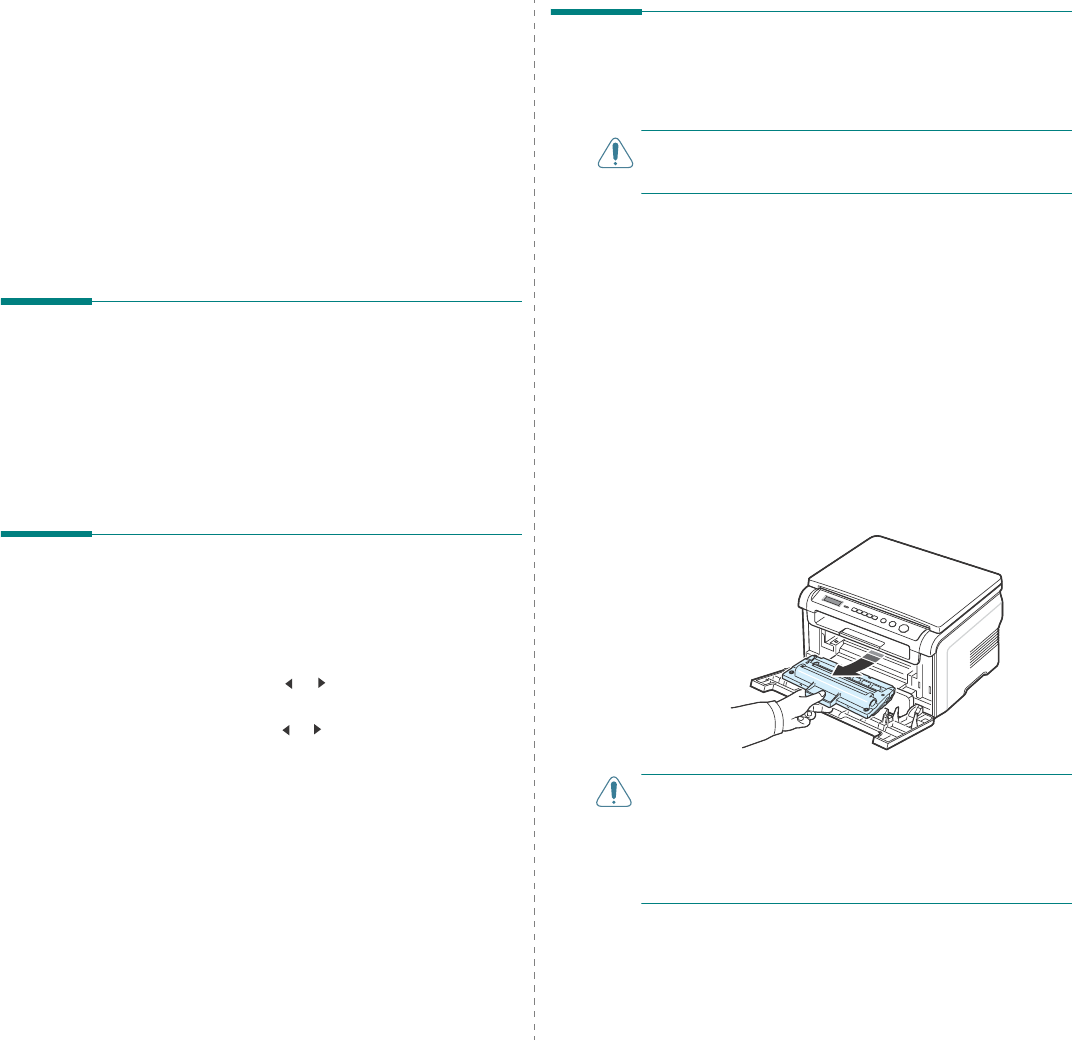
Maintenance
8.
1
8Maintenance
This chapter provides information for maintaining your machine
and the toner cartridge.
This chapter includes:
• Printing reports
• Clearing memory
• Cleaning your machine
• Maintaining the toner cartridge
• Consumable and replacement parts
Printing reports
Your machine can print report containing system data
information.
1
Press
Menu
until
Report
appears on the top line of the
display.
2
Press
OK
when
System Data
appears.
The system data information prints out.
Clearing memory
You can selectively clear information stored in your machine’s
memory.
1
Press
Menu
until
Maintenance
appears on the top line of
the display.
2
Press the scroll button ( or ) until
Clear Settings
appears and press
OK
.
3
Press the scroll button ( or ) to select the item you want
to clear.
•
Paper Setting
: Resets all of the Paper Setting options
to the factory default.
•
Copy Setup
: Resets all of the Copy Setup options to the
factory default.
•
All Settings
: Resets all of your settings to the factory
default.
•
Machine Setup
: Resets all of the system settings, such
as the display language and save mode, to the factory
default.
4
Press
OK
to confirm clearing. The selected setting is
cleared.
5
Repeat steps 3 through 4 to clear another setting.
6
Press
Stop/Clear
to return to Standby mode.
Cleaning your machine
To maintain print and scan quality, follow the cleaning
procedures below each time the toner cartridge is replaced or
if print and scan quality problems occur.
CAUTION
: Cleaning the cabinet of the machine with cleaning
materials containing large amounts of alcohol, solvent, or
other strong substances can discolor or crack the cabinet.
Cleaning the outside
Clean the cabinet of the machine with a soft lint-free cloth. You
can dampen the cloth slightly with water, but be careful not to
let any water drip onto or into the machine.
Cleaning the inside
During the printing process, paper, toner, and dust particles can
accumulate inside the machine. This buildup can cause print
quality problems, such as toner specks or smearing. Cleaning
the inside of the machine clears or reduces these problems.
1
Turn the machine off and unplug the power cord. Wait for
the machine to cool down.
2
Open the front cover and pull the toner cartridge out. Set
it on a clean flat surface.
CAUTION
:
• To prevent damage to the toner cartridge, do not expose it
to light for more than a few minutes. Cover it with a piece of
paper, if necessary.
• Do not touch the green surface underside of the toner
cartridge. Use the handle on the toner cartridge to avoid
touching this area.
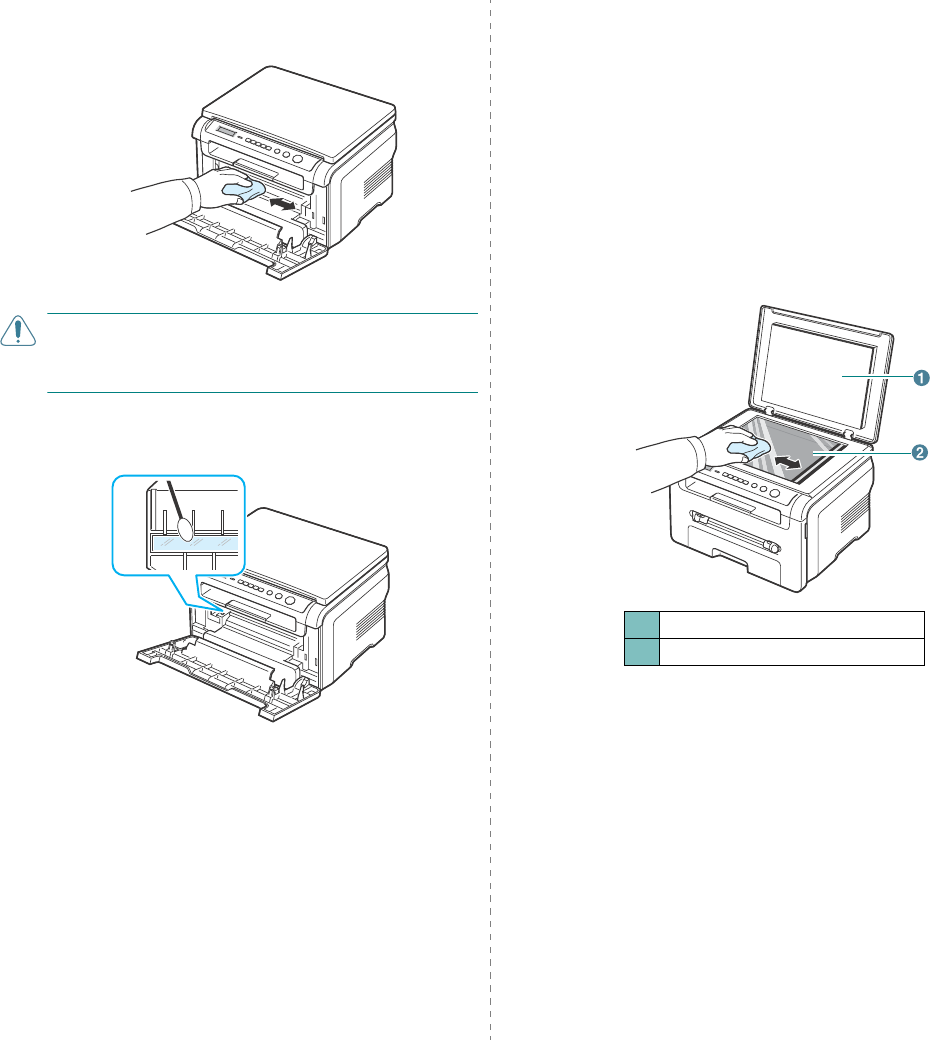
Maintenance
8.
2
3
With a dry lint-free cloth, wipe away any dust and spilled
toner from the toner cartridge area and the toner cartridge
cavity.
CAUTION
: While cleaning the inside of the machine, be careful
not to touch the transfer roller, located underneath the toner
cartridge. Oil from your fingers can cause print scan quality
problems.
4
Locate the long strip of glass (LSU) inside the top of the
toner cartridge compartment, and gently swab the glass to
see if dirt turns the white cotton black.
5
Reinsert the toner cartridge and close the front cover.
6
Plug in the power cord and turn the machine on.
Cleaning the drum
If there are streaks or spots on your print, the OPC drum of the
toner cartridge may require cleaning.
1
Before starting the cleaning procedure, make sure that
paper is loaded in the machine.
2
Press
Menu
until
Maintenance
appears on the top line of
the display.
3
Press
OK
when
Clean Drum
appears.
The machine prints out a cleaning page. Toner particles on
the drum surface are affixed to the paper.
4
If the problem remains, repeat steps 1 through 3.
Cleaning the scan unit
Keeping the scan unit clean helps ensure the best possible
copies. We suggest that you clean the scan unit at the start of
each day and during the day, as needed.
1
Slightly dampen a soft lint-free cloth or paper towel with
water.
2
Open the document cover.
3
Wipe the surface of the document glass until it is clean and
dry.
4
Wipe the underside of the document cover until it is clean
and dry.
5
Close the document cover.
1
document cover
2
document glass
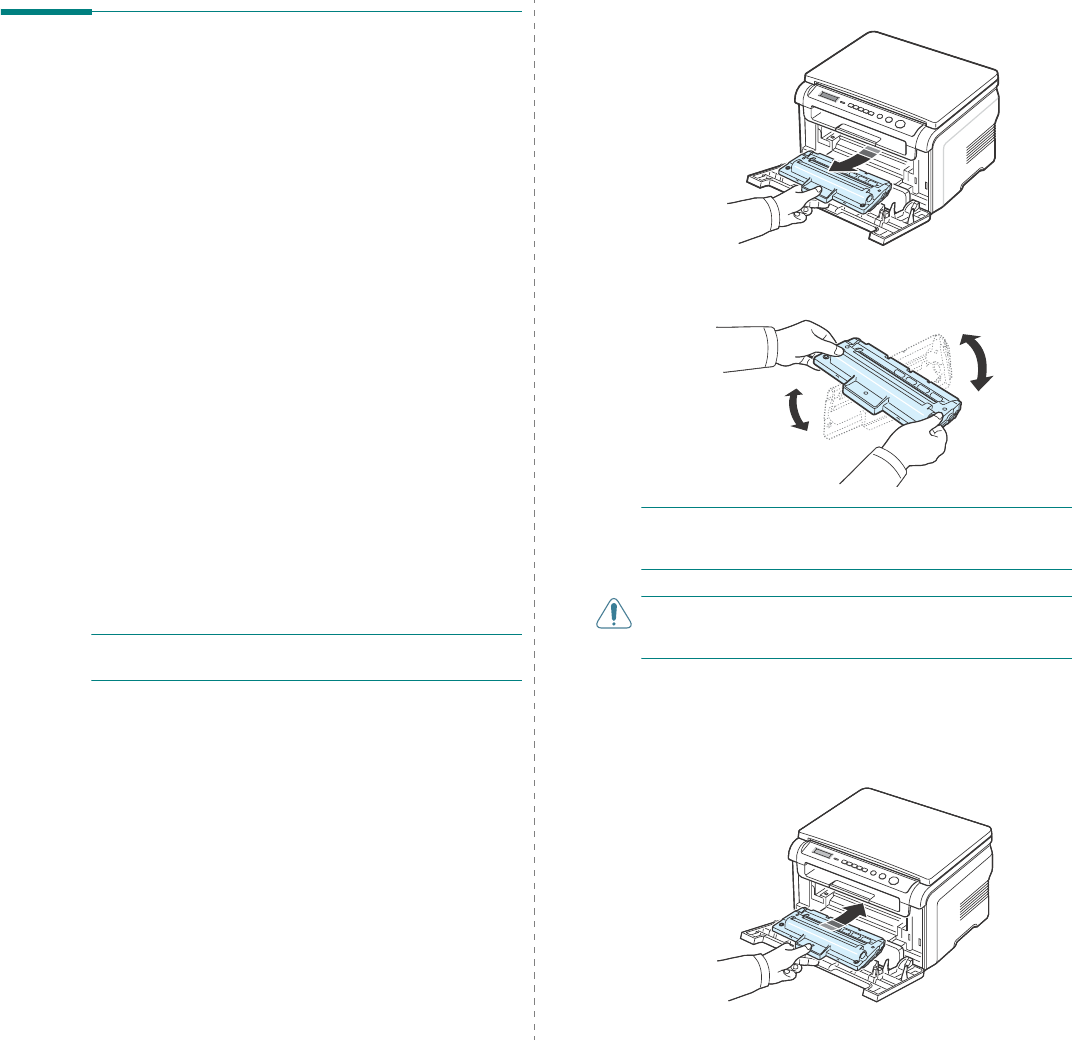
Maintenance
8.
3
Maintaining the toner cartridge
Toner cartridge storage
To get the most from the toner cartridge, keep the following
guidelines in mind:
• Do not remove the toner cartridge from its package until
ready for use.
• Do not refill the toner cartridge.
The machine warranty
does not cover damage caused by using a refilled
toner cartridge
.
• Store toner cartridges in the same environment as your
machine.
• To prevent damage to the toner cartridge, do not expose it
to light for more than a few minutes.
Saving toner
To save toner, press
Menu
until
Toner Save
appears and then
press
OK
when
On
appears. Using this feature extends the life
of the toner cartridge and reduces your cost per page, but it
also reduces print quality.
Expected toner cartridge life
The life of the toner cartridge depends on the amount of toner
that print jobs require. When printing text at ISO 19752 5%
coverage, a new toner cartridge lasts an average of 3,000
pages. (The original toner cartridge supplied with the machine
lasts an average of 1,000 pages.) The actual number may be
different depending on the print density of the page you print.
If you print a lot of graphics, you may need to change the toner
cartridge more often.
NOTE
: The 1,000 pages and 3,000 pages toner cartridge have
different shapes.
Redistributing the toner cartridge
When the toner cartridge is near the end of its life:
• White streaks or light printing occurs.
•The warning message,
Toner Low
displays on the control
panel.
• The Smart Panel program window appears on the computer
telling you that the toner cartridge is low on toner.
•The
Status
LED blinks red.
If this happens, you can temporarily reestablish print quality by
redistributing the remaining toner in the toner cartridge. In
some cases, white streaks or light printing will still occur even
after you have redistributed the toner.
1
Open the front cover.
2
Pull the toner cartridge out.
3
Thoroughly roll the toner cartridge 5 or 6 times to
distribute the toner evenly inside the toner cartridge.
NOTE
: If toner gets on your clothing, wipe it off with a dry
cloth and wash clothing in cold water. Hot water sets toner into
fabric.
CAUTION
: Do not touch the green underside of the toner
cartridge. Use the handle on the toner cartridge to avoid
touching this area.
4
Hold the toner cartridge by the handle and slowly insert
the toner cartridge into the opening in the machine.
5
Tabs on the sides of the toner cartridge and corresponding
grooves within the machine will guide the toner cartridge
into the correct position until it locks into place completely.
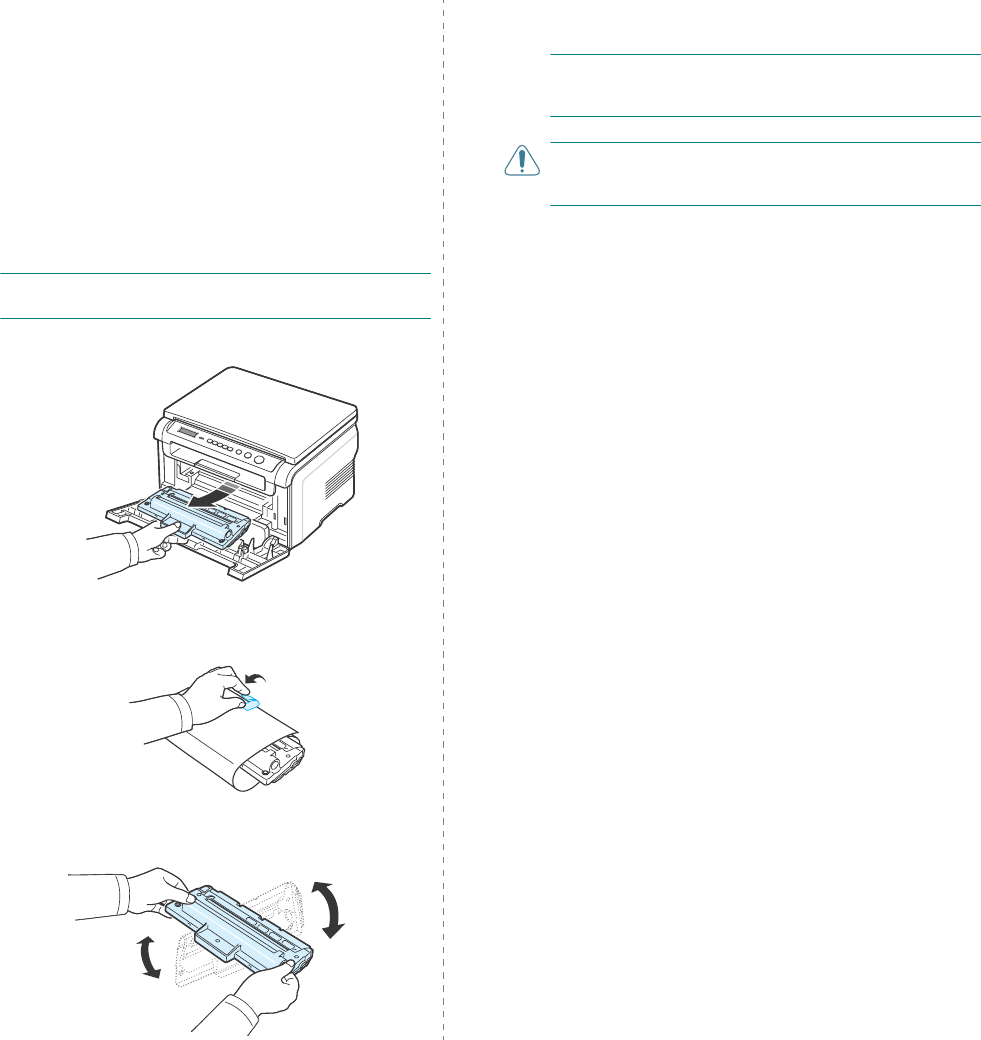
Maintenance
8.
4
6
Close the front cover. Make sure that the cover is securely
closed.
Replacing the toner cartridge
When the toner cartridge is completely empty:
•The warning message,
Toner Empty
or
[Toner Empty]
Replace Toner
displays on the control panel.
• The Smart Panel program window appears on the computer
telling you that the toner cartridge is empty.
•The
Status
LED lights red.
At this stage, the
toner cartridge
needs to be replaced. For
order information for toner cartridges, see page 7.1.
NOTE
: This feature does not work for the
[Toner Empty]
Replace Toner
message.
7
Pull the toner cartridge out.
8
Remove the new toner cartridge from its bag.
9
Remove the paper protecting the toner cartridge.
10
Roll the toner cartridge 5 or 6 items to distribute the toner
evenly inside the toner cartridge.
Thoroughly rolling the toner cartridge will assure
maximum copies per toner cartridge.
NOTE
: If toner gets on your clothing, wipe it off with a dry
cloth and wash clothing in cold water. Hot water sets toner into
fabric.
CAUTION
: Do not touch the green underside of the toner
cartridge. Use the handle on the toner cartridge to avoid
touching this area.
11
Hold the toner cartridge by the handle and slowly insert
the toner cartridge into the opening in the machine.
12
Tabs on the sides of the toner cartridge and corresponding
grooves within the machine will guide the toner cartridge
into the correct position until it locks into place completely.
13
Close the front cover. Make sure that the cover is securely
closed.
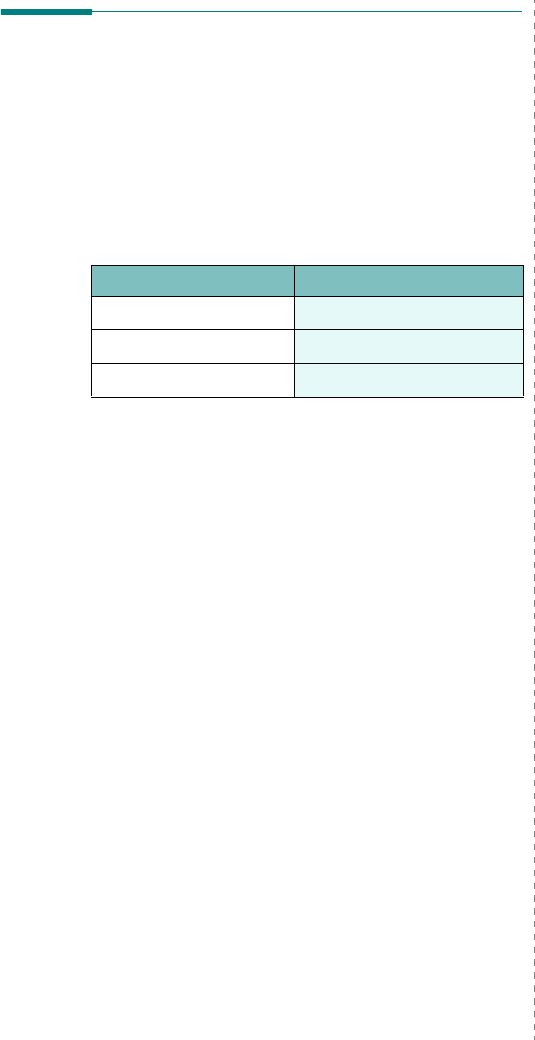
Maintenance
8.
5
Consumable and replacement
parts
From time to time, you needs to replace the toner cartridge,
roller, and fuser unit to maintain top performance and to avoid
print quality problems and paper feed problems resulting from
worn parts. The Smart Panel program window will appear on
the computer, indicating which item needs to be replaced.
The following items should be replaced after you have printed
the specified number of pages, or when the life span of each
item has expired. The Smart Panel program window will appear
on the computer, indicating which item needs to be replaced.
To purchase consumable and replacement parts, contact your
Samsung dealer or the retailer where you bought your
machine. We strongly recommend that these items be installed
by a trained service professional, except for the toner cartridge
(see page 8.4).
Items Yield (Average)
Transfer roller Approx. 50,000 pages
Fuser unit Approx. 50,000 pages
Paper feeding roller Approx. 50,000 pages
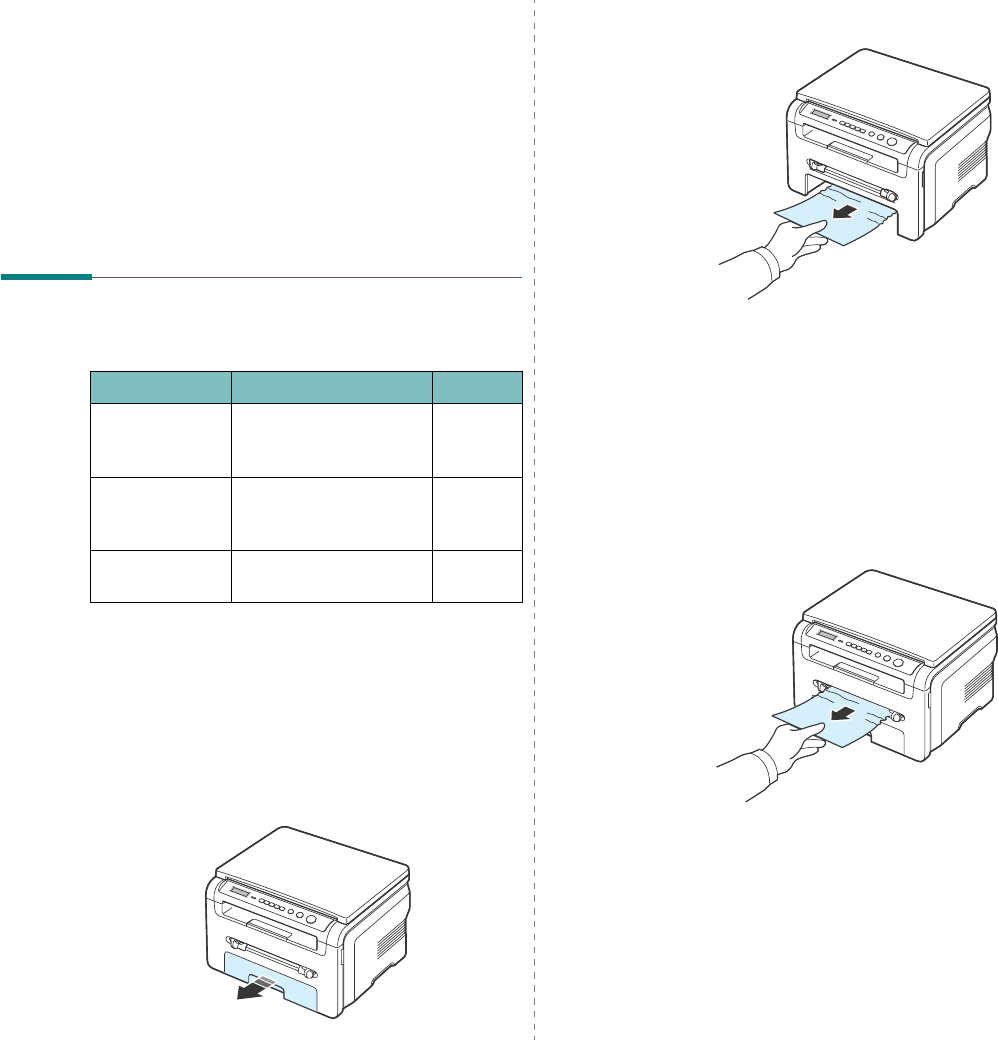
Troubleshooting
9.
1
9Troubleshooting
This chapter gives helpful information for what to do if you
encounter an error.
This chapter includes:
• Clearing paper jams
• Understanding the Status LED
• Understanding display messages
• Solving other problems
Clearing paper jams
When a paper jam occurs,
Paper Jam
appears on the display.
Refer to the table below to locate and clear the paper jam.
To avoid tearing the paper, pull out the jammed paper gently
and slowly. Follow the instructions in the following sections to
clear the jam.
In the paper input tray
1
Open and close the front cover. The jammed paper
automatically exits the machine.
If the paper does not exit, continue to step 2.
2
Pull the paper input tray out.
Message Location of Jam Go to
[Paper Jam 0]
Open/Close
Door
In the paper input tray below and
page 9.1
[Paper Jam 1]
Open/Close
Door
In the fuser area or around
the toner cartridge
In the manual feeder
page 9.2
[Paper Jam 2]
Check Inside
In the paper exit area page 9.2
3
Remove the jammed paper by gently pulling it straight
out.
If there is any resistance and the paper does not move
when you pull, or if you cannot see the paper in this area,
check the fuser area around the toner cartridge. See
page 9.2.
4
Insert the paper input tray into the machine until it snaps
into place.
5
Open and close the front cover to resume printing.
In the manual feeder
1
If the paper is not feeding properly, pull the paper out of
the machine.
2
To resume printing, open and close the front cover.
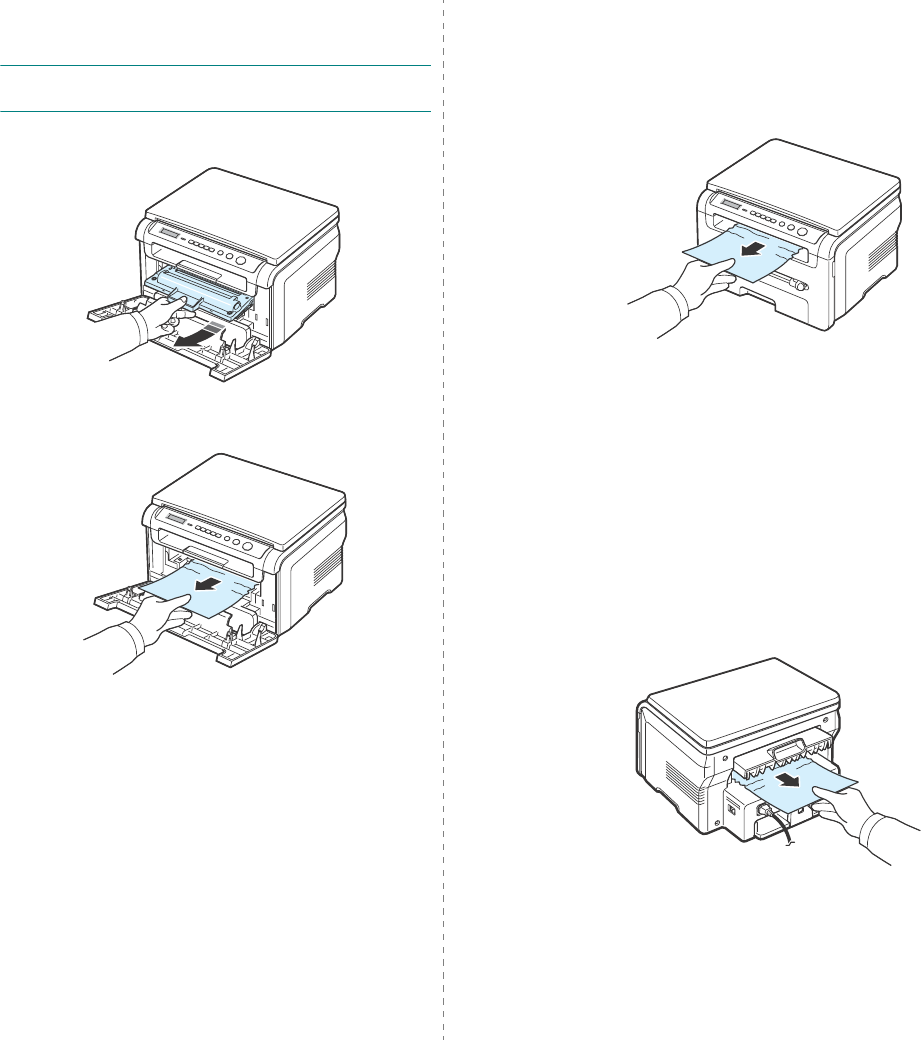
Troubleshooting
9.
2
In the fuser area or around the toner
cartridge
NOTE
: The fuser area is hot. Take care when removing paper
from the machine.
1
Open the front cover and pull the toner cartridge out.
2
Remove the jammed paper by gently pulling it straight
out.
3
Replace the toner cartridge and close the front cover.
Printing automatically resumes.
In the paper exit area
1
Open and close the front cover. The jammed paper
automatically exits the machine.
If the paper does not exit, continue to step 2.
2
Gently pull the paper out of the output tray. Skip to step 9.
If you cannot see the jammed paper in the output tray,
continue to the next step.
3
Lift the scan unit.
4
Pull the jammed paper out gently.
5
Close the scan unit by pushing a tab to the left and hold it
down and lowering the cover carefully until the cover is
holding down the tab.
If there is any resistance and the paper does not move
when you pull or if you cannot see the paper under the
scan unit, continue to the next step.
6
Open the rear cover.
7
Remove the jammed paper by gently pulling it straight
out.
8
Close the rear cover.
9
Open and close the front cover to resume printing.
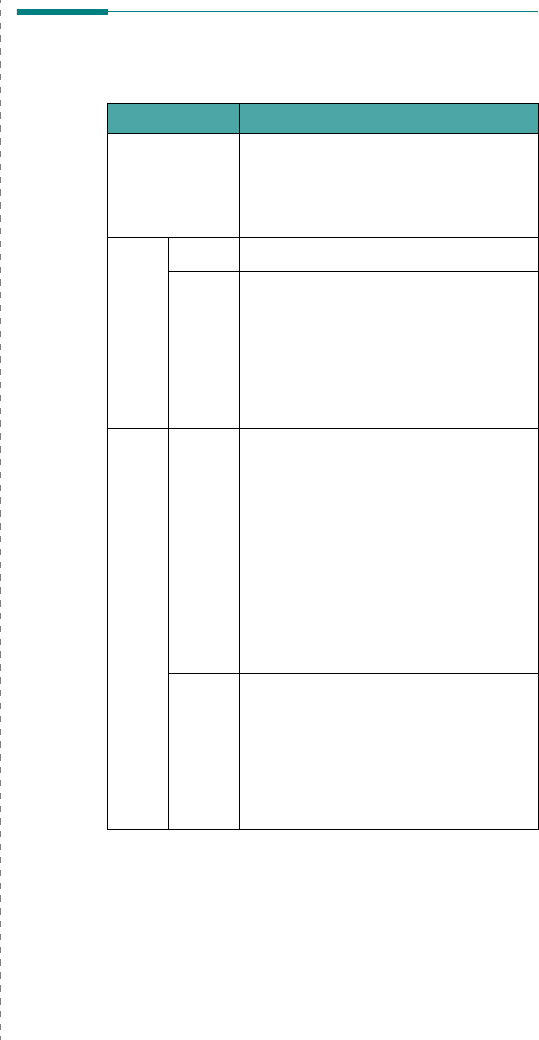
Troubleshooting
9.
3
Tips for avoiding paper jams
By selecting the correct paper types, most paper jams can be
avoided. When a paper jam occurs, follow the steps outlined in
page 9.1.
• Follow the procedures in page 2.3. Ensure that the
adjustable guides are positioned correctly.
• Do not overload the paper input tray. Ensure that the paper
is below the paper capacity mark on the inside wall of the
paper input tray.
• Do not remove paper from the paper input tray while your
machine is printing.
• Flex, fan, and straighten the paper before loading.
• Do not use creased, damp, or highly curled paper.
• Do not mix paper types in the paper input tray.
• Use only recommended print materials. See page 3.2.
• Ensure that the recommended print side of print materials is
facing down in the paper input tray and facing up in the
manual feeder.
Understanding the Status LED
The
Status
LED on the control panel shows the status of your
machine. See the table below to know your machine’s status.
Status Description
Off • The machine is off-line.
• The machine is in Power Save mode.
When data is received, or any button is
pressed, it switches to on-line
automatically.
Green On The machine is on-line and can be used.
Blinking • When the backlight slowly blinks, the
machine is receiving data from the
computer.
• When the backlight normally blinks, the
machine is scanning the loaded
document.
• When the backlight fast blinks, the
machine is printing data.
Red On • The toner cartridge is totally exhausted.
Remove the old toner cartridge and
install a new one. See page 8.4.
• A paper jam has occurred. To solve the
problem, see page 9.1.
• The front cover is open. Close the front
cover.
• There is no paper in the paper input
tray. Load paper in the paper input tray.
• The machine has stopped due to a major
error. Check the display message. See
page 9.4 for details on the meaning of
the error message.
Blinking • A minor error occurs and the machine is
waiting an error to be cleared. Check the
display message. When the problem is
cleared, the machine resumes.
• The toner cartridge is low. Order a new
toner cartridge. You can temporarily
improve print quality by redistributing
the toner. See page 8.4.
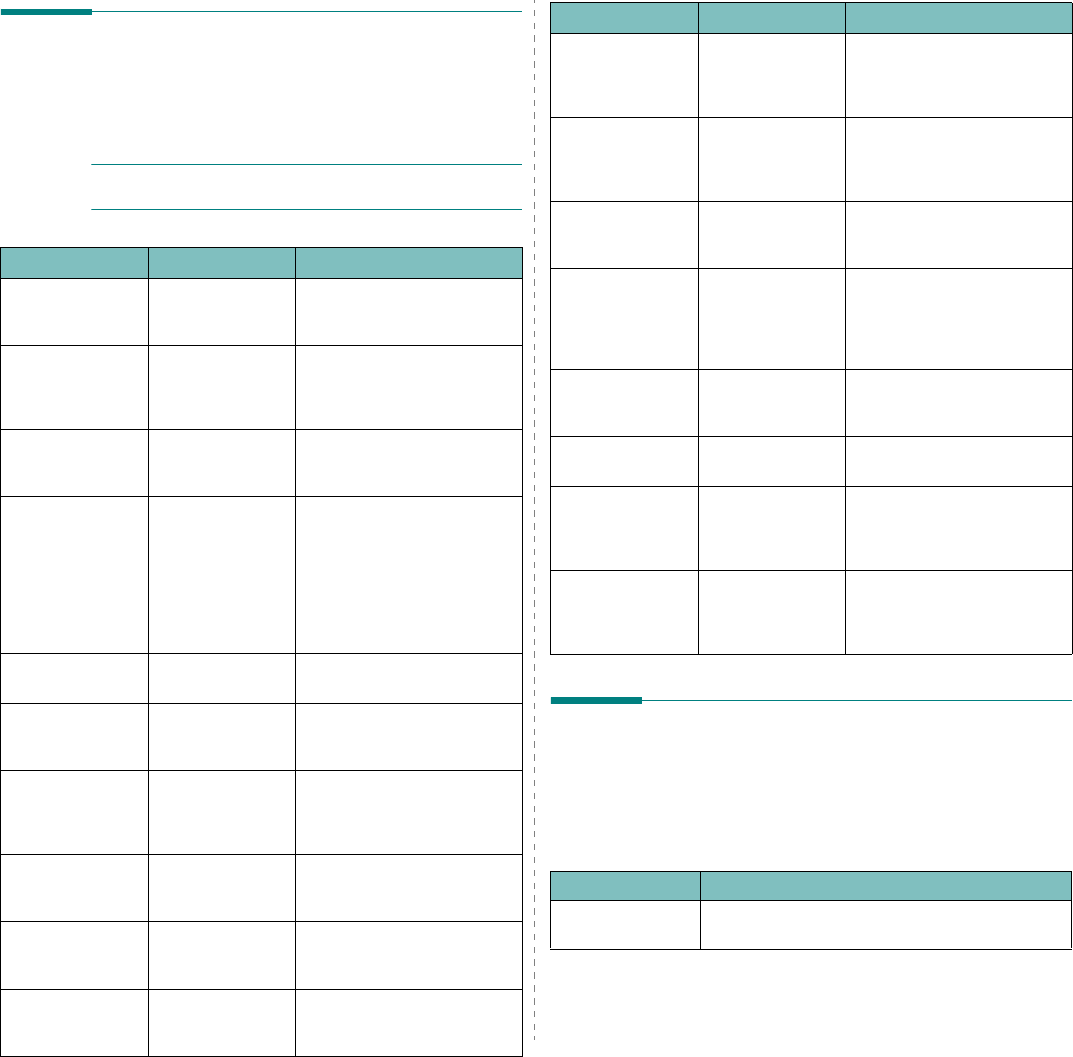
Troubleshooting
9.
4
Understanding display messages
Messages appear on the Smart Panel program window or the
control panel display to indicate the machine’s status or errors.
Refer to the tables below to understand the messages’ meaning
and correct the problem if necessary. Messages and their
meanings are listed in alphabetical order.
NOTE
: When you call for service, it is very convenient to tell
the service representative the display message.
Display Meaning Suggested solutions
Door Open
The front cover or
rear cover is not
securely latched.
Close the cover until it locks
into place.
Hsync Error
A problem has
occurred in the LSU
(Laser Scanning
Unit).
Unplug the power cord and plug
it back in. If the problem
persists, please call for service.
Invalid
Cartridge
You have used an
unauthorized
cartridge.
You must use a Samsung
approved cartridge.
No Cartridge
• You have used an
unauthorized
cartridge.
• The toner
cartridge you
have installled is
not for your
machine.
• You must use a Samsung
approved cartridge.
• Install a Samsung genuine
toner cartridge, designed for
your machine.
[Jam 1] or [No
Cartridge]
The toner cartridge
is not installed.
Install the toner cartridge. See
page 2.2.
Low Heat Error
There is a problem
in the fuser unit.
Unplug the power cord and plug
it back in. If the problem
persists, please call for service.
[LSU Error]
A problem has
occurred in the LSU
(Laser Scanning
Unit).
Unplug the power cord and plug
it back in. If the problem
persists, please call for service.
[No Paper]
Add Paper
The paper in the
paper input tray
has run out.
Load paper in the paper input
tray. See page 2.3.
Open Heat Error
There is a problem
in the fuser unit.
Unplug the power cord and plug
it back in. If the problem
persists, please call for service.
[Over Heat]
There is a problem
in the fuser unit.
Unplug the power cord and plug
it back in. If the problem
persists, please call for service.
Solving other problems
The following chart lists some conditions that may occur and
the recommended solutions. Follow the suggested solutions
until the problem is corrected. If the problem persists, please
call for service.
Paper feeding problems
[Paper Jam 0]
Open/Close
Door
Paper has jammed
in the feeding area
of the paper input
tray.
Clear the jam. See page 9.1.
[Paper Jam 1]
Open/Close
Door
Paper has jammed
in the fuser area or
in the manual
feeder.
Clear the jam. See page 9.2.
[Paper Jam 2]
Check Inside
Paper has jammed
in the paper exit
area.
Clear the jam. See page 9.2.
Power Failure
Power has turned
off then on and the
machine’s memory
has not been back
up.
The job which you were trying
to do before the power failure
must be completely re-done.
Scanner Error
There is a problem
in the scanner unit.
Unplug the power cord and plug
it back in. If the problem
persists, please call for service.
Toner Empty
The toner cartridge
has run out.
Replace the toner cartridge with
a new one. See page 8.4.
[Toner Empty]
Replace Toner
The toner cartridge
has run out. The
printer stops
printing.
Replace the toner cartridge with
a new one. See page 8.4.
Toner Low
The toner is almost
empty.
Take out the toner cartridge
and gently shake it. By doing
this, you can temporarily
reestablish printing operations.
Display Meaning Suggested solutions
Condition Suggested solutions
Paper is jammed
during printing.
Clear the paper jam. See page 9.1.
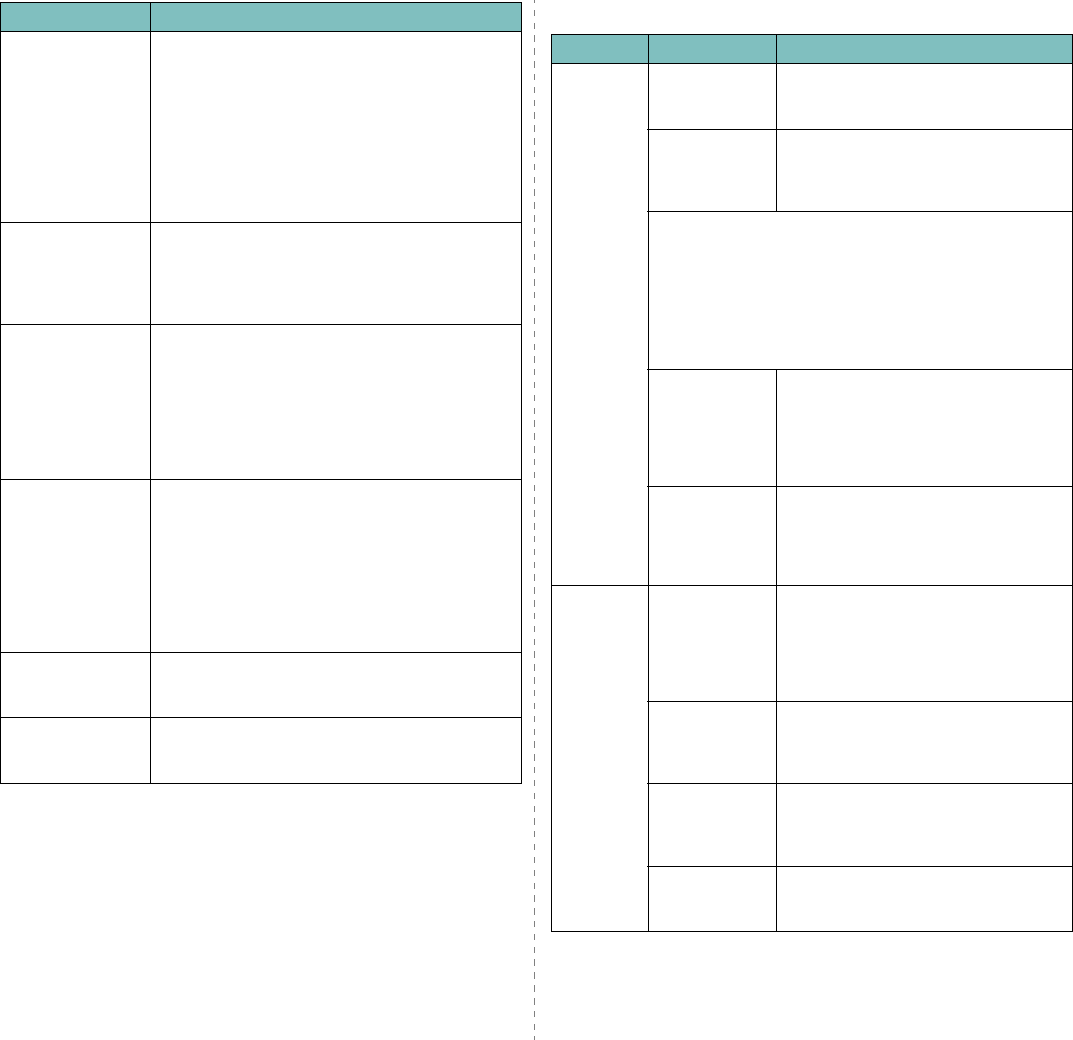
Troubleshooting
9.
5
Paper sticks
together.
• Ensure that there is not too much paper in the
paper input tray. The paper input tray can hold up
to 250 sheets of paper, depending on the thickness
of your paper.
• Make sure that you are using the correct type of
paper. See page 3.2.
• Remove paper from the paper input tray and flex or
fan the paper.
• Humid conditions may cause some paper to stick
together.
Multiple sheets of
paper do not feed.
• Different types of paper may be stacked in the
paper input tray. Load paper of only one type, size,
and weight.
• If multiple sheets have caused a paper jam, clear
the paper jam. See page 9.1.
Paper does not feed
into the machine.
• Remove any obstructions inside the machine.
• Paper has not been loaded correctly. Remove paper
from the paper input tray and reload it correctly.
• There is too much paper in the paper input tray.
Remove excess paper from the paper input tray.
• The paper is too thick. Use only paper that meets
the specifications required by the machine. See
page 3.2
.
The paper keeps
jamming.
• There is too much paper in the paper input tray.
Remove excess paper from the tray. If you are
printing on special materials, use the manual
feeder.
• An incorrect type of paper is being used. Use only
paper that meets the specifications required by the
machine. See page 3.2.
• There may be debris inside the machine. Open the
front cover and remove the debris.
Transparencies stick
together in the
paper exit.
Use only transparencies specifically designed for laser
printers. Remove each transparency as it exits from
the machine.
Envelopes skew or
fail to feed
correctly.
Ensure that the paper guides are against both sides of
the envelopes.
Condition Suggested solutions
Printing problems
Condition Possible cause Suggested solutions
The
machine
does not
print.
The machine is
not receiving
power.
Check the power cord connections. Check
the power switch and the power source.
The machine is
not selected as
the default
printer.
Select
Samsung SCX-4200 Series
as
your default printer in your Windows.
Check the machine for the following:
• The front cover is not closed. - Close the front cover.
• Paper is jammed. - Clear the paper jam. See page 9.1.
• No paper is loaded. - Load paper. See page 2.3.
• The toner cartridge is not installed. - Install the toner
cartridge. See page 2.2.
If a printer system error occurs, contact your service
representative.
The connection
cable between
the computer
and the machine
is not connected
properly.
Disconnect the printer cable and
reconnect it.
The connection
cable between
the computer
and the machine
is defective.
If possible, attach the cable to another
computer that is working properly and
print a job. You can also try using a
different printer cable.
The
machine
does not
print.
(Continued)
The port setting
is incorrect.
Check the Windows printer setting to
make sure that the print job is sent to the
correct port, for example, LPT1. If the
computer has more than one port, make
sure that the machine is attached to the
correct one.
The machine
may be
configured
incorrectly.
Check the printer properties to ensure
that all of the print settings are correct.
The printer
driver may be
incorrectly
installed.
Repair the printer software. See the
Software Section
.
The machine is
malfunctioning.
Check the display message on the control
panel to see if the machine is indicating a
system error.
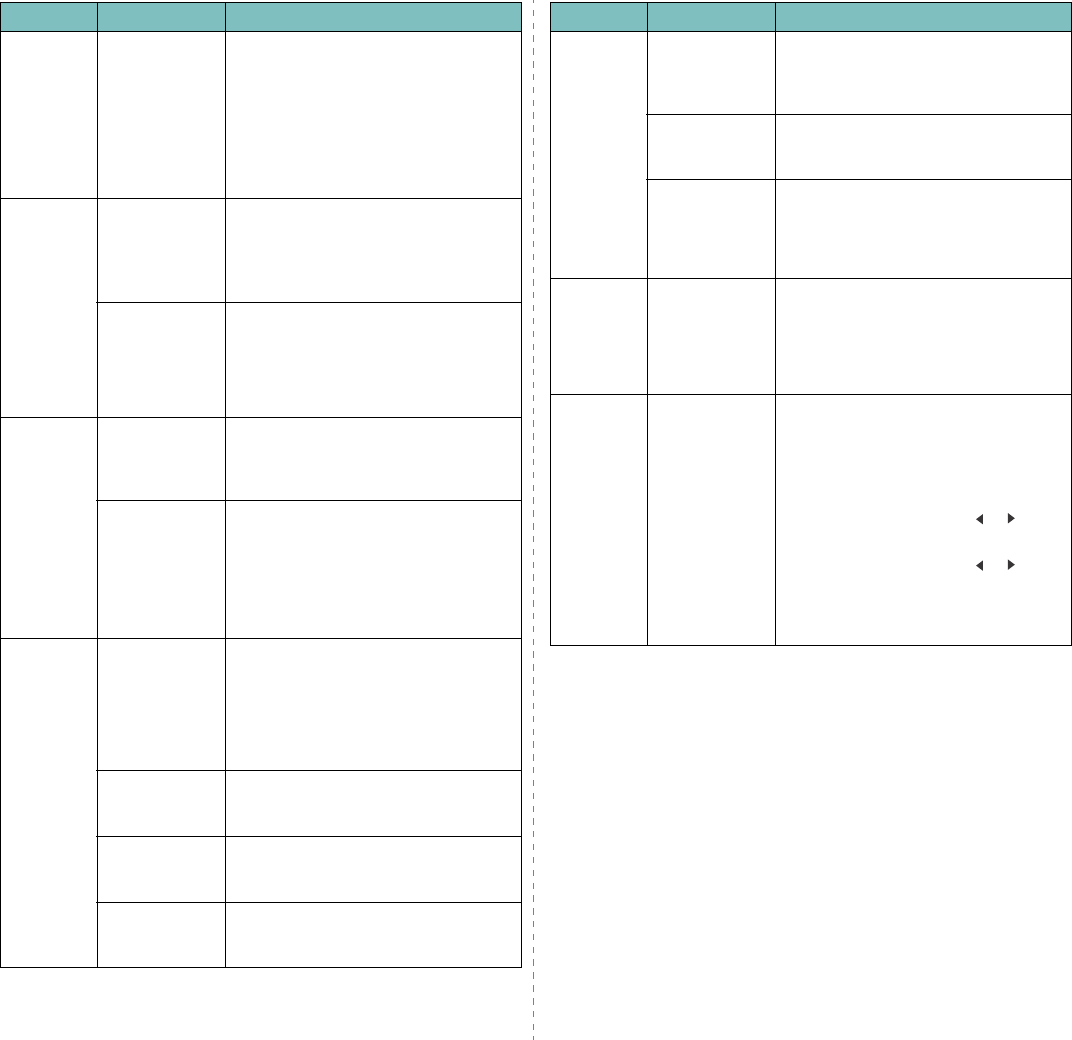
Troubleshooting
9.
6
The
machine
selects
print
materials
from the
wrong
paper
source.
The paper
source selection
in the printer
properties may
be incorrect.
For many software applications, the paper
source selection is found under the
Paper
tab within the printer properties. Select
the correct paper source. See the
Software Section
.
A print job
is
extremely
slow.
The job may be
very complex.
Reduce the complexity of the page or try
adjusting the print quality settings.
The maximum print speed of your
machine is 19 PPM for Letter-sized paper
and 18 PPM for A4-sized paper.
If you are using
Windows 98/Me,
the Spooling
Setting may be
set incorrectly.
From the
Start
menu, choose
Settings
and
Printers
. Right-click the
Samsung
SCX-4200 Series
machine icon, choose
Properties
, click the
Details
tab, and
then choose the
Spool Settings
button.
Select the desired spool setting.
Half the
page is
blank.
The page
orientation
setting may be
incorrect.
Change the page orientation in your
application. See the
Software Section
.
The paper size
and the paper
size settings do
not match.
Ensure that the paper size in the printer
driver settings matches the paper in the
paper input tray.
Or, ensure that the paper size in the
printer driver settings matches the paper
selection in the software application
settings you use.
The
machine
prints, but
the text is
wrong,
garbled, or
incomplete.
The printer
cable is loose or
defective.
Disconnect the printer cable and
reconnect. Try a print job that you have
already printed successfully. If possible,
attach the cable and the machine to
another computer and try a print job that
you know works. Finally, try a new printer
cable.
The wrong
printer driver
was selected.
Check the application’s printer selection
menu to ensure that your machine is
selected.
The software
application is
malfunctioning.
Try printing a job from another
application.
The operating
system is
malfunctioning.
Exit Windows and reboot the computer.
Turn the machine off and then back on
again.
Condition Possible cause Suggested solutions
Pages
print, but
are blank.
The toner
cartridge is
defective or out
of toner.
Redistribute the toner, if necessary. See
page 8.3.
If necessary, replace the toner cartridge.
The file may
have blank
pages.
Check the file to ensure that it does not
contain blank pages.
Some parts,
such as the
controller or the
board, may be
defective.
Contact a service representative.
The
illustrations
print
incorrectly
in Adobe
Illustrator.
The setting in
the software
application is
wrong.
Select
Download as Bit Image
in the
TrueType Options
window of the
Graphic properties and print the document
again.
An error
occurs
repeatedly
when you
are printing
with the
USB
connection.
When the USB
mode is set to
Fast
, some PC
users may
experience poor
USB
communication.
Change the USB mode to
Slow
. To do so,
follow these step:
1
Press
Menu
until
Machine Setup
appears on the top line of the
display.
2
Press the scroll button ( or ) until
USB mode
appears and press
Ok
.
3
Press the scroll button ( or ) until
Slow
appears and press
Ok
.
4
Press
Stop/Clear
to return to
standby mode.
Condition Possible cause Suggested solutions
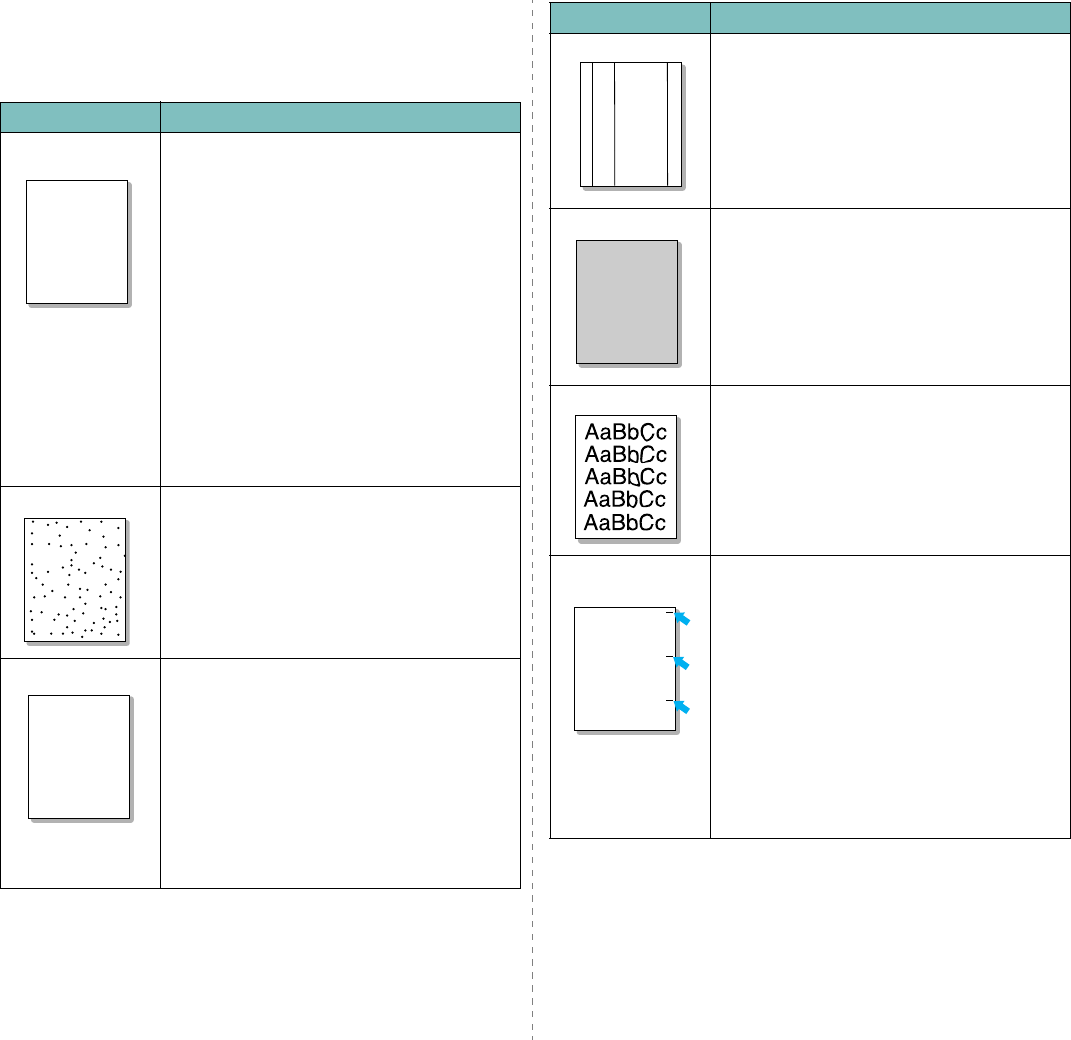
Troubleshooting
9.
7
Printing quality problems
If the inside of the machine is dirty or paper has been loaded
improperly, you may notice a reduction in print quality. See the
table below to clear the problem.
Condition Suggested solutions
Light or faded
print
If a vertical white streak or faded area appears on
the page:
• The toner supply is low. You may be able to
temporarily extend the toner cartridge life. See
page 8.3. If this does not improve the print
quality, install a new toner cartridge.
• The paper may not meet paper specifications; for
example, the paper is too moist or too rough. See
page 3.2
.
• If the entire page is light, the print resolution
setting is too low or the toner save mode is on.
Adjust the print resolution and turn the toner save
mode off. See the
Software Section
and
page 2.6, respectively.
• A combination of faded or smeared defects may
indicate that the toner cartridge needs cleaning.
See page 8.2.
• The surface of the LSU part inside the machine
may be dirty. Clean the LSU. See page 8.2.
Toner specks
• The paper may not meet specifications; for
example, the paper is too moist or too rough. See
page 3.2
.
• The transfer roller may be dirty. Clean the inside
of your machine. See page 8.1.
• The paper path may need cleaning. See page 8.2.
Dropouts
If faded areas, generally rounded, occur randomly
on the page:
• A single sheet of paper may be defective. Try
reprinting the job.
• The moisture content of the paper is uneven or
the paper has moist spots on its surface. Try a
different brand of paper. See
page 3.2
.
• The paper lot is bad. The manufacturing
processes can cause some areas to reject toner.
Try a different kind or brand of paper.
• If these steps do not correct the problem, contact
a service representative.
AaBbCc
AaBbCc
AaBbCc
AaBbCc
AaBbCc
AaBbCc
AaBbCc
AaBbCc
AaBbCc
AaBbCc
AaBbCc
AaBbCc
AaBbCc
AaBbCc
AaBbCc
Vertical lines
If black vertical streaks appear on the page:
• The drum inside the toner cartridge has probably
been scratched. Remove the toner cartridge and
install a new one. See page 8.4.
If white vertical streaks appear on the page:
• The surface of the LSU part inside the machine
may be dirty. Clean the LSU (see page 8.2).
Gray background
If the amount of background shading becomes
unacceptable:
• Change to a lighter weight paper. See
page 3.2
.
• Check the machine’s environment: very dry (low
humidity) or high humidity (higher than 80% RH)
conditions can increase the amount of background
shading.
• Remove the old toner cartridge and install a new
one. See page 8.4.
Toner smear
• Clean the inside of the machine. See page 8.1.
• Check the paper type and quality. See page 3.2.
• Remove the toner cartridge and install a new one.
See page 8.4.
Vertical repetitive
defects
If marks repeatedly appear on the printed side of
the page at even intervals:
• The toner cartridge may be damaged. If a
repetitive mark occurs on the page, print a
cleaning sheet several times to clean the toner
cartridge; see page 8.2. After the printout, if you
still have the same problems, remove the toner
cartridge and install a new one. See page 8.4.
• Parts of the machine may have toner on them. If
the defects occur on the back of the page, the
problem will likely correct itself after a few more
pages.
• The fusing assembly may be damaged. Contact a
service representative.
• If you use inferior quality paper; see page 8.2.
Condition Suggested solutions
AaBbCc
AaBbCc
AaBbCc
AaBbCc
AaBbCc
AaBbCc
AaBbCc
AaBbCc
AaBbCc
AaBbCc
AaBbCc
AaBbCc
AaBbCc
AaBbCc
AaBbCc
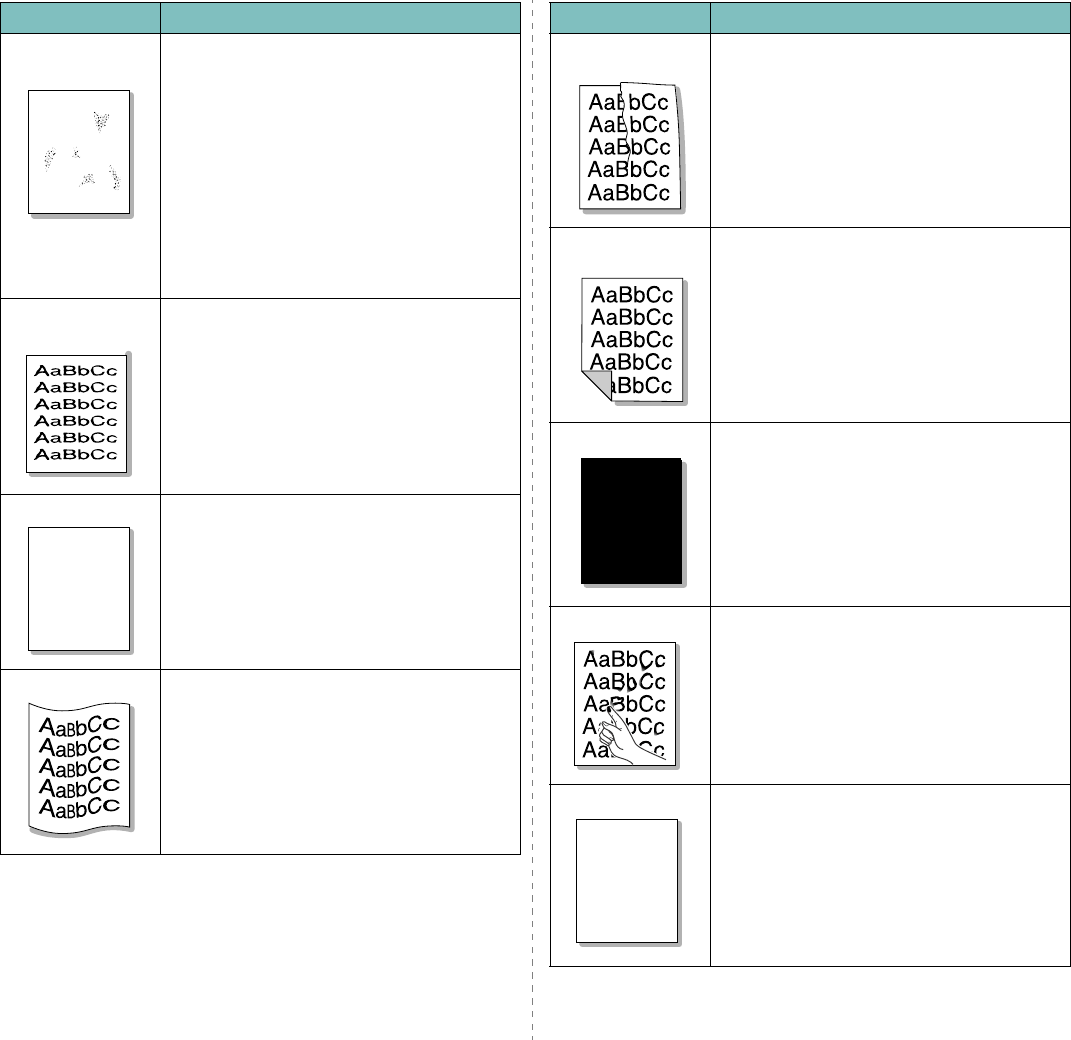
Troubleshooting
9.
8
Background
scatter
Background scatter results from bits of toner
randomly distributed on the printed page.
• The paper may be too damp. Try printing with a
different batch of paper. Do not open packages of
paper until necessary so that the paper does not
absorb too much moisture.
• If background scatter occurs on an envelope,
change the printing layout to avoid printing over
areas that have overlapping seams on the reverse
side. Printing on seams can cause problems.
• If background scatter covers the entire surface
area of a printed page, adjust the print resolution
through your software application or the printer
properties.
Misformed
characters
• If characters are improperly formed and
producing hollow images, the paper stock may be
too slick. Try a different paper. See
page 3.2
.
• If characters are improperly formed and
producing a wavy effect, the scanner unit may
need service. For service, contact a service
representative.
Page skew
• Ensure that the paper is loaded properly.
• Check the paper type and quality. See
page 3.2
.
• Ensure that the paper or other material is loaded
correctly and the guides are not too tight or too
loose against the paper stack.
Curl or wave
• Ensure that the paper is loaded properly.
• Check the paper type and quality. Both high
temperature and humidity can cause paper curl.
See
page 3.2
.
• Turn over the stack of paper in the tray. Also try
rotating the paper 180° in the tray.
• Try printing to the rear cover.
Condition Suggested solutions
A
AaBbCc
AaBbCc
AaBbCc
AaBbCc
AaBbCc
Wrinkles or
creases
• Ensure that the paper is loaded properly.
• Check the paper type and quality. See
page 3.2
.
• Turn over the stack of paper in the tray. Also try
rotating the paper 180° in the tray.
• Try printing to the rear cover.
Back of printouts
are dirty
Check for leaking toner. Clean the inside of the
machine. See page 8.1.
Black pages
• The toner cartridge may not be installed properly.
Remove the toner cartridge and reinsert it.
• The toner cartridge may be defective and need
replacing. Remove the toner cartridge and install
a new one. See page 8.4.
• The machine may require repair. Contact a service
representative.
Loose toner
• Clean the inside of the machine. See page 8.1.
• Check the paper type and quality. See
page 3.2
.
• Remove the toner cartridge and install a new one.
See page 8.4.
• If the problem persists, the machine may require
repair. Contact a service representative.
Character Voids
Character voids are white areas within parts of
characters that should be solid black:
• If you are using transparencies, try another type
of transparency. Because of the composition of
transparencies, some character voids are normal.
• You may be printing on the wrong surface of the
paper. Remove the paper and turn it around.
• The paper may not meet paper specifications. See
page 3.2
.
Condition Suggested solutions
A
A
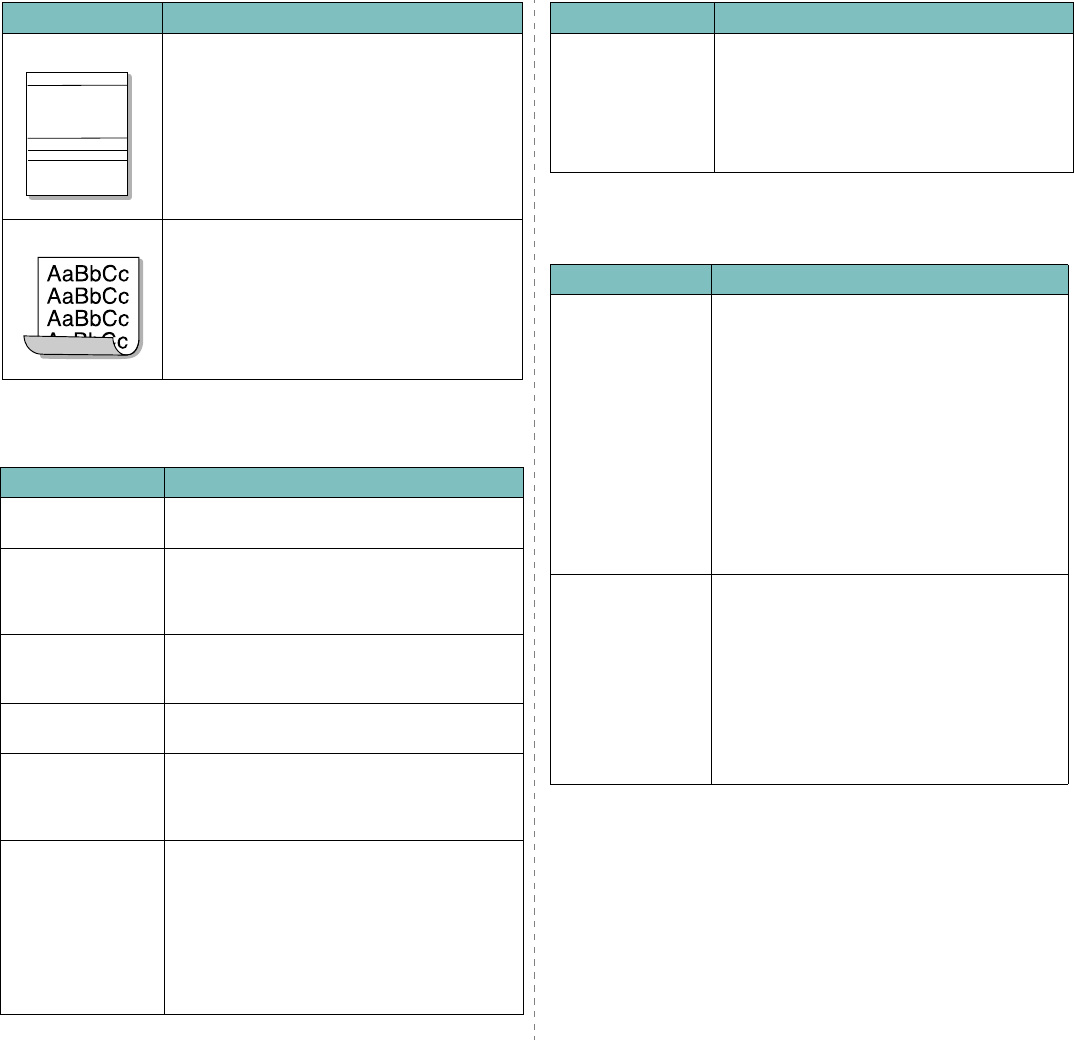
Troubleshooting
9.
9
Copying problems
Horizontal stripes
If horizontally aligned black streaks or smears
appear:
• The toner cartridge may be installed improperly.
Remove the toner cartridge and reinsert it.
• The toner cartridge may be defective. Remove the
toner cartridge and install a new one. See
page 8.4.
• If the problem persists, the machine may require
repair. Contact a service representative.
Curl
If the printed paper is curled or paper does not feed
into the machine:
• Turn over the stack of paper in the tray. Also try
rotating the paper 180° in the tray.
• Try printing to the rear cover.
Condition Suggested solutions
AaBbCc
AaBbCc
AaBbCc
AaBbCc
AaBbCc
Condition Suggested solutions
Copies are too light or
too dark.
Use
Darkness
to darken or lighten the background
of the copies.
Smears, lines, marks,
or spots appears on
copies.
• If defects are on the original, use
Darkness
to
lighten the background of your copies.
• If no defects are on the original, clean the scan
unit. See page 8.2.
Copy image is
skewed.
• Ensure that the original is face down on the
document glass.
• Check that the paper is loaded correctly.
Blank copies print
out.
Ensure that the original is face down on the
document glass.
Image rubs off the
copy easily.
• Replace the paper in the paper input tray with
paper from a new package.
• In high humidity areas, do not leave paper in the
machine for extended periods of time.
Frequent copy paper
jams occur.
• Fan the stack of paper, then turn it over in the
paper input tray. Replace the paper in the paper
input tray with a fresh supply. Check/adjust the
paper guides, if necessary.
• Ensure that the paper is the proper paper weight
75 g/m
2
(20 lb bond) paper is recommended.
• Check for copy paper or pieces of copy paper
remaining in the machine after a paper jam has
been cleared.
Scanning problems
Toner cartridge
produces fewer copies
than expected before
running out of toner.
• Your originals may contain pictures, solids, or
heavy lines. For example, your originals may be
forms, newsletters, books, or other documents
that use more toner.
• The machine may be turned on and off frequently.
• The document cover may be left open while
copies are being made.
Condition Suggested solutions
Condition Suggested solutions
The scanner does not
work.
• Make sure that you place the document to be
scanned face down on the document glass.
• There may not be enough available memory to
hold the document you want to scan. Try the
Prescan function to see if that works. Try lowering
the scan resolution rate.
• Check that the USB cable is connected properly.
• Make sure that the USB cable is not defective.
Switch the cable with a known good cable. If
necessary, replace the cable.
• Check that the scanner is configured correctly.
Check scan setting in the SmarThru Configuration
or the application you want to use to make
certain that the scanner job is being sent to the
correct port, for example, LPT1.
The unit scans very
slowly.
• Check if the machine is printing received data. If
so, scan the document after the received data
has been printed.
• Graphics are scanned more slowly than text.
• Communication speed slows in scan mode
because of the large amount of memory required
to analyze and reproduce the scanned image. Set
your computer to the ECP printer mode through
BIOS setting. It will help to increase the speed.
For details about how to set BIOS, refer to your
computer User’s Guide.
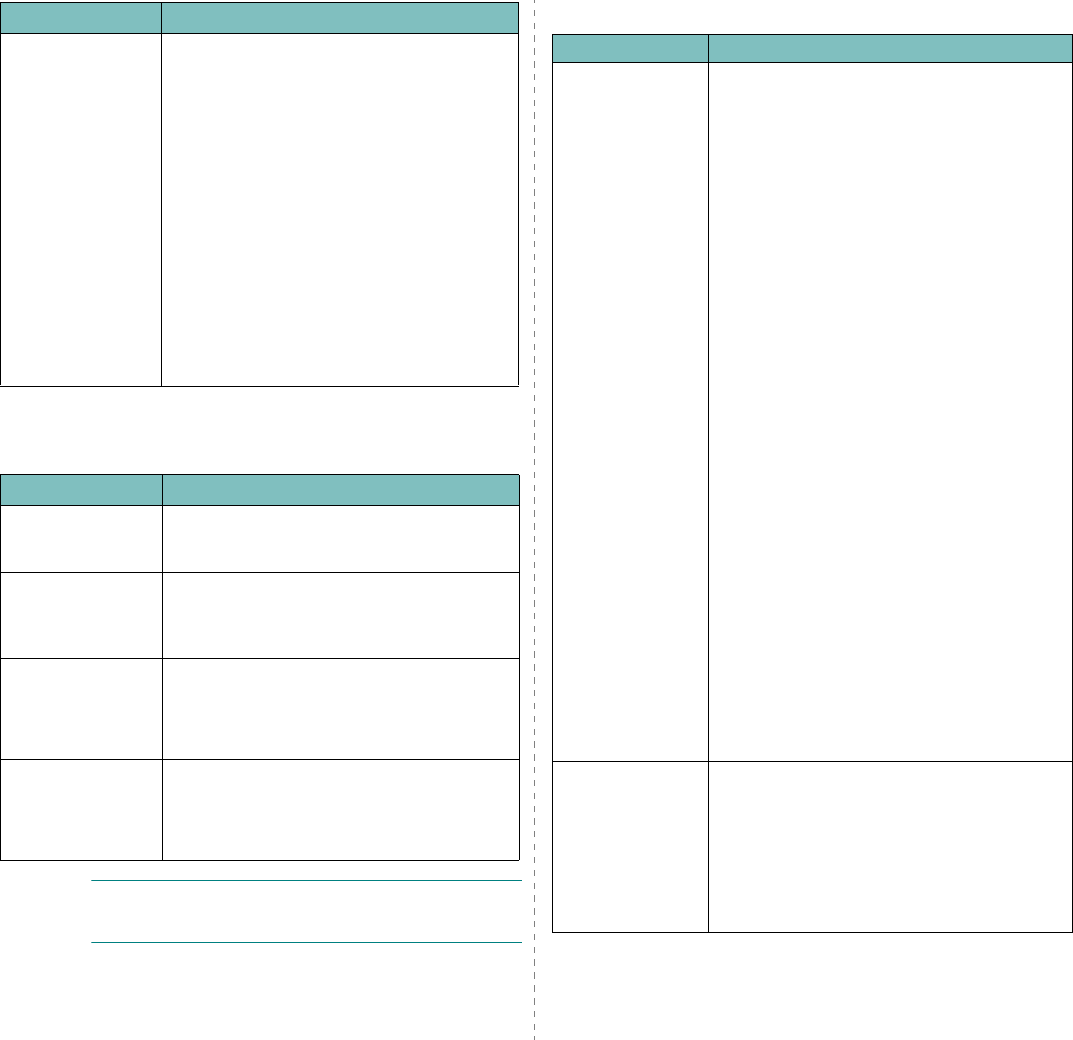
Troubleshooting
9.
10
Common windows problems
NOTE
: Refer to Microsoft Windows 98/Me/2000/XP User’s
Guide that came with your PC for further information on
Windows error messages.
Message appears on
your computer
screen:
• “Device can't be
set to the H/W
mode you want.”
• “Port is being used
by another
program.”
•“Port is disabled.”
• “Scanner is busy
receiving or
printing data.
When the current
job is completed,
try again.”
• “Invalid handle.”
• “Scanning has
failed.”
• There may be a copying or printing job in
progress. When that job is complete, try your job
again.
• The Selected port is currently being used. Restart
your computer and try again.
• The printer cable may be improperly connected or
the power may be off.
• The scanner driver is not installed or the
operating environment is not set up properly.
• Ensure that the machine is properly connected
and the power is on, Then restart your computer.
• The USB cable may be improperly connected or
the power may be off.
Condition Suggested solutions
Condition Suggested solutions
“File in Use” message
appears during
installation.
Exit all software applications. Remove all software
from the StartUp Group, then restart Windows.
Reinstall the printer driver.
“Error Writing to
LPTx” message
appears.
• Ensure that the cables are connected correctly,
the machine is on.
• If bi-directional communication is not turned on
in the driver, it will also cause this message.
“General Protection
Fault”, “Exception
OE”, “Spo ol3 2”, or
“Illegal Operation”
messages appear.
Close all other applications, reboot Windows and try
printing again.
“Fail To Print”, “A
printer timeout error
occurred.” messages
appear.
These messages may appear during printing. Just
keep waiting until the machine finishes printing. If
the message appears in standby mode or after
printing has been completed, check the connection
and/or whether an error has occurred.
Common Linux Problems
Condition Suggested solutions
The machine doesn’t
print.
• Check if the printer driver is installed in your
system. Open MFP configurator and switch to the
Printers tab in Printers configuration window to
look at the list of available printers. Make sure that
your machine is displayed on the list. If not,
please, invoke Add new printer wizard to set up
your device.
• Check if the printer is started. Open Printers
configuration and select your machine on the
printers list. Look at the description in the Selected
printer pane. If its status contains “(stopped)”
string, please, press the
Start
button. After that
normal operation of the printer should be restored.
The “stopped” status might be activated when
some problems in printing occurred. For instance,
this could be an attempt to print document when
MFP port is claimed by a scanning application.
• Check if the MFP port is not busy. Since functional
components of MFP (printer and scanner) share the
same I/O interface (MFP port), the situation of
simultaneous access of different “consumer”
application to the same MFP port is possible. To
avoid possible conflicts, only one of them at a time
is allowed to gain control over the device. The
other “consumer” will encounter “device busy”
response. You should open MFP ports configuration
and select the port assigned to your printer. In the
Selected port pane you can see if the port is
occupied by some other application. If this is the
case, you should wait for completion of the current
job or should press Release port button, if you are
sure that the present owner is not functioning
properly.
• Check if your application has special print option
such as “-oraw”. If “-oraw” is specified in the
command line parameter then remove it to print
properly. For Gimp front-end, select “print” ->
“Setup printer” and edit command line parameter
in the command item.
The machine does
not appear on the
scanners list.
• Check if your machine is attached to your
computer. Make sure that it is connected properly
via the
USB port
and is turned on.
• Check if the scanner driver for your machine is
installed in your system. Open MFP Configurator,
switch to Scanners configuration, then press
Drivers
. Make sure that driver with a name
corresponding to your machine's name is listed in
the window.

Troubleshooting
9.
11
The machine does
not appear on the
scanners list
(continued).
• Check if the MFP port is not busy. Since functional
components of MFP (printer and scanner) share the
same I/O interface (MFP port), the situation of
simultaneous access of different “consumer”
application to the same MFP port is possible. To
avoid possible conflicts, only one of them at a time
is allowed to gain control over the device. The
other “consumer” will encounter “device busy”
response. This can usually happen while starting
scan procedure, and appropriate message box
appears.
• To identify the source of the problem, you should
open MFP ports configuration and select the port
assigned to your scanner. MFP port's symbol /dev/
mfp0 corresponds to LP:0 designation displayed in
the scanners’ options, /dev/mfp1 relates to LP:1
and so on. USB ports start at /dev/mfp4, so
scanner on USB:0 relates to /dev/mfp4
respectively and so forth sequentially. In the
Selected port pane you can see if the port is
occupied by some other application. If this is the
case, you should wait for completion of the current
job or should press Release port button, if you are
sure that the present port's owner is not
functioning properly.
The machine doesn’t
scan.
• Check if a document is loaded into the machine.
• Check if your machine is connected to the
computer. Make sure if it is connected properly if I/
O error is reported while scanning.
• Check if MFP port is not busy. Since functional
components of MFP (printer and scanner) share the
same I/O interface (MFP port), the situation of
simultaneous access of different “consumer”
application to the same MFP port is possible. To
avoid possible conflicts, only one of them at a time
is allowed to gain control over the device. The
other “consumer” will encounter “device busy”
response. This can usually happen while starting
scan procedure, and appropriate message box will
be displayed.
To identify the source of the problem, you should
open MFP ports configuration and select the port
assigned to your scanner. MFP port’s symbol /dev/
mfp0 corresponds to LP:0 designation displayed in
the scanners’ options, /dev/mfp1 relates to LP:1
and so on. USB ports start at /dev/mfp4, so
scanner on USB:0 relates to /dev/mfp4
respectively and so forth sequentially. In the
Selected port pane you can see if the port is
occupied by some other application. If this is the
case, you should wait for completion of the current
job or should press Release port button, if you are
sure that the present port’s owner is not
functioning properly
.
Condition Suggested solutions
I can’t print when I
installed both Linux
Print Package (LPP)
and MFP driver on
the same machine
simultaneously.
• Since both Linux Printer Package and MFP driver
make a symbolic link to “lpr” printing command,
which is commonly used on Unix clones, it is not
recommended to use both package on the same
machine.
• If you still want to use both packages
simultaneously, please install the LPP first.
• If you want to uninstall only one of them, please
uninstall both packages and install that one you
want to use again.
• If you don’t want to uninstall MFP driver and install
it again, you may make the necessary symbolic link
yourself. Please, log in as root user and invoke the
following command:
ln -sf /usr/local/bin/samsung/slpr /usr/bin/lpr
Can’t scan via Gimp
Front-end.
• Check if Gimp Front-end has “Xsane:Device
dialog.” on the “Acquire” menu. If not, you should
install Xsane plug-in for Gimp on the your
computer. You can find Xsane plug-in package for
Gimp on Linux distribution CD or Gimp home page.
For the detail information, refer to the Help for
Linux distribution CD or Gimp Front-end
application.
If you wish to use other kind of scan application,
refer to the Help for application.
I encounter error
“Unable to open MFP
port device file!”
when printing a
document.
Please avoid changing print job parameters (via SLPR
utility, for example) while a print job is in progress.
Known versions of CUPS server break the print job
whenever print options are changed and then try to
restart the job from the beginning. Since Linux MFP
driver locks MFP port while printing, the abrupt
termination of the driver keeps the port locked and
therefore unavailable for subsequent print jobs. If
this situation occurred, please, try to release the MFP
port.
Condition Suggested solutions
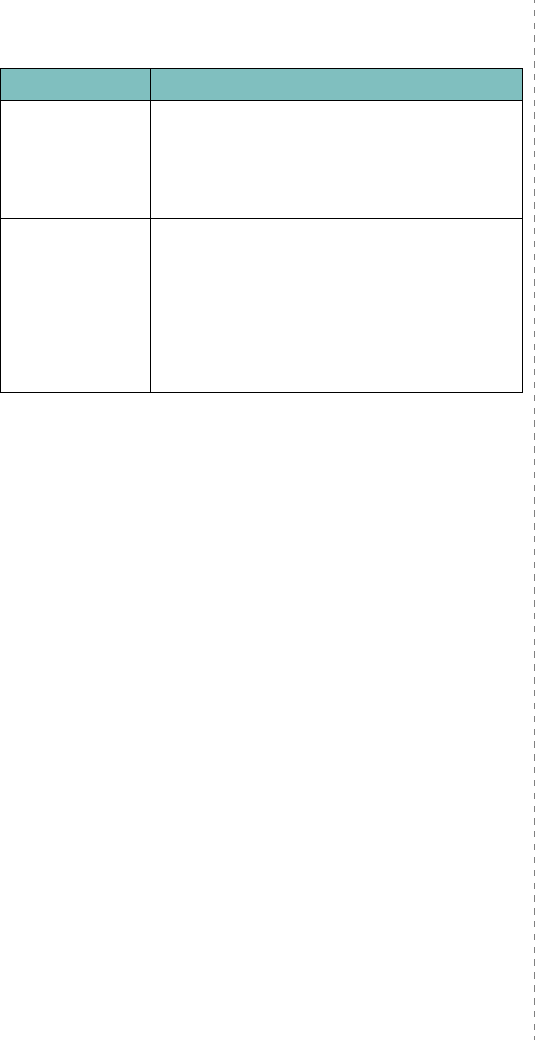
Troubleshooting
9.
12
Common macintosh problems
Problems in printer setup utility
Condition Suggested solutions
There is described
"driver not
installed" at Product
List Window after
you click Add and
Select USB.
• Software is not installed correctly. Reinstall the
software. See
Software Section
.
• Make sure that you are using a high-quality cable.
Your product not
listed at Product
List Window after
you click Add and
Select USB.
• Make sure that the cables are connected correctly
and the machine is turned on.
• Check if “Ready” appears on the display of the
control panel. If not, clear the problem depending
on the error message; see “Understanding display
messages” on page 9.4.
• Make sure that the correct printer driver has been
selected at Product List Window after you click Add
and Select USB.